Uncategorized
The Top 200 Most Famous Paintings in Art History
Embark on a visual journey through The 200 Most Famous Paintings in Art History, a captivating collection that brings together the most celebrated and recognizable artworks of all time. These iconic masterpieces, created by the greatest masters of art, have left a lasting impact on generations with their beauty, depth, and influence on global culture.
This collection features works that have transcended eras and borders. From the enigmatic faces of the Renaissance and the vibrant landscapes of the Impressionist movement to the groundbreaking abstract compositions of the 20th century, each painting tells a unique story, celebrating human creativity in all its forms.
From Leonardo da Vinci’s Mona Lisa and Van Gogh’s Sunflowers to Munch’s The Scream and Klimt’s The Kiss, these works continue to captivate millions worldwide. The 200 Most Famous Paintings in Art History invites you to rediscover these timeless icons that define our cultural and artistic heritage.

1- Almond Blossoms by Vincent van Gogh:
Painted in 1890, Almond Blossoms is one of Vincent van Gogh’s most delicate and symbolic works. Inspired by Japanese art and his deep appreciation for nature, van Gogh created this painting to celebrate the birth of his nephew, Vincent Willem, the son of his brother, Theo. The choice of the blossoming almond tree symbolizes new life, renewal, and hope—themes that were deeply significant to the artist during this period of his life.
The almond branches, adorned with delicate white blossoms, stand out against a vivid blue sky, creating a harmonious and calming contrast. The flowing lines and vibrant colors reflect the influence of Japanese prints on van Gogh’s work, which he admired for their simplicity and elegance.
Almond Blossoms is a testament to van Gogh’s passion for nature and his desire to capture the fleeting beauty of life. The painting exudes tenderness and serenity, offering a glimpse into the artist’s optimism despite the turbulence of his personal life. Now housed in the Van Gogh Museum in Amsterdam, this piece remains one of the most poignant examples of van Gogh’s creative genius.

2- The Tree of Life at the Stoclet Villa by Gustav Klimt:
Created between 1905 and 1909 for the dining room of the Stoclet Villa in Brussels, The Tree of Life is a monumental fresco that perfectly embodies Gustav Klimt’s decorative and symbolist style. This work, part of a larger set of wall mosaics commissioned by the wealthy Stoclet family, is one of Klimt’s most iconic creations, blending naturalistic motifs with the opulent aesthetic of the Vienna Secession movement.
The tree, with its spiraling branches and intricate patterns, symbolizes the connection between the earth, the sky, and the infinite. The swirling branches, richly adorned with geometric shapes, gold leaf, and vibrant details, create an atmosphere that is both mystical and ornamental. This masterpiece is a perfect example of Klimt’s fascination with the cycles of life and nature, uniting symbolism and aesthetics in a harmonious and timeless vision.
On either side of the tree, two human figures, often interpreted as allegories of love and life, complete the composition. The woman on the left, draped in warm-toned patterns, may represent The Expectation, while the embracing couple on the right symbolizes The Fulfillment or The Embrace. These figures seamlessly integrate with the ornamental style while adding an emotional dimension to the work.
An example of Klimt’s mastery in merging art with architecture, The Tree of Life at the Stoclet Villa is a celebration of beauty, luxury, and mystery—a visual testament to Klimt’s constant pursuit of harmony between humanity, nature, and the universe.
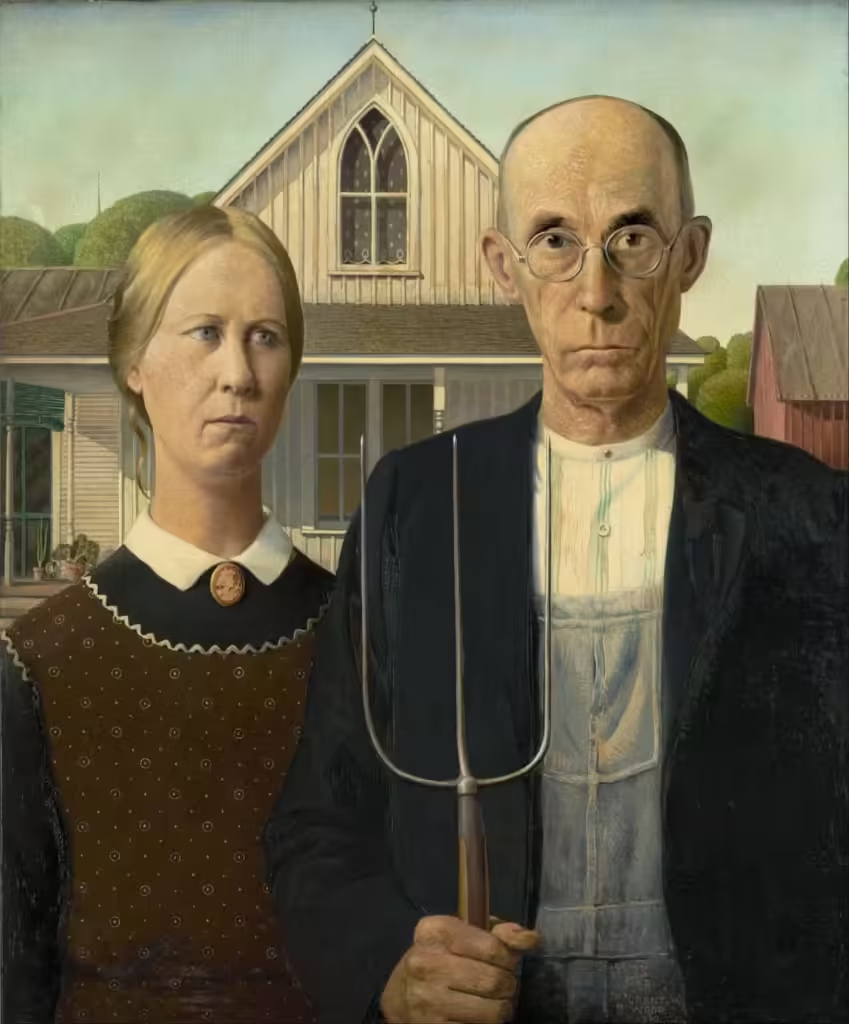
3- American Gothic by Grant Wood:
Painted in 1930 by Grant Wood, American Gothic is one of the most recognizable works in American art. This iconic painting depicts a stern farmer holding a pitchfork, standing beside a woman—often interpreted as either his daughter or wife—in front of a rural Gothic-style house in Iowa. The artwork has become a cultural symbol, representing rural American values while inspiring varied interpretations, ranging from satire to admiration for a simpler life.
The rigid realism of American Gothic contrasts with the serene yet severe expressions of the characters, enhancing the enigmatic quality of the scene. The precise details of the house, the pitchfork, and the clothing reflect the influence of the Regionalist movement, which sought to capture the essence of American life far from urban centers and industrial upheaval.
Wood drew inspiration from the Gothic architecture of the house and his observations of rural life to create a painting that is both realistic and symbolic. The piece has been widely interpreted as a subtle critique of conservative rural American values, yet it has also been seen as a celebration of the perseverance and simplicity of the farming lifestyle.
Today, American Gothic is housed at the Art Institute of Chicago and continues to influence popular culture, from advertisements to parodies, while remaining a lasting symbol of American identity in all its complexity.

4- Arrangement in Grey and Black No.1 by James Whistler:
Commonly known as Whistler’s Mother, Arrangement in Grey and Black No.1 is an iconic work painted by James Whistler in 1871. This painting is renowned not only for its subject but also for the way it showcases Whistler’s stylistic innovation and his unique approach to portraiture.
In this piece, Whistler portrays his mother, Anna McNeill Whistler, seated in a chair, dressed in dark, modest clothing, against a background of soft grey and black tones. The composition is notable for its elegant simplicity and subtle use of shades of grey, creating an atmosphere of calm and dignity.
The painting reflects the influence of the Aesthetic movement, of which Whistler was a strong advocate. This movement emphasized the importance of visual beauty and color harmony over traditional narrative or symbolic conventions. Whistler employed clean lines and refined forms to highlight the serenity and presence of his mother, while focusing on the unity and balance of the composition.
Now housed in the National Gallery in London, Arrangement in Grey and Black No.1 remains a prime example of Whistler’s ability to merge technical skill with personal expression, bringing out the simplicity and depth of the subject.

5- Lady Godiva by John Collier:
Painted in 1898 by John Collier, Lady Godiva is a captivating work that illustrates one of the most famous legends in British folklore. The painting depicts the iconic figure of Lady Godiva, an 11th-century Anglo-Saxon noblewoman known for her legendary ride through Coventry, bare on horseback, to relieve her people of the heavy taxes imposed by her husband.
In this artwork, Collier captures the dramatic and heroic moment of the ride. Lady Godiva is portrayed in a noble and majestic pose, riding a white horse while being modestly covered by her flowing hair. The scene is enriched with elaborate details that enhance the historical and symbolic nature of the event. The background is adorned with Gothic architectural elements, evoking the medieval context of the story.
Collier’s style, characterized by meticulous realism and refined use of color, creates an atmosphere that is both dramatic and romantic. Lady Godiva exemplifies how late 19th-century art explored and celebrated historical and legendary narratives, highlighting themes of bravery and personal sacrifice.
Today, the painting is part of the collection at the Tate Gallery in London. It remains a powerful and visually stunning representation of the Lady Godiva legend, as well as a testament to John Collier’s artistic mastery.
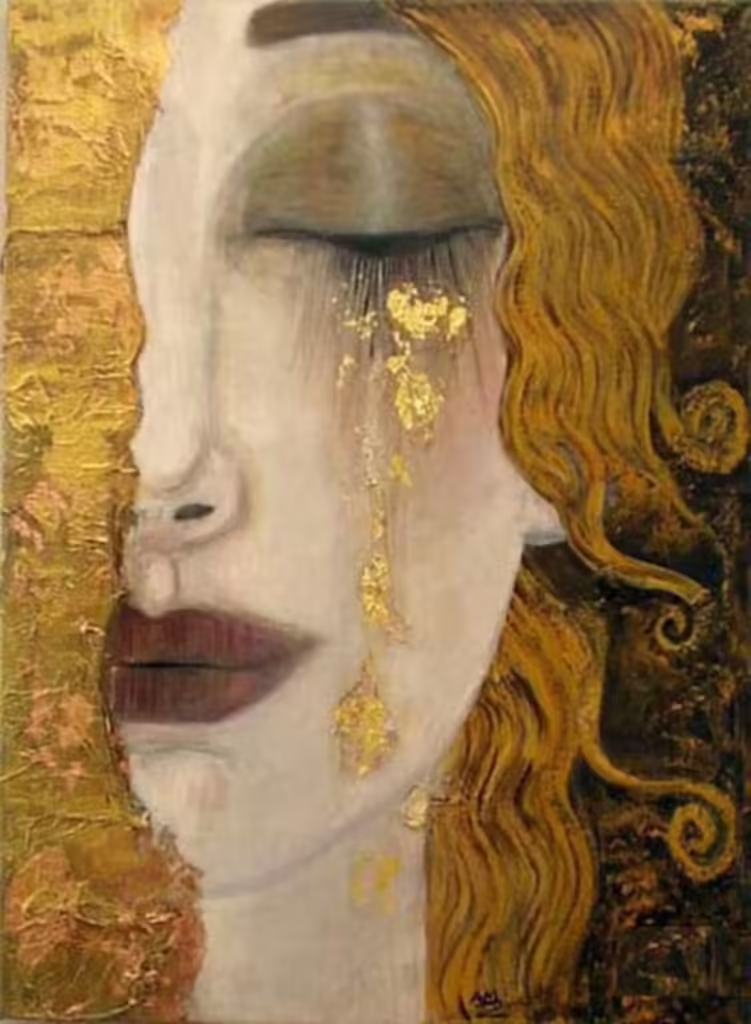
6- Golden Tears by Gustav Klimt:
Golden Tears, painted by Gustav Klimt in 1909, is an iconic work that belongs to the series of decorative paintings created during the peak of his career. This painting is often admired for its ornamental richness and its exploration of themes such as beauty and despair.
In Golden Tears, Klimt depicts a close-up of a woman’s face, framed by golden motifs and intricate details characteristic of his style. The subject is a woman shedding tears, with golden drops running down her face. These tears are rendered with a shimmering light effect, contrasting with the depth of emotions expressed by the woman.
The composition is typical of Klimt’s decorative approach, employing complex patterns and gold elements to create a visually rich and emotionally powerful texture. The ornate background, stylized details, and the use of gold emphasize the importance of aesthetics and symbolism in the work.
Golden Tears showcases Klimt’s mastery in blending emotional and decorative aspects in his art, reflecting recurring themes of beauty, suffering, and human resilience. This painting continues to captivate art lovers and scholars alike, standing as a remarkable example of how Klimt fused art and symbolism to create works that resonate deeply both visually and emotionally.

7- The Kiss by Francesco Hayez:
The Kiss, painted by Francesco Hayez in 1859, is one of the most famous works of Italian Romanticism. Created on the eve of Italy’s unification, this painting is a passionate and iconic representation of love and patriotism.
The artwork captures an intimate moment between two lovers locked in a fervent kiss, wrapped in richly colored garments. The couple is immersed in a fiery embrace, while the background reveals dramatic elements, such as a torn banner and a blurred landscape. The characters’ clothing is adorned with intricate details and vibrant colors, adding to the visual richness of the scene.
The painting is often interpreted as an allegory of Italy’s struggle for unity, where the kiss symbolizes not only personal love but also the passion for the homeland and the hope for a unified future. The figures are depicted with emotional intensity and dramatic dynamism, capturing the spirit of Romanticism.
The Kiss is housed at the Pinacoteca di Brera in Milan. This work remains a powerful symbol of 19th-century Italian Romanticism and culture, continuing to captivate audiences with its vibrant expression of love and patriotism.

8- The Birth of Venus by William Bouguereau
The Birth of Venus, painted in 1879 by William Bouguereau, is a masterful example of Neoclassicism that showcases the artist’s skill in realism and idealized beauty. This painting depicts the mythological moment when the goddess Venus, born from the sea, emerges in all her splendor, surrounded by the sea and natural elements.
In this composition, Bouguereau presents Venus standing on a giant shell, with the sea rising around her with delicate fluidity. Her beauty and grace are highlighted by a skin that is almost translucent, while her golden hair and flowing drapery enhance the sense of movement and lightness. The meticulous details of the waves, water bubbles, and pearls underscore Bouguereau’s technical mastery.
The painting is distinguished by its realistic rendering and refined elegance, characteristic of Bouguereau’s style. It captures the essence of the Venus myth with classical sensuality and technical precision, emphasizing the idealized beauty and purity of the subject.
The Birth of Venus is often celebrated for its delicate interpretation of the classical myth and its ability to blend artistic technique with an idealized vision of divine beauty. This work is housed at the Musée d’Orsay in Paris, where it continues to captivate visitors with its sublime representation of mythological love and beauty.
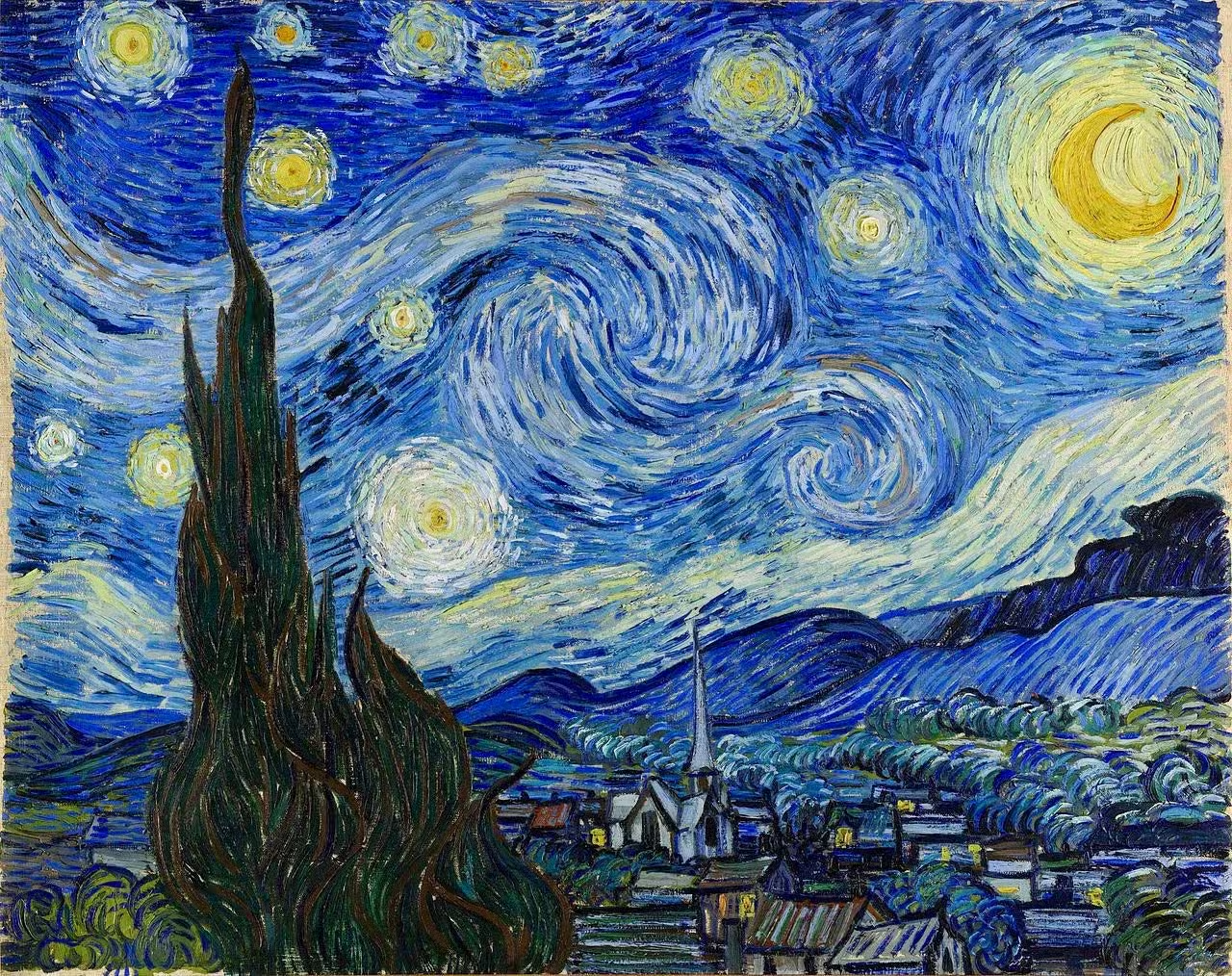
9- The Starry Night by Vincent van Gogh
The Starry Night, painted by Vincent van Gogh in 1889, is one of the most iconic and recognizable works of Post-Impressionism. This painting depicts the view from Van Gogh’s asylum room at Saint-Rémy-de-Provence, transformed by the artist’s vibrant and swirling imagination.
In The Starry Night, Van Gogh captures a tumultuous night sky, with bright stars and a glowing moon dominating the scene. The swirling clouds and waves of light crossing the sky create a dynamic and almost hypnotic effect. The composition is contrasted by a serene landscape below, with rolling hills and a peaceful village, juxtaposing the frenetic movement of the sky.
Van Gogh’s characteristic brushwork, with its bold and textured strokes, imparts a sense of movement and energy to the painting. The vivid, contrasting colors and the emotional depiction of the nocturnal scene illustrate Van Gogh’s ability to merge reality with dream.
The Starry Night is currently housed at the Museum of Modern Art (MoMA) in New York. This painting is a powerful example of Van Gogh’s distinctive style and his skill in expressing emotional depth through art, offering a unique and timeless vision of nocturnal beauty.

10- The Magpie by Claude Monet
The Magpie, painted by Claude Monet between 1868 and 1869, is a remarkable work that captures the winter beauty through the lens of Impressionism. This painting is one of Monet’s early examples of his technique for depicting light and the subtleties of nature.
In The Magpie, Monet portrays a snowy landscape with a magpie perched on a wooden fence in a field. The painting is dominated by white and blue tones that evoke the freshness and tranquility of winter. The soft, diffused light creates interplay between shadow and light on the snow, enhancing the texture and depth of the landscape.
The composition is notable for its innovative use of color and form. The magpie, though small relative to the vastness of the landscape, becomes a focal point of the scene, while the broken wooden fence stretches across the painting, adding a sense of perspective and depth.
The Magpie exemplifies Monet’s approach to capturing fleeting moments in nature with meticulous attention to the effects of light. This work is displayed at the Musée d’Orsay in Paris and continues to be admired for its elegant representation of winter beauty and its influence on the development of the Impressionist movement.

11- The Birth of Venus by Sandro Botticelli
The Birth of Venus, painted by Sandro Botticelli around 1484-1486, is a masterpiece of the Italian Renaissance that illustrates the mythological birth of the goddess Venus, emerging from the sea foam. This painting is renowned for its idealized beauty, elegant composition, and influence on Renaissance art.
In The Birth of Venus, Botticelli depicts Venus standing on a giant shell, emerging from the ocean waves. She is surrounded by mythological figures, including the Three Graces to the left and the wind god Zephyr with his companion Chloris to the right. The painting is distinguished by its harmonious composition and flowing lines, which highlight the grace and beauty of the goddess.
Venus is portrayed with idealized forms and a delicate posture, embodying serenity and majesty. The colors are rich and nuanced, contributing to a dreamlike and mysterious atmosphere. The ornate details of the shell and the floral motifs add to the elegance of the scene.
The Birth of Venus is housed at the Uffizi Gallery in Florence. This painting is a quintessential example of the Renaissance revival of classical themes, as well as a celebration of beauty and harmony embodied in the figure of Venus.

12- The Birth of Venus by Alexandre Cabanel
The Birth of Venus, painted by Alexandre Cabanel in 1863, is a masterpiece of 19th-century academic style, illustrating classical mythology with a romantic and sensual touch. This work is often admired for its elegant and idealized representation of the goddess Venus, born from the sea foam.
In this painting, Cabanel depicts Venus reclining on a bed of foam, surrounded by seashells and waves. Her pose is graceful and voluptuous, with meticulous details that enhance the sensuality of the figure. Venus’s face is serene and ethereal, while her golden hair and delicate forms are rendered with precision and softness, showcasing Cabanel’s technical mastery.
The painting is characterized by its rich colors and soft light, creating a romantic and divine atmosphere. The background elements, such as the waves and shells, are painted with detailed realism, contrasting with the more stylized and idealized quality of Venus’s figure.
The Birth of Venus by Cabanel is housed at the Musée d’Orsay in Paris. This work is an iconic example of 19th-century academic art, celebrating classical beauty through refined technique and a romantic treatment of the mythological subject.

13- Death and Life by Gustav Klimt
Death and Life, painted by Gustav Klimt between 1908 and 1915, is a monumental and complex work that contrasts mortality and life, highlighting themes of human fragility and immortality. This painting is often considered one of Klimt’s masterpieces, offering rich symbolism and refined aesthetics.
The painting is divided into two main parts. On the left, Klimt depicts Death as a dark and imposing figure surrounded by symbols of decay and despair. Death is portrayed as a tormented silhouette, wrapped in ornamental patterns and macabre symbols.
On the right, in a striking contrast, Life is represented in a vibrant and lush composition. This section features a group of human figures, including women, children, and embracing couples, symbolizing the diversity and richness of human life. The characters are surrounded by floral motifs and dazzling colors, creating a dramatic contrast with the dark side of the painting.
Death and Life visually explores the duality between existence and extinction, treated with Klimt’s signature aesthetic that blends ornamentation and symbolism. This work is a fascinating example of how Klimt uses color, form, and pattern to express universal and timeless themes.
The painting is housed at the Belvedere Museum in Vienna, where it continues to captivate visitors with its visual richness and emotional depth.

14- The Noon Rest by Vincent van Gogh
The Noon Rest, painted by Vincent van Gogh in 1890, captures a moment of tranquility and contemplation under a summer sky, showcasing Van Gogh’s mastery in representing landscapes and moments of repose.
In this painting, Van Gogh depicts a sunlit field where a human figure, often interpreted as a farmer or laborer, is lying in a restful position. The scene is bathed in a golden light, typical of the warmth and brightness of summer. The figure is rendered in a simple and direct manner, contrasting with the dynamic colors and shapes of the surrounding landscape.
The painting stands out for Van Gogh’s bold use of color and characteristic brushstrokes. The fields are painted with touches of yellow and green that capture the richness and texture of nature, while the sky is vibrant with blue and gold, adding to the sense of warmth and calm.
The Noon Rest is a poignant representation of peace and rest in rural life, and an example of Van Gogh’s ability to transform simple moments into intense visual experiences. The painting also highlights the influence of light and color on emotion and perception in Van Gogh’s work.
Today, The Noon Rest is housed at the Van Gogh Museum in Amsterdam, where it continues to attract art lovers with its vibrant portrayal of daily life and natural beauty.
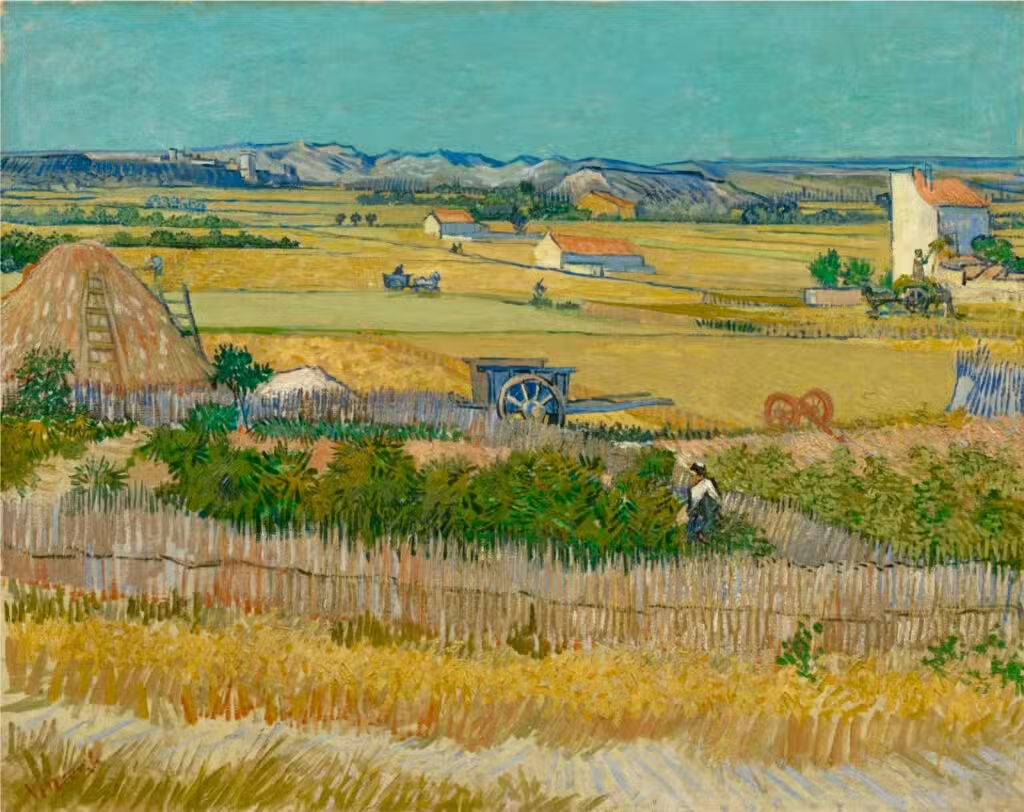
15- The Harvest at La Crau by Vincent van Gogh
The Harvest at La Crau, painted by Vincent van Gogh in 1888, is a vibrant and expressive work that captures agricultural activity in the Crau plain, an arid region near Arles where Van Gogh was residing at the time. This painting is an exemplary representation of Van Gogh’s post-impressionist style, highlighting his fascination with nature and rural life.
In this painting, Van Gogh depicts workers harvesting wheat in a field, using warm colors and dynamic brushstrokes that convey the energy and effort of agricultural labor. The scene is bathed in a golden light typical of summer days, with the intense blue sky contrasting with the golden tones of the fields.
The human figures, although stylized and simplified, add a sense of movement and life to the composition. The undulating lines of the fields and the geometric shapes of the haystacks contribute to a rhythmic and harmonious composition.
The Harvest at La Crau demonstrates Van Gogh’s ability to capture the essence of rural life through vivid colors and expressive texture. The painting also reflects the artist’s interest in natural cycles and manual labor, showcasing his talent for transforming everyday scenes into dynamic visual experiences.
Today, this painting is housed at the Musée d’Orsay in Paris, where it continues to attract art enthusiasts for its unique treatment of light and color, as well as its lively representation of agricultural life.
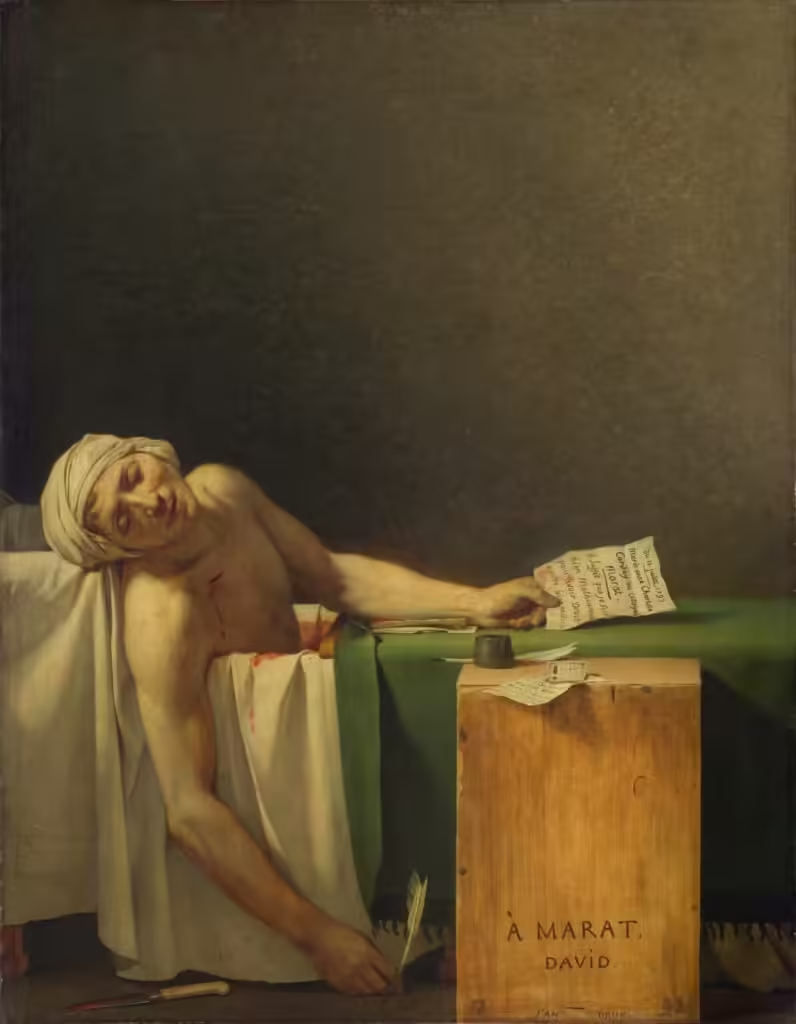
16- The Death of Marat by Jacques-Louis David
The Death of Marat, painted by Jacques-Louis David in 1793, is a quintessential example of neoclassical art and a poignant testimony to the French Revolution. This dramatic painting depicts the assassination of Jean-Paul Marat, a prominent revolutionary figure, in his bathtub, where he was killed by Charlotte Corday.
In this painting, David captures the tragic moment with meticulous precision and emotional intensity. Marat is shown in his bathtub, still lively in his final moments, with visible bloodstains on the wall and floor. The scene is marked by a strong contrast between the whiteness of the bathtub and the deep darkness of the background, emphasizing the dramatization of the murder.
Marat’s face is serene, almost heroic, despite the brutality of the act. David uses dark colors and dramatic lighting to highlight the violence of the event and the tragic figure of the martyr. Elements such as Marat’s note, the knife, and the way his body is slightly slouched add to the visual impact of the scene.
The Death of Marat is often interpreted as revolutionary propaganda, highlighting Marat’s sacrifice for the republican cause. This painting is considered one of the pinnacles of neoclassicism and historical painting, and it is housed at the Musée du Louvre in Paris.
Through The Death of Marat, Jacques-Louis David created a work that is both heroic and tragic, immortalizing a key moment in revolutionary history with remarkable technical mastery and emotional intensity.
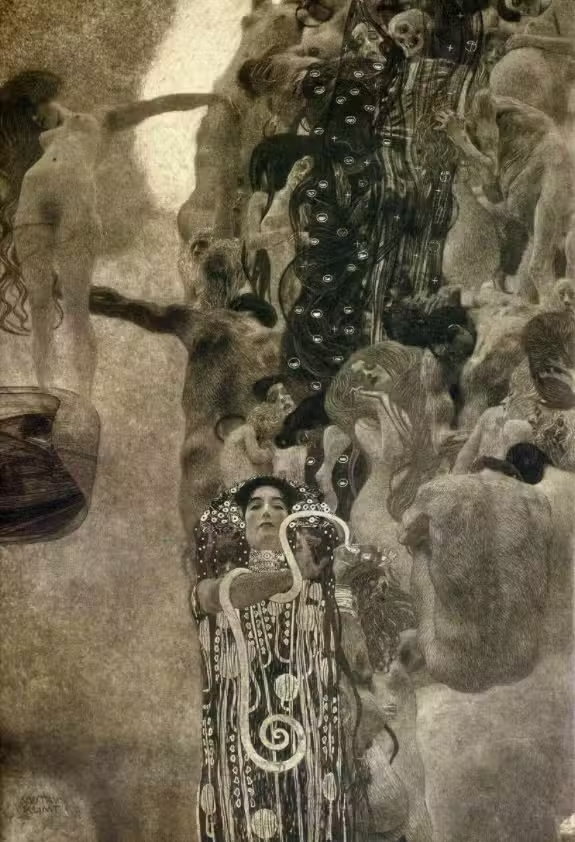
17- Medicine by Gustav Klimt
Medicine, painted by Gustav Klimt between 1900 and 1907, is part of the important series of frescoes created for the ceiling of the University of Vienna, commissioned to celebrate advancements in medicine and science. This painting is a striking example of how Klimt integrated elements of symbolism and decorative art into his work.
In Medicine, Klimt represents the personification of medicine as a central female figure, surrounded by a variety of symbolic motifs and allegorical figures. The goddess of medicine, Hygeia, is depicted with great elegance, adorned in richly decorated robes and surrounded by floral and geometric patterns characteristic of Klimt’s style.
The painting is notable for its bold use of gold and vibrant colors, as well as its complex patterns and stylized forms. Decorative elements, such as snakes and medical symbols, are incorporated into the composition in a way that enhances the beauty and depth of the subject.
Medicine is one of three major panels Klimt created for the University of Vienna, alongside Philosophy and Jurisprudence, each addressing a different aspect of human knowledge and culture. This painting is housed at the University of Vienna and remains an emblematic example of Klimt’s fusion of symbolist art with a decorative and allegorical vision.
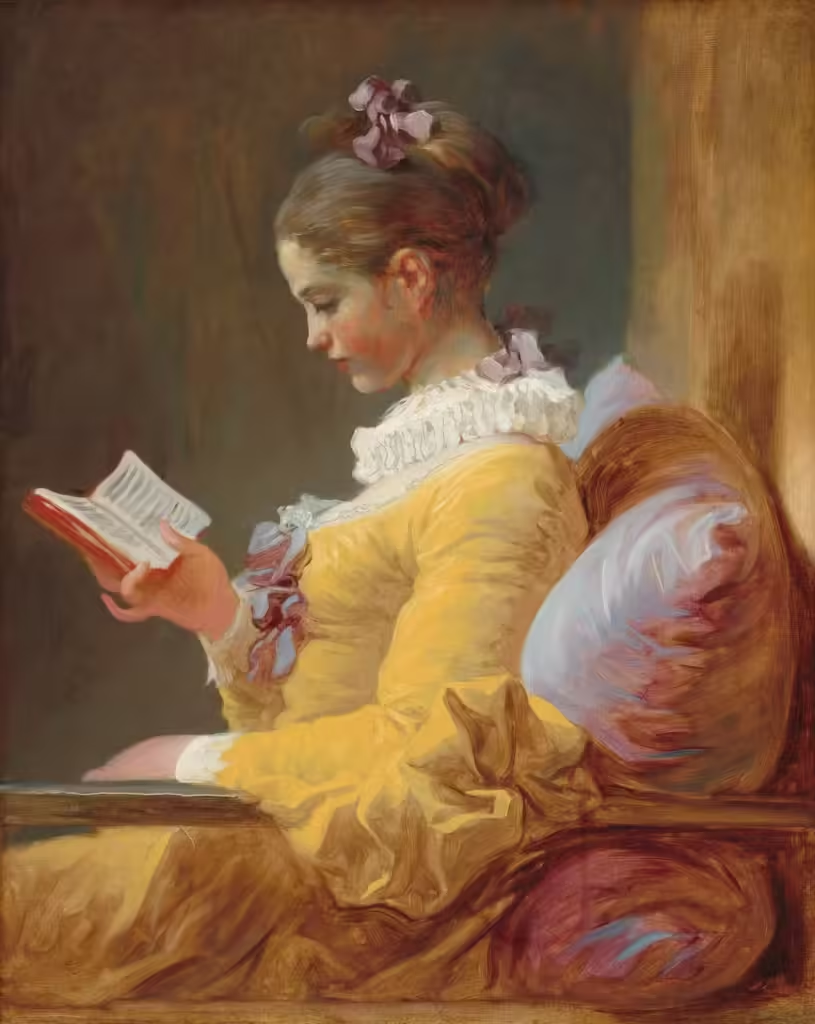
18- The Reader by Jean-Honoré Fragonard
The Reader, painted by Jean-Honoré Fragonard around 1770, is an emblematic example of the Rococo style, characterized by its elegance and delicate charm. This painting showcases Fragonard’s mastery in capturing intimate and refined moments with a touch of sensuality and lightness.
In this painting, a young woman is depicted reading a book with serene concentration. She is seated in a richly decorated interior, surrounded by sumptuous fabrics and ornamental details typical of the Rococo style. The soft light illuminating the scene highlights the luxurious textures of her clothing and accessories.
The reader’s face is calm and expressive, reflecting contemplative concentration and a certain elegance. The composition is balanced with a subtle use of pastel colors and fluid shapes, creating an atmosphere of calm and refinement.
The Reader is a perfect example of Fragonard’s ability to capture the beauty and intimacy of everyday scenes, while emphasizing the elegant and ornate style of Rococo. The painting is often admired for its delicate treatment of the subject and its atmosphere of softness and sophistication.
The Reader is housed at the Hermitage Museum in St. Petersburg, where it continues to captivate visitors with its charming and refined depiction of reading as a moment of tranquility and beauty.

19- Mona Lisa by Leonardo da Vinci
Mona Lisa, painted by Leonardo da Vinci between 1503 and 1506, is arguably the most famous and recognizable artwork in the world. This portrait, also known as La Joconde, is a quintessential masterpiece of the Italian Renaissance and a perfect example of Leonardo da Vinci’s art.
The painting depicts Lisa Gherardini, a Florentine woman, in a half-length portrait. She is seated against a mysterious and misty landscape that appears to stretch infinitely behind her. The composition is remarkable for its delicacy and attention to detail, especially in the rendering of textures and expressions.
The Mona Lisa’s smile is one of the most famous and enigmatic aspects of the painting. It seems to change and evolve depending on the angle and light, adding a nearly lifelike quality to the portrait. Her eyes have also been carefully painted to follow the viewer, enhancing the sense of personal connection with the artwork.
Mona Lisa is renowned for its use of sfumato, a painting technique that creates smooth transitions between colors and shadows, giving the portrait a sense of depth and realism. The painting is housed at the Louvre Museum in Paris and attracts millions of visitors each year, captivated by its mystery, beauty, and historical significance.
Through Mona Lisa, Leonardo da Vinci captured not only external beauty but also emotional intimacy and complexity, making this portrait an enduring icon of art and culture.

20- Liberty Leading the People by Eugène Delacroix
Liberty Leading the People, painted by Eugène Delacroix in 1830, is a masterpiece of Romanticism and a powerful symbol of the July Revolution in France. This iconic work captures the revolutionary spirit and tumultuous energy of popular movements.
The painting depicts an allegory of Liberty in the form of a female figure, Marianne, leading an insurgent crowd through the barricades. Marianne is portrayed as the central figure, heroically waving the French tricolor flag, while the crowd behind her includes fighters, workers, and soldiers, illustrating the diversity of revolution participants.
The composition is dynamic and expressive, featuring bold use of color and contrast. The forms and expressions of the figures are charged with movement and passion, capturing the intensity of the moment. Details such as torn clothing and determined expressions of the characters add to the atmosphere of chaos and courage.
Liberty Leading the People is often regarded as a piece of political propaganda, exalting the ideals of liberty and fraternity while emphasizing the Romantic spirit, which celebrated the individual and passion. This painting is housed at the Louvre Museum in Paris and remains a powerful symbol of the struggle for freedom and republican ideals.
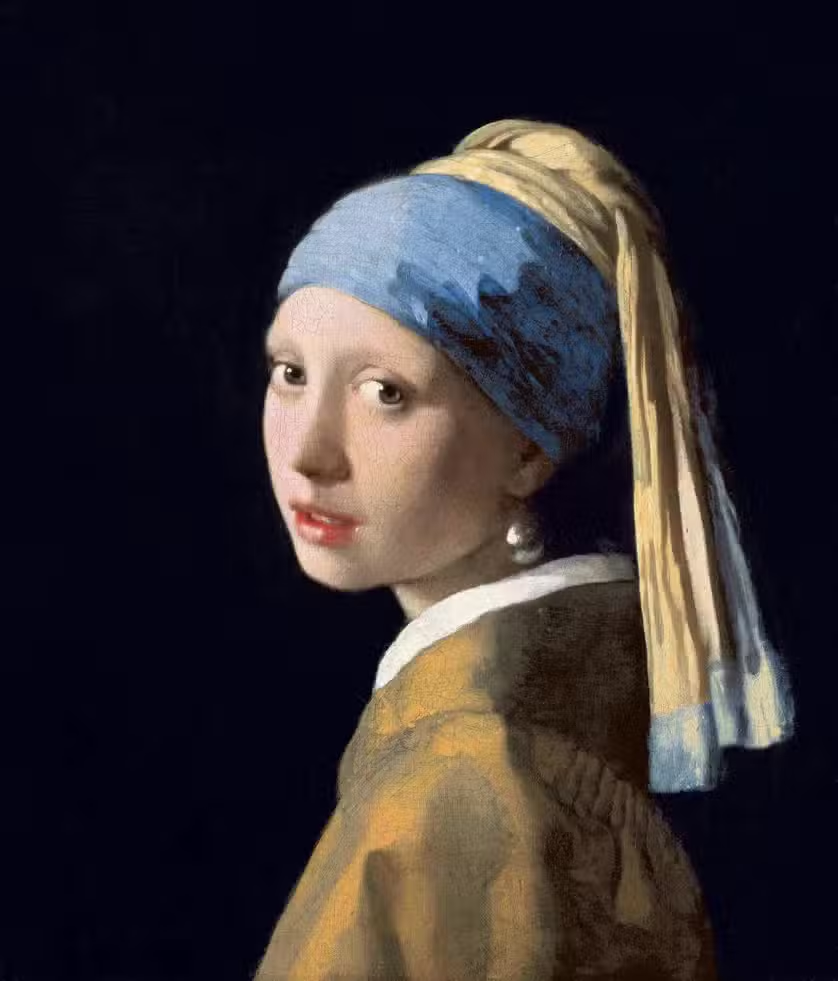
21- Girl with a Pearl Earring by Johannes Vermeer
Girl with a Pearl Earring, painted by Johannes Vermeer around 1665, is one of the most famous and iconic works of the Dutch Golden Age. Often referred to as the “Mona Lisa of the North,” this painting is renowned for its delicate realism and intimate portrait.
The painting depicts a young woman wearing an exotic turban and a large pearl earring. The dark, uniform background highlights her luminous face and the subtle details of her expression, while the soft light illuminating her face creates a sense of depth and volume. The girl’s direct and captivating gaze establishes a visual connection with the viewer.
Vermeer employs a chiaroscuro technique to accentuate the contours and details of the face, as well as a meticulous treatment of textures and reflections, particularly on the pearl and the turban. The simplicity of the composition contrasts with the richness of the details, contributing to the portrait’s elegance and intimacy.
Girl with a Pearl Earring is housed at the Mauritshuis in The Hague, Netherlands. This painting is often celebrated for its timeless beauty and the sublime quality of Vermeer’s technique, representing a perfect fusion of portrait art and technical mastery.

22- The Great Odalisque by Jean-Auguste-Dominique Ingres
The Great Odalisque, painted by Jean-Auguste-Dominique Ingres in 1814, is a masterpiece of Neoclassicism that embodies the exoticism and sensuality of the early 19th century. The painting is renowned for its elegant and idealized depiction of the female form and its richly detailed composition.
In this work, Ingres depicts an odalisque, or a woman from an Oriental harem, reclining on an ornate divan in a languid and seductive pose. The figure is rendered with impeccable precision, showcasing fluid lines and idealized forms. The proportions of the woman are stylized, with an elongated body and exaggerated curves that emphasize her sensuality and exotic allure.
The background of the painting is adorned with Oriental fabrics and motifs, creating an atmosphere of luxury and opulence. The meticulous details of the drapery, jewelry, and textures enhance the visual richness of the scene. The soft light illuminating the figure contributes to a sense of depth and volume, highlighting the smooth skin and delicate details.
The Great Odalisque is housed at the Louvre Museum in Paris. The painting is often admired for its technical mastery, its idealized representation of the female body, and its ability to capture the Oriental fantasy in 19th-century European art

23- The Lacemaker by Johannes Vermeer
The Lacemaker, painted by Johannes Vermeer around 1669-1670, is a quintessential work of the Dutch Golden Age, celebrated for its intimate and detailed portrayal of domestic life. This painting exemplifies Vermeer’s exceptional skill in capturing everyday moments with remarkable finesse.
The painting depicts a young woman seated at a table, engaged in the delicate task of making lace. She is dressed in a simple yet elegant outfit, with her focus deeply concentrated on her work, creating a scene filled with tranquility and concentration. The soft light falling on her and her work highlights the intricate textures of the lace and the refined details of her attire.
The background of the painting consists of a dark-colored wall and a few objects, creating a subtle contrast with the main subject and enhancing the clarity and luminosity of the young woman’s face and hands. Vermeer’s use of chiaroscuro accentuates depth and texture, while reflected light adds richness to the scene.
The Lacemaker is housed at the Louvre Museum in Paris. The painting is often admired for its delicate representation of domestic life and its meticulous attention to detail, showcasing Vermeer’s talent for capturing beauty and tranquility in the simple moments of daily life.

24- The Dance of Mérion by Henri Matisse
The Dance of Mérion, painted by Henri Matisse in 1909, is a remarkable work that embodies the vibrant energy and bold style of Fauvism. This painting is one of Matisse’s masterpieces and illustrates his exploration of color and movement.
In The Dance of Mérion, Matisse depicts a group of human figures dancing in a circle, executing fluid and dynamic movements. The figures, simplified and stylized, are rendered with vivid colors and clear contours, highlighting their energy and motion. The painting is characterized by expressive brushstrokes and a bold color palette that create a sense of rhythm and vitality.
The background of the painting features solid tones that contrast with the dancing figures, accentuating the impression of movement and fluidity. The circular composition of the dancers, along with their arrangement in space, contributes to a visual harmony and group dynamics that capture the spirit of Fauvism.
The Dance of Mérion is often praised for its innovative approach to color and form, as well as its ability to convey movement and joy through abstract and expressive shapes. This painting is housed at the Museum of Modern Art in Paris and remains an iconic example of Matisse’s bold and vibrant style.

25- The Lady of Shalott by John William Waterhouse
The Lady of Shalott, painted by John William Waterhouse in 1888, is an iconic example of Pre-Raphaelite art, a 19th-century movement that sought to return to medieval styles and themes with a romantic touch.
The painting is inspired by Lord Alfred Tennyson’s poem of the same name, which tells the tragic story of the Lady of Shalott, a mythical figure imprisoned in a tower and condemned to weave a tapestry while never looking at the outside world. In Waterhouse’s depiction, the Lady is shown at the end of her life, leaving her tower to float down the river to her death.
The composition depicts the Lady of Shalott in a flower-adorned boat, drifting along a river. She is dressed in a richly decorated gown and holds flowers in her hands, adding to the melancholic and dreamlike atmosphere of the scene. The background features a pastoral landscape with trees and hills, contrasting the serene beauty of the setting with the figure’s tragic fate.
Waterhouse’s use of vivid colors, intricate details, and soft lighting enhances the romantic and dramatic quality of the painting. The Lady of Shalott is portrayed with a serene yet resigned expression, emphasizing the themes of fate and sacrifice.
The Lady of Shalott is housed at the Tate Gallery in London and is widely admired for its poignant and richly detailed representation of the medieval legend, as well as the technical mastery and emotion it conveys.
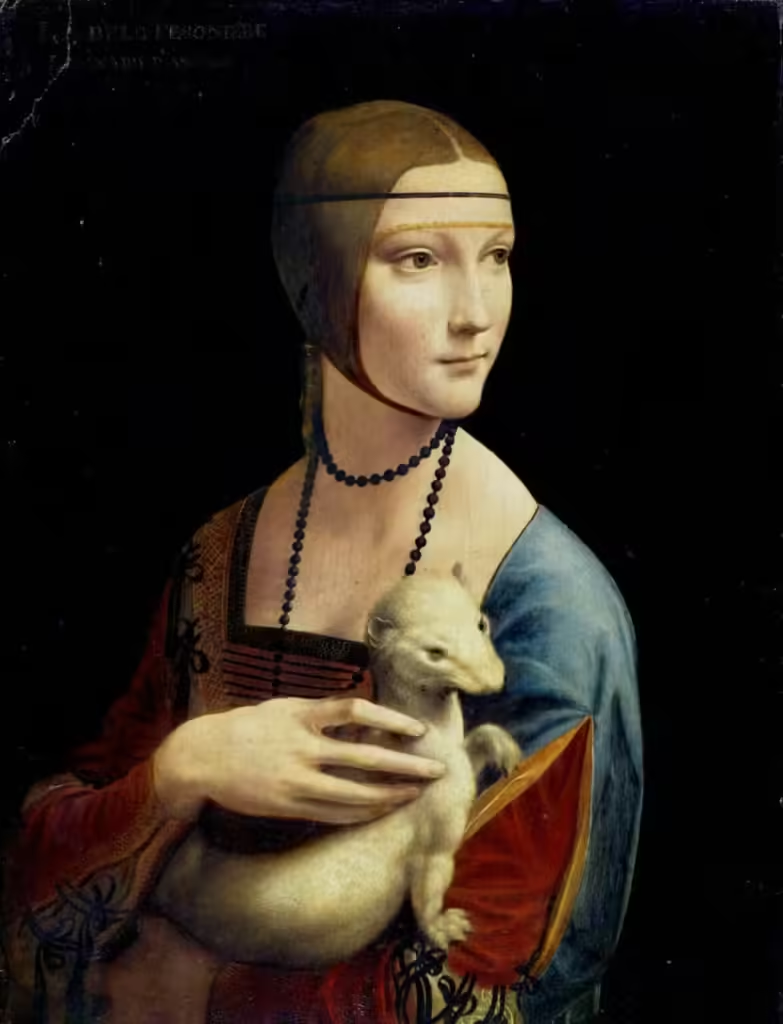
26- The Lady with an Ermine by Leonardo da Vinci
The Lady with an Ermine, painted by Leonardo da Vinci around 1489-1490, is an iconic Renaissance portrait and one of the artist’s masterpieces. The painting depicts Cecilia Gallerani, a young woman of Milanese nobility, and is renowned for its elegance and refinement.
In this portrait, Cecilia Gallerani is shown holding an ermine, an animal that symbolized purity and nobility during the period. The painting features a half-length portrait with Cecilia’s direct gaze and gentle expression capturing the essence and personality of the subject. Her attire is richly detailed, with delicate textures that highlight Leonardo’s technical mastery.
The background of the painting is dark and neutral, emphasizing the central figure and allowing the light to focus on the details of Cecilia’s face and garment. The ermine in her hands is depicted with great precision, adding complexity and interest to the portrait.
The Lady with an Ermine is housed at the Czartoryski Museum in Kraków, Poland. The portrait is admired for its technical quality, innovative use of light and shadow, and its ability to capture the subject’s dignity and personality. The work also showcases Leonardo da Vinci’s skill in realistic depiction of textures and details.

27- Dance at Bougival by Pierre-Auguste Renoir
Dance at Bougival, painted by Pierre-Auguste Renoir in 1883, is a masterpiece of the Impressionist movement that captures the joy and vitality of popular dances of the time. This painting is renowned for its lively and festive portrayal of an outdoor dance scene.
The painting depicts a couple dancing in a vibrant garden in Bougival, a suburb near Paris known for its recreational and entertainment activities in the 19th century. Renoir captures the fluid movement and energy of the dancers with swift and dynamic brushstrokes. The figures are portrayed in elegant and playful poses, while the vivid colors and interplay of light create a sense of liveliness and illumination.
The background of the painting is rich with detail, featuring lush green trees, garlands of flowers, and elements that contribute to a festive and enjoyable atmosphere. The play of light and shadow on the characters and the setting enhances the impression of movement and joy.
Dance at Bougival is housed in the Musée de l’Orangerie in Paris. This painting is celebrated for its ability to capture the pleasure of dance and the conviviality of social gatherings of the era, as well as for its innovative use of color and light to create a vibrant and lively atmosphere.

28- The Creation of Adam by Michelangelo
The Creation of Adam, painted by Michelangelo between 1512 and 1514, is one of the most famous and iconic frescoes in the Sistine Chapel, Vatican City. This monumental painting is considered a masterpiece of the Italian Renaissance and is particularly renowned for its powerful and dramatic depiction of the biblical moment when God gives life to Adam.
The fresco captures the crucial moment of human creation, with God extending His hand towards Adam, whose finger is outstretched in a tentative gesture of contact. The two hands, almost but not quite touching, are portrayed in a dynamic contrast and near-perfect alignment, symbolizing the transmission of life and divine connection.
The painting is characterized by Michelangelo’s masterful use of chiaroscuro to create impressive depth and volume, highlighting the musculature of the figures and the details of their expressions. The figures are depicted with great anatomical precision, showcasing Michelangelo’s skill in rendering the human form.
The background of the fresco is relatively subdued, focusing on the central figures and their interaction. The colors are rich and vibrant, with play of light emphasizing the tension and beauty of the moment.
The Creation of Adam is not only an artistic masterpiece but also a profound cultural and religious symbol, representing the significance of creation and divine connection in Christian tradition. The fresco remains one of the most studied and admired works of the Renaissance, housed in the Sistine Chapel in the Vatican, where it continues to inspire generations of visitors and artists.

29- The Last Supper by Leonardo da Vinci
The Last Supper, painted by Leonardo da Vinci between 1495 and 1498, is one of the most famous and influential works of the Renaissance. This monumental masterpiece depicts the dramatic moment of Jesus Christ’s final meal with his disciples, just before his crucifixion.
The fresco is located in the refectory of the Convent of Santa Maria delle Grazie in Milan and illustrates the scene of the announced betrayal, when Jesus reveals that one of his disciples will betray him. The composition is remarkably balanced, with Jesus at the center, surrounded by his twelve disciples grouped in threes, each reacting emotionally and distinctively to the announcement.
Leonardo uses elaborate linear perspective to create striking depth and guide the viewer’s gaze towards the central figure of Jesus. The figures are painted with great realism, with facial expressions and gestures capturing the emotional range of the moment. Details such as the arrangement of dishes on the table and the interactions between characters add to the richness of the visual narrative.
The background of the fresco features a landscape with arched windows, which adds to the depth of the scene and frames the sacred moment. The colors are harmonious, and the interplay of light enhances the dramatic intensity of the scene.
The Last Supper is renowned not only for its technical excellence but also for its religious and cultural impact. The painting has suffered damage over the centuries, but it remains an essential work, housed in the refectory of Santa Maria delle Grazie in Milan. Its complexity and depth continue to captivate and inspire viewers worldwide.
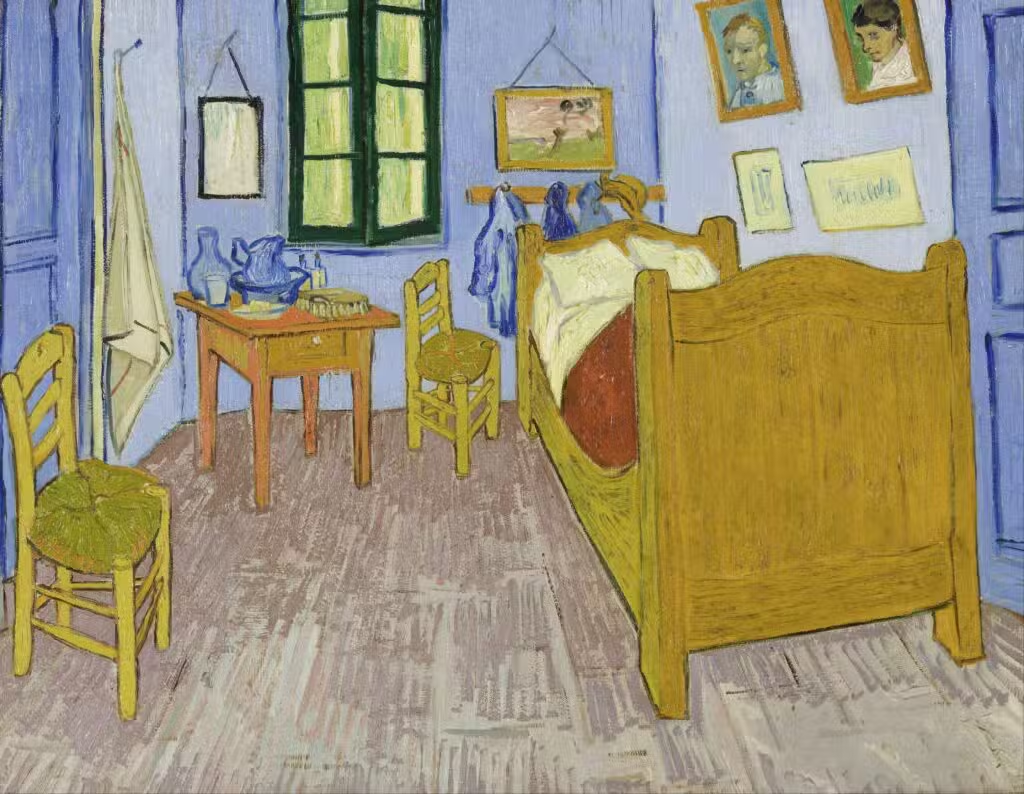
30- The Bedroom in Arles by Vincent van Gogh
The Bedroom in Arles, painted by Vincent van Gogh in 1888, is one of the artist’s most personal and significant works. This painting depicts Van Gogh’s bedroom in the Yellow House in Arles, where he lived during a particularly creative period.
The painting shows the room from an oblique angle, highlighting the simple and colorful furniture. The walls are painted a soft blue, while the floor is a earthy red, creating a vivid contrast with the complementary colors of the furniture – a wooden bed, a chair, a table, and storage pieces. Details like the neatly rolled-up bed linens and the play of light create a warm and intimate atmosphere.
Van Gogh uses vivid colors and expressive brushstrokes to render the texture and depth of the scene. The colors are applied in a fluid and dynamic manner, reflecting the artist’s post-impressionist style. Shadows are minimized, and shapes are simplified, giving the scene an almost dreamlike and decorative quality.
The painting exists in three versions, each highlighting slightly different aspects of the room. This work is often interpreted as a representation of Van Gogh’s emotional state and his desire to create a personal and comforting space.
The Bedroom in Arles is housed at the Musée d’Orsay in Paris. The painting is admired for its ability to capture the essence of the artist’s daily life while reflecting his unique style and innovative approach to color and form.
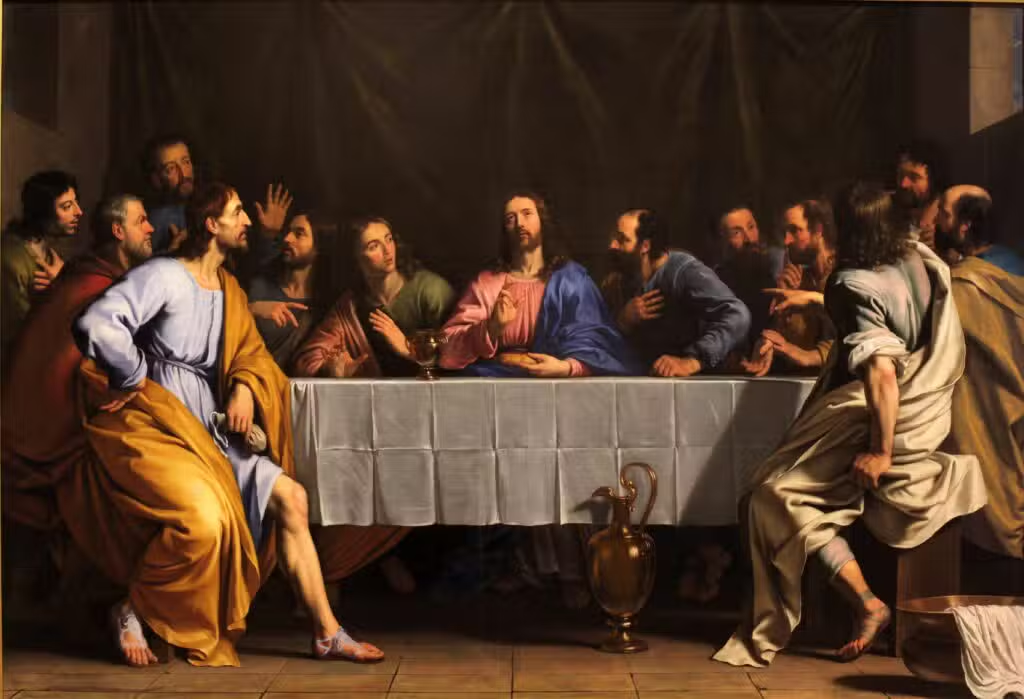
31- The Last Supper by Philippe de Champaigne
The Last Supper by Philippe de Champaigne, painted around 1650, is a sober and elegant interpretation of Jesus Christ’s final meal with his disciples. This painting is a remarkable example of the classical style and realism mastered by the artist.
In this work, Champaigne depicts the scene with a formal and orderly composition, emphasizing the solemnity and dignity of the moment. Jesus is placed at the center of the table, surrounded by the twelve disciples, each displaying varied reactions to the announcement of the betrayal. The painting is characterized by a symmetrical arrangement and a rigorous use of perspective.
The figures are rendered with great precision, with a focus on the facial expressions and gestures of the characters to convey emotions and interactions. The treatment of drapery and textures is detailed, showcasing Champaigne’s technical skill in rendering clothing and objects.
The background of the fresco is relatively subdued, with architectural elements framing the scene and enhancing the depth and visual stability of the painting. The colors are used discreetly but effectively, with rich tones and subtle contrasts adding to the solemn atmosphere of the work.
The Last Supper by Philippe de Champaigne is housed at the Hermitage Museum in Saint Petersburg. This painting is admired for its clear and respectful representation of the Last Supper, as well as for the artist’s technical mastery and sense of visual harmony.
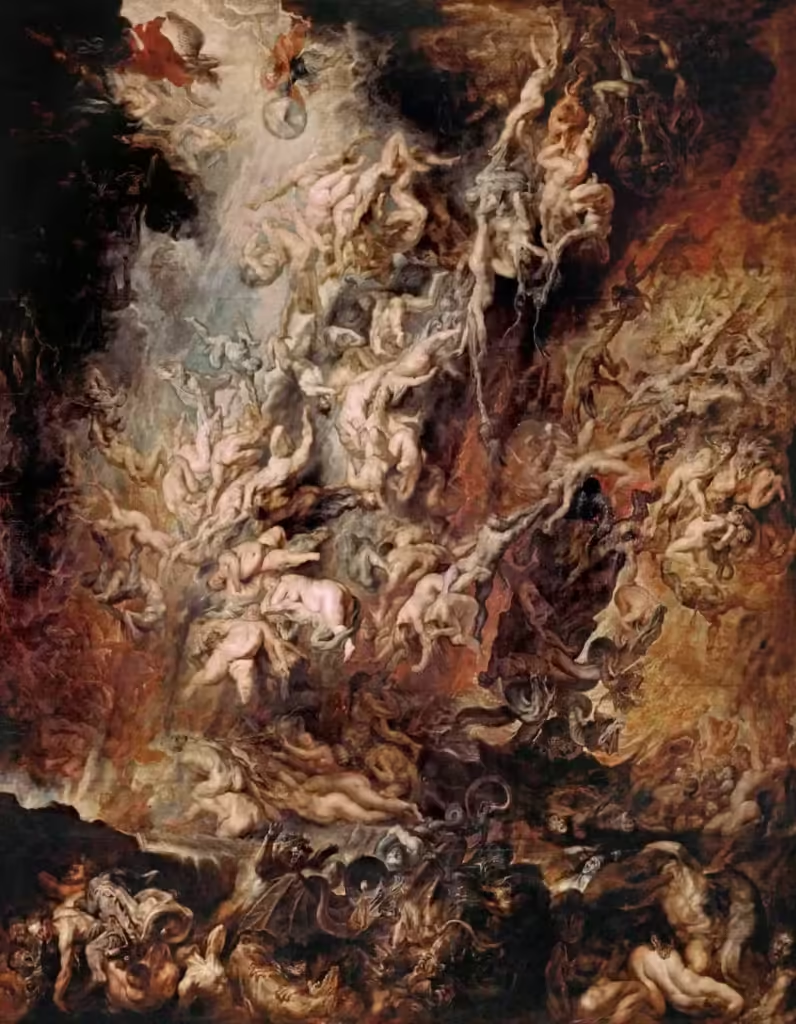
32- The Fall of the Damned by Peter Paul Rubens
The Fall of the Damned, painted by Peter Paul Rubens around 1614-1615, is a monumental and dynamic work illustrating a dramatic and apocalyptic scene from the Last Judgment. This painting is a spectacular example of Rubens’ Baroque style, known for its energy, rich details, and emotional expressiveness.
The painting depicts a tumultuous scene where demons and damned souls are cast into the flames of Hell. Rubens portrays intense chaos, with human figures and demonic creatures intertwined in a swirling composition. The bodies are rendered with remarkable physical power, capturing both the pain and terror of the damned.
The colors are vibrant, and the contrasts between light and shadow are heightened to create a dramatic effect. The use of chiaroscuro, an important Baroque technique, adds depth and gravity to the scene, while the dynamic brushstrokes enhance the movement and violence of the composition.
The Fall of the Damned is housed at the Royal Museums of Fine Arts of Belgium in Brussels. This work is often admired for its visual grandeur, intense expressiveness, and bold treatment of the theme of damnation and judgment. Rubens uses his technical mastery to create a scene that is both terrifying and fascinating, capturing the complexity and emotional intensity of the subject.

33- The Sleeping Gypsy by Henri Rousseau
The Sleeping Gypsy, painted by Henri Rousseau in 1897, is an emblematic work of the artist’s naïve style. This painting is known for its colorful and dreamlike depiction of a sleeping gypsy in an exotic landscape.
The painting depicts a woman lying in a lush forest, surrounded by dense vegetation and exotic flowers. The gypsy is shown in vibrant clothing, contrasting with the rich tones of the surrounding landscape. She rests peacefully, encircled by natural elements that create an atmosphere of calm and reverie.
Rousseau uses vivid colors and stylized forms to create a scene that is both idyllic and slightly surreal. His naïve style is evident in the decorative details and the flat composition, which lend the painting a nearly symbolic quality. The trees, plants, and flowers are painted with meticulous detail, yet without traditional perspective, contributing to the painting’s fantastical appearance.
The Sleeping Gypsy is often admired for its ability to evoke an imaginary and enchanting world, as well as for its bold use of color and form. The work is housed at the Musée d’Orsay in Paris, where it continues to captivate viewers with its unique vision and naïve charm.
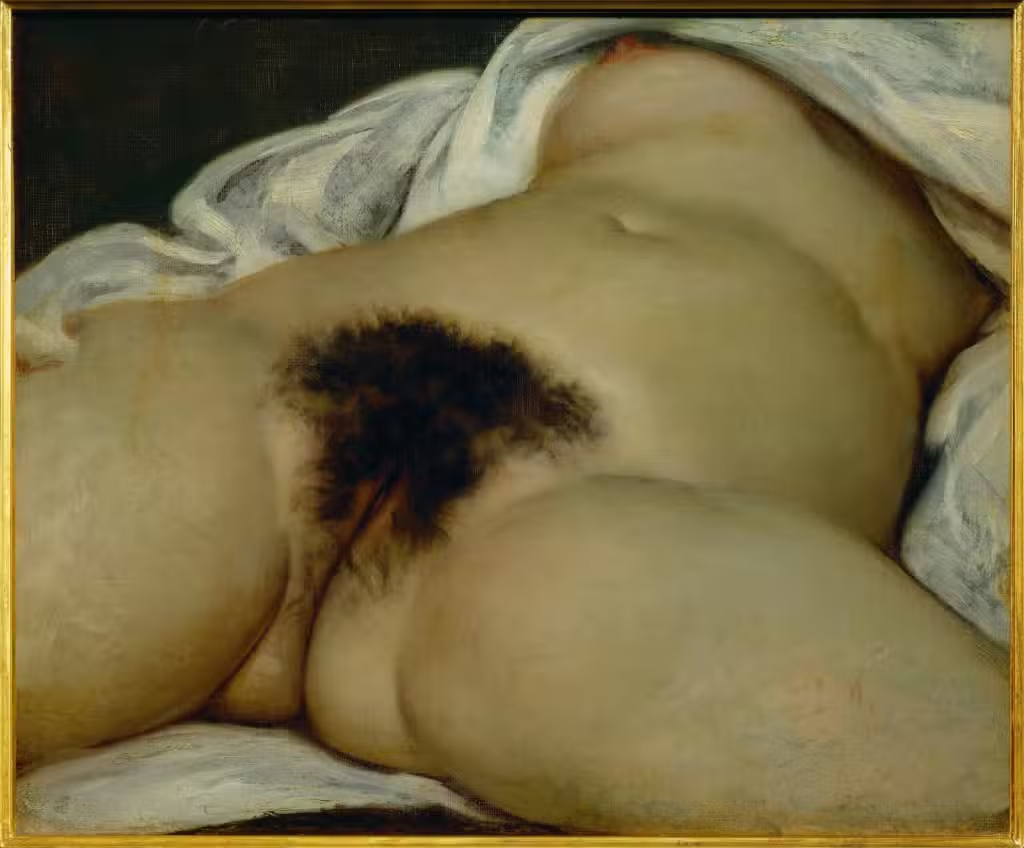
34- The Origin of the World by Gustave Courbet
The Origin of the World, painted by Gustave Courbet in 1866, is a bold and provocative work that provides an explicit portrait of the female vulva. This painting is one of the most famous examples of realism and has provoked considerable reaction for its direct and unflinching representation of female sexuality.
The painting features a close-up view of the female genitalia, with meticulous attention to anatomical detail. The woman is depicted lying on a bed with her legs slightly apart, offering a clear and frontal view of her genitals. The representation is direct, yet Courbet approaches the subject with remarkable technical precision and a sensuality that transcends mere pornography.
The work is painted with earthy tones and lighting that highlights the textures and shapes, creating an effect of raw and honest realism. The canvas is devoid of ornamentation, focusing solely on the central subject and its minimalist context.
The Origin of the World is housed at the Musée d’Orsay in Paris. This painting is frequently discussed for its impact on the discourse surrounding sexuality, art, and the representation of the human body. Though controversial, it is also admired for its artistic bravery and its exploration of the human body from a realistic and unashamed perspective.

35- Emperor Napoleon in his office at the Tuileries by Jacques-Louis David
Emperor Napoleon in his office at the Tuileries, painted by Jacques-Louis David in 1812, is an iconic portrait that captures the majesty and power of Napoleon Bonaparte during his reign. The painting presents Napoleon in a moment of intense concentration and authority, highlighting his role as a leader.
In this artwork, Napoleon is depicted seated at his richly decorated desk in the Palais des Tuileries, engaged with important documents. The painting features the emperor in an elegant military uniform, surrounded by symbols of power such as maps, books, and luxury items. This setting emphasizes his status as both a leader and a commander-in-chief.
David employs a formal and rigid composition to underscore Napoleon’s authoritative presence. The furniture and objects in the office are rendered with meticulous precision, reflecting the opulence and grandeur of the imperial era. The use of light draws attention to Napoleon and his determined gestures, creating an atmosphere of focus and gravity.
The background of the painting includes ornate walls and draperies, enhancing the official and imposing nature of the office. The detailed decor and elements of the room contribute to portraying Napoleon as the central figure of power.
Emperor Napoleon in his office at the Tuileries is housed at the Musée du Louvre in Paris. The portrait is celebrated for its detailed representation of Napoleon and for its role in glorifying the emperor through Jacques-Louis David’s academic and heroic style.

36- The Man with the Golden Helmet by Rembrandt van Rijn
The Man with the Golden Helmet, painted by Rembrandt van Rijn around 1650, is a remarkable portrait that showcases the Dutch master’s skill in capturing light, texture, and human expression. This work is often admired for its masterful representation of realism and character.
The painting depicts a man in armor, wearing a gold helmet with intricately detailed ornamentation. The figure is portrayed in a partial view, with an intense and contemplative gaze directed slightly downward. Light falls on the man’s face and helmet, highlighting the golden reflections and complex details of the armor while creating deep shadows that emphasize the contours and textures.
Rembrandt employs a chiaroscuro technique to create depth and dramatic dimension, focusing the viewer’s attention on the key elements of the portrait— the face, the helmet, and the armor. Visible brushstrokes add texture to the surface of the painting, enhancing the shine of the helmet and the texture of the subject’s skin.
The background is dark and neutral, serving as a contrast to the brightly detailed figure, thereby emphasizing the importance of the central subject. The composition is simple yet powerful, bringing out the character and presence of the individual.
The Man with the Golden Helmet is housed at the Wallace Collection in London. The portrait is celebrated for its technical mastery, innovative use of light, and deep sense of the subject’s personality and character.

37- The Mouth of the Grand Canal, Venice by Giovanni Antonio Canal
The Mouth of the Grand Canal, Venice, painted by Giovanni Antonio Canal, known as Canaletto, around 1730, is a quintessential example of 18th-century Venetian painting. This artwork masterfully depicts one of Venice’s most iconic sites, showcasing the grandeur and architecture of the city.
The painting presents a panoramic view of the Grand Canal’s mouth, capturing the scene from the Doge’s Palace to the Venetian lagoon. The composition is dominated by the impressive architecture of the canal-side buildings, including palaces and churches, depicted with detailed precision and luminous clarity.
Canaletto employs rigorous perspective and meticulous attention to detail to create a realistic and immersive view of the scene. The colors are vibrant, and the play of light on the canal’s water adds a shimmering, lifelike quality. The reflections of the buildings and gondolas in the water are rendered with fine detail, demonstrating the artist’s skill in capturing light and texture.
Gondolas, boats, and figures are painted with accuracy, adding movement and life to the otherwise static composition. The background features the often cloudy Venetian sky, which enhances the scene’s atmosphere while highlighting the majesty of the buildings.
The Mouth of the Grand Canal, Venice is housed at the National Gallery in London. The painting is celebrated for its realistic and detailed representation of Venice, as well as Canaletto’s mastery in capturing the light, architecture, and urban life of the lagoon city.
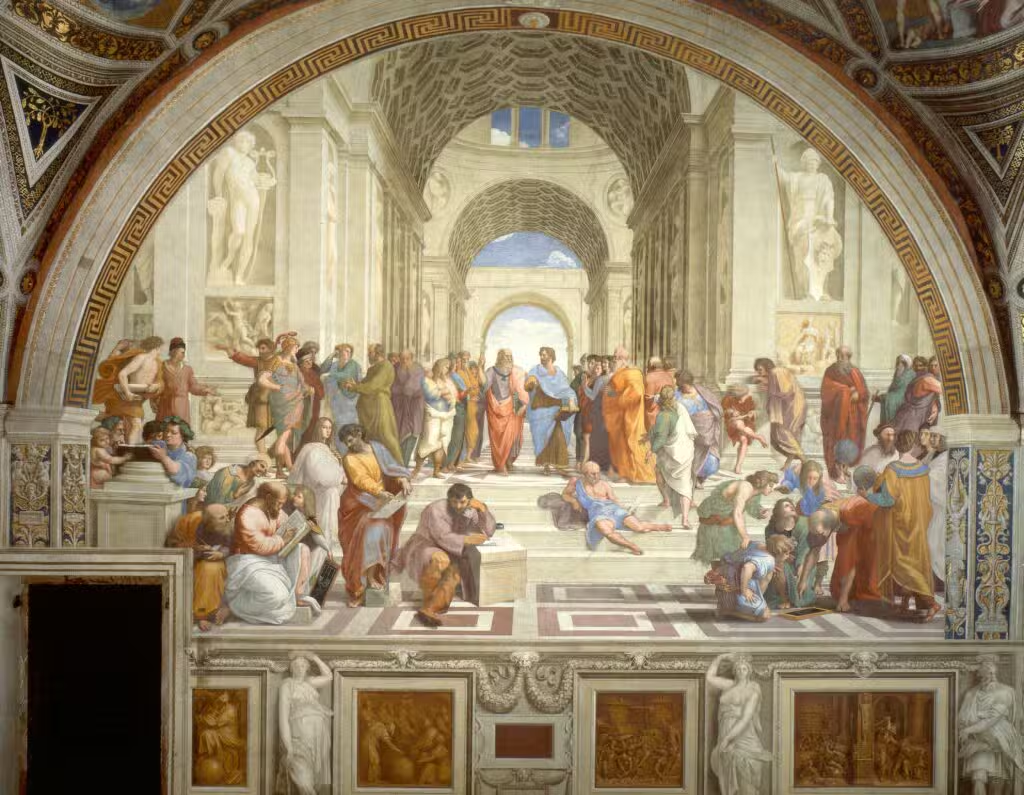
38- The School of Athens by Raphael
The School of Athens, painted by Raphael between 1509 and 1511, is one of the most famous and influential works of the Italian Renaissance. This fresco, located in the Stanza della Segnatura at the Vatican, is a grand celebration of ancient philosophy, science, and wisdom.
The painting depicts a grand assembly of philosophers, scholars, and thinkers from antiquity, gathered within a magnificent classical-inspired architecture. At the center of the composition are two iconic figures: Plato and Aristotle, engaged in debate. Plato, whose face resembles Leonardo da Vinci, holds a dialogue in his hand, while Aristotle, resembling Michelangelo, presents a scroll.
Surrounding them are figures of famous philosophers and scientists such as Socrates, Epicurus, and Pythagoras, arranged in dynamic groups and lively interactions. Raphael also includes portraits of his contemporaries, including himself, Leonardo da Vinci, and Michelangelo, creating a link between the past and the present.
The fresco is noted for its masterful use of perspective, creating an illusionistic depth with a series of classical vaults and arches. The figures are rendered with detailed realism and poses that express the various philosophies and knowledge of the represented characters.
The School of Athens is often praised for its harmonious composition, innovative use of perspective, and its ability to capture the spirit of the Renaissance by linking ancient knowledge with modern ideas. This masterpiece is housed in the Stanza della Segnatura at the Vatican, where it continues to attract admiration for its intellectual and aesthetic beauty.

39- The Arrest of Christ by Caravaggio
The Arrest of Christ, painted by Michelangelo Merisi da Caravaggio in 1602, is an iconic work of the Baroque period, renowned for its dramatic and realistic portrayal of a key moment in the New Testament. The painting depicts the arrest of Jesus Christ in the Garden of Gethsemane, just before his crucifixion.
The scene focuses on the moment when Jesus is betrayed by Judas Iscariot, who kisses him to signal his identity to the soldiers. Caravaggio captures the intensity and chaos of this moment with a dynamic composition and the characteristic contrasts of light and shadow of the Baroque style.
The painting is strikingly dramatic, with bold use of chiaroscuro to highlight the expressions and gestures of the figures. Jesus, at the center, is portrayed with profound tranquility and dignity, contrasting with the agitation and violence of the soldiers and disciples. The shadow enveloping part of the scene heightens the dramatic tension and atmosphere.
The figures are rendered with raw realism and precise details that add a tactile dimension to the work. The characters are painted with strong expressions, and the visible brushstrokes contribute to the vivid and emotional quality of the scene.
The Arrest of Christ is housed at the Galleria Borghese in Rome. This painting is admired for its ability to capture the moment with emotional intensity and technical mastery, representing a turning point in art history with its innovative approach to light, movement, and realism.

40- The Annunciation by Leonardo da Vinci
The Annunciation, painted by Leonardo da Vinci around 1472-1475, is a masterpiece from the artist’s early period, depicting the angel Gabriel announcing to the Virgin Mary that she will conceive Jesus Christ. This work is an early example of Leonardo’s genius for composition, perspective, and the representation of human emotions.
The painting shows the angel Gabriel delivering his message to the Virgin Mary, who is depicted in a richly decorated and sumptuous interior. Gabriel is portrayed with outstretched wings, an elegant posture, and a gentle, reassuring expression, while Mary, seated in a humble position, listens with an expression of surprise and devotion.
Leonardo employs innovative linear perspective to create realistic depth and dimension within the interior space. The architectural details in the background, such as columns and arches, are rendered with great precision, adding to the richness and complexity of the scene.
Colors are used subtly, and the play of light highlights the main figures while creating an atmosphere of serenity and mystery. The drapery of the garments is rendered with fluidity and texture, showcasing Leonardo’s technical mastery.
The Annunciation is housed at the Uffizi Gallery in Florence. This painting is often admired for its innovative treatment of the religious subject, its harmonious composition, and its skillful use of perspective and light, marking an important step in Leonardo da Vinci’s artistic development.

41- The Soul of the Rose by John William Waterhouse
The Soul of the Rose, painted by John William Waterhouse in 1908, is an iconic work of the Pre-Raphaelite style, celebrated for its romantic and symbolic representation. This painting illustrates a melancholic and elegant female figure interacting with a rose, offering a poetic and dreamy vision of nature and human emotions.
The scene depicts a young woman in a sumptuous gown, delicately leaning in to admire a rose, as if trying to capture its essence or understand its mystery. The woman’s expression is both contemplative and melancholic, reflecting a deep emotional connection and spiritual affinity with the flower.
Waterhouse employs a rich color palette and intricate details to create an ethereal and enchanting atmosphere. The textures of the fabrics, the delicate shades of the flowers, and the interplay of light on the woman’s face are rendered with great finesse, highlighting the sensuality and softness of the scene.
The background is typically blurred or stylized, focusing the viewer’s attention on the central subject without distraction. The composition is harmonious, emphasizing the contrast between the fragility of the rose and the delicacy of the woman, creating an atmosphere of dreaminess and contemplation.
The Soul of the Rose is often admired for its visual beauty, emotional sensitivity, and its ability to capture the spirit of the Pre-Raphaelite movement, which sought to rediscover the beauty and intensity of medieval and mythological themes. The painting is housed in the Manchester Art Gallery.

42- The Angelus by Jean-François Millet
The Angelus, painted by Jean-François Millet between 1857 and 1859, is one of the most famous works of the Realist movement, depicting rural life and deep religious reverence in 19th-century France. This painting captures a moment of pause and prayer in the everyday lives of peasants.
The scene shows a peasant couple, a man and a woman, stopping in a field to pray at the evening bell, known as “the Angelus.” The man is kneeling, holding his hat in a sign of respect, while the woman stands beside him, joining her hands in prayer. The scene is framed by a simple yet expansive rural landscape, with plowed fields and a twilight sky.
Millet uses earthy colors and soft lighting to create an atmosphere of serenity and devotion. The figures are rendered with great precision, reflecting the physical characteristics and clothing of peasants of the time. The composition is harmonious, with a skillful use of perspective to emphasize the depth of the landscape and the significance of the religious scene.
The painting is often interpreted as a celebration of the simplicity and spirituality of peasant life, highlighting the dedication and respect for religious traditions. The Angelus is housed in the Musée d’Orsay in Paris. The work is admired for its sincere and respectful portrayal of rural life, as well as Millet’s technical and emotional mastery in capturing light and textures.
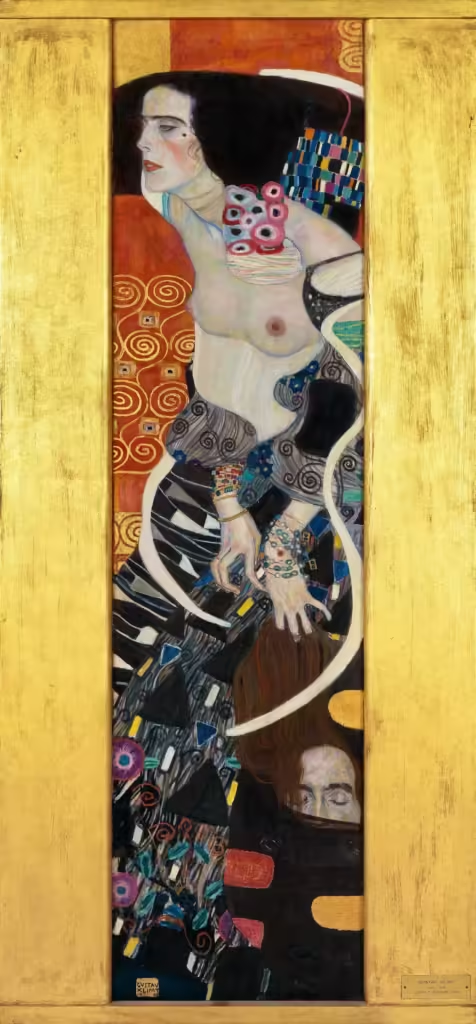
43- Judith II by Gustav Klimt
Judith II, also known as Judith and Holofernes, is a painting by Gustav Klimt from 1909, continuing his exploration of symbolism and eroticism. This work offers a bold and dramatic interpretation of the biblical story of Judith and Holofernes.
The painting depicts Judith, a heroic biblical figure, holding the severed head of the Assyrian general Holofernes, whom she has killed to save her people. Klimt portrays Judith with intense sensuality; her pose and expression are both confident and provocative. She is dressed in a richly adorned gown with golden patterns, characteristic of Klimt’s ornamental style, and her hair is decorated with intricate motifs.
Holofernes’ decapitated head is placed prominently in the foreground, emphasizing the brutality and violence of the act while contrasting with Judith’s beauty and grace. The background is adorned with golden patterns and abstract forms, creating a rich and symbolic atmosphere that heightens the dramatic nature of the scene.
Klimt uses vivid colors and luxurious textures to enhance the visual richness of the painting. The combination of gold, deep reds, and detailed patterns creates a captivating and opulent effect, typical of Klimt’s style.
Judith II is housed at the Belvedere Gallery in Vienna. The work is often admired for its bold representation of female power and for Klimt’s mastery in using color and pattern to create a scene that is both dramatic and aesthetically striking.

44- The Accomplishment by Gustav Klimt
The Accomplishment, painted by Gustav Klimt in 1905, is a notable work from his Golden Phase, showcasing his distinctive features of ornamentation and symbolism. This painting illustrates a woman undergoing transformation and personal growth, reflecting themes of beauty, sensuality, and spiritual development.
The composition of the painting is dominated by the central figure of a woman, portrayed in an elegant and introspective pose. She is enveloped in richly decorated drapery and golden patterns, characteristic of Klimt’s ornamental style. The detailed motifs and complex textures create a luxurious visual effect that captivates the eye.
The background of the work is often adorned with geometric and floral patterns that blend harmoniously with the central figure, emphasizing her integration into an almost ethereal and timeless environment. The color palette includes golden hues, bright whites, and deep shades, adding to the visual richness and mystical ambiance of the scene.
The Accomplishment is generally admired for its ability to capture the essence of Klimt’s unique style and for its elegant representation of personal transformation and inner development. Although the painting is held in a private collection, it continues to fascinate art enthusiasts with its refined aesthetics and rich symbolism.

45- Judith and Holofernes by Caravaggio
Judith and Holofernes, painted by Caravaggio between 1598 and 1599, is a dramatic and powerful work that depicts the biblical scene where Judith decapitates the Assyrian general Holofernes to save her people. This painting is renowned for its intense and realistic portrayal of violence and its innovative use of chiaroscuro.
In this painting, Judith is shown with fierce determination, holding the decapitated head of Holofernes. Judith’s expression is both resolute and cold, while her maidservants assist in holding the general’s head and preparing for the decapitation. Holofernes is depicted in the throes of death, capturing the moment just before his demise with dramatic intensity.
Caravaggio uses chiaroscuro to create a striking contrast between the figures and the dark background. The light illuminates the main figures to emphasize their presence and the violent action unfolding. The anatomical details and expressions of the characters are rendered with raw precision, reflecting Caravaggio’s realistic and unflinching style.
The painting is often praised for its bold treatment of the subject and the emotional intensity it conveys. The dynamic composition and lighting effects enhance the dramatic impact of the scene.
Judith and Holofernes is housed at the Galleria Nazionale d’Arte Antica in Rome. This work is a striking example of Caravaggio’s talent for realistic and dramatic representation, as well as his innovative use of light to heighten the emotional depth of his scenes.

46- Judith Beheading Holofernes by Artemisia Gentileschi
Judith Beheading Holofernes, painted by Artemisia Gentileschi between 1612 and 1613, is a prominent Baroque work renowned for its bold and powerful depiction of the biblical scene where Judith decapitates the Assyrian general Holofernes. This painting is particularly notable for its feminist perspective and technical mastery.
In this painting, Judith is portrayed with remarkable strength and determination. She is shown cutting off Holofernes’s head with a sword, while her maidservants, Abra and another female figure, assist in the act with palpable intensity. Holofernes’s face is marked by an expression of terror and pain, capturing the brutal moment of his death.
Artemisia Gentileschi employs dramatic chiaroscuro to accentuate the contrasts between light and shadow, highlighting the main figures and the violence of the scene. The details of facial expressions, textures of clothing, and the effects of blood are rendered with great precision and intense realism.
The composition is dynamic, with Judith and her assistants presented in full motion, adding to the visual and emotional impact of the painting. The scene is both heroic and poignant, reflecting Judith’s strength and resilience in the face of oppression.
Judith Beheading Holofernes is housed at the Uffizi Gallery in Florence. This work is often admired for its narrative power, technical mastery, and innovative approach to the subject, showcasing female strength and courage with unparalleled dramatic intensity.

47- Young Orphan in the Cemetery by Eugène Delacroix
Young Orphan in the Cemetery, painted by Eugène Delacroix in 1834, is a significant work that captures melancholy and solitude through the lens of Romanticism. This painting is often interpreted as a reflection on loss and sadness, illustrating Delacroix’s dramatic and emotional style.
The painting depicts a young orphan dressed in black, sitting on a gravestone in a cemetery. Her expression is filled with sorrow and despair, while she holds a bouquet of flowers, symbolizing mourning and remembrance. The scene is bathed in a soft light that highlights the contours of the figure and the somber atmosphere of the cemetery.
Delacroix uses dark colors and rich textures to create a somber and introspective mood. The contrast between light and shadow emphasizes the isolation and vulnerability of the central figure. The details of the gravestones and the surrounding decor add to the atmosphere of sadness and contemplation.
The background features funerary monuments and a cloudy sky, reinforcing the sense of a space steeped in memory and solitude. The composition is carefully orchestrated to draw the viewer’s eye toward the central figure, who is the focal point of the work.
Young Orphan in the Cemetery is housed at the Louvre Museum in Paris. This painting is admired for its ability to convey deep emotions through an elegant composition and a powerful use of color and light, hallmarks of Delacroix’s Romantic style.
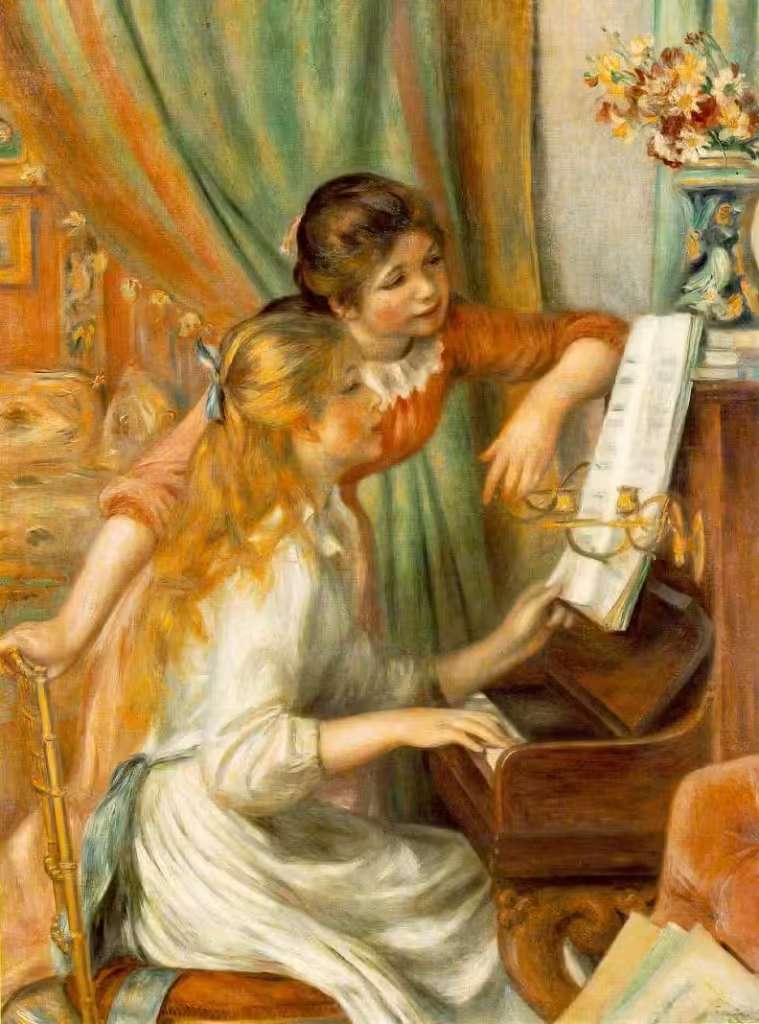
48- Young Girls at the Piano (1892) by Pierre-Auguste Renoir
Young Girls at the Piano, painted by Pierre-Auguste Renoir in 1892, is an emblematic example of Impressionism, capturing the beauty and elegance of bourgeois life at the end of the 19th century. This painting offers an intimate and charming glimpse into a domestic scene.
The painting depicts two young women sitting at a piano, either playing or singing, dressed in elegant pastel-colored dresses typical of Renoir’s style. One of the girls, seated at the piano, turns her head towards the viewer, while the other, slightly further back, remains engaged in the scene.
Renoir employs a palette of soft, luminous colors to create a warm and intimate atmosphere. The play of light on the dresses and furniture, along with the delicate textures, demonstrates Renoir’s skill in rendering surfaces and materials with fluidity and impressive realism.
The background is blurred but suggestive, showing elements of the interior décor, which adds to the richness of the setting without distracting from the main scene. The composition is balanced, highlighting the interactions and expressions of the young women, evoking a sense of calm and sophistication.
Young Girls at the Piano is housed at the Musée d’Orsay in Paris. This work is admired for its elegant portrayal of daily life, its refined use of color and light, and its ability to capture moments of simple beauty and grace.

49- Judith with the Head of Holofernes by Gustav Klimt
Judith with the Head of Holofernes, painted by Gustav Klimt in 1901, is a significant work that depicts a biblical scene with Klimt’s distinctive stylistic signature. This painting presents a dramatic and symbolic representation of Judith, who decapitated the Assyrian general Holofernes to save her people.
In this artwork, Judith is portrayed with notable emotional intensity and sensuality. She is adorned in a gown decorated with intricate golden patterns, characteristic of Klimt’s ornamental style. Her posture is both powerful and graceful as she holds Holofernes’ decapitated head, placed prominently in the foreground with striking contrast.
The background is adorned with geometric patterns and golden details, creating a rich and sumptuous visual effect that enhances Judith’s heroic presence and character. The colors are vivid, and the textures are rendered with great finesse, contributing to the visual impact of the scene.
Judith’s face is depicted with a determined and resolute expression, while Holofernes’ decapitated head is shown with details that emphasize the brutality of the act. Klimt uses chiaroscuro and decorative motifs to reinforce the dramatic and symbolic atmosphere of the scene.
Judith with the Head of Holofernes is housed at the Belvedere Gallery in Vienna. This work is admired for its unique combination of sensuality, symbolism, and ornamentation, as well as Klimt’s mastery in using color and patterns to create a visually captivating and emotionally powerful representation.

50- Young Man at the Window by Gustave Caillebotte
Young Man at the Window, painted by Gustave Caillebotte in 1876, is a significant work of realism and Impressionism. This painting is particularly notable for its innovative representation of perspective and its exploration of modern urban life in the late 19th century.
The scene depicts a young man standing at the window of a Parisian apartment, gazing outward. He is dressed in a dark suit and white shirt, and his posture suggests a moment of contemplation or introspection. The window is framed by white curtains, and through the glass, a glimpse of the city is visible, with its cobblestone streets and buildings.
Caillebotte employs geometric perspective to enhance the depth and structure of the composition. The light filtering through the window creates subtle plays of light on the floor and walls, adding a realistic and atmospheric dimension to the work. The meticulous details of the young man’s clothing and the interior setting showcase Caillebotte’s technical skill, while the simplicity and tranquility of the scene capture a private moment of reflection.
The painting is also remarkable for its representation of urban modernity and everyday life in Paris, integrating elements of perspective and light characteristic of Impressionist style.
Young Man at the Window is housed at the Musée d’Orsay in Paris. This work is often admired for its ability to capture the spirit of modern life through an elegant composition and technical mastery that blends realism with Impressionism.

51- Hylas and the Nymphs by John William Waterhouse
Hylas and the Nymphs, painted by John William Waterhouse in 1896, is a hallmark of the Pre-Raphaelite movement, vividly illustrating a mythological scene with rich sensuality and symbolism. This painting is inspired by the Greek myth of Hylas, a young boy abducted by nymphs during his journey with the Argonauts.
The scene depicts Hylas, a handsome youth, leaning down to draw water from a stream. Surrounding him are seductive water nymphs who draw him toward the water. Their graceful bodies and mysterious demeanor create an enchanting and intriguing atmosphere. The nymphs are portrayed with delicate details and translucent garments that highlight their ethereal charm.
Waterhouse employs a rich and vibrant color palette to emphasize the beauty and sensuality of the scene. The play of light on the water and the reflections on the nymphs’ bodies add a luminous and fluid dimension to the painting. The composition is carefully orchestrated to guide the viewer’s eye to the contrast between Hylas and the nymphs, highlighting their dramatic interaction and the mysterious allure.
The background is lush, with dense vegetation and light filtering through the trees, creating a natural yet almost magical environment. The scene is imbued with a dreamy and desirous atmosphere, reflecting the Pre-Raphaelite themes of beauty, sensuality, and mythology.
Hylas and the Nymphs is housed at the Tate Gallery in London. This work is often admired for its ability to capture the magic and sensuality of the myth, as well as Waterhouse’s technical mastery in representing figures and textures.
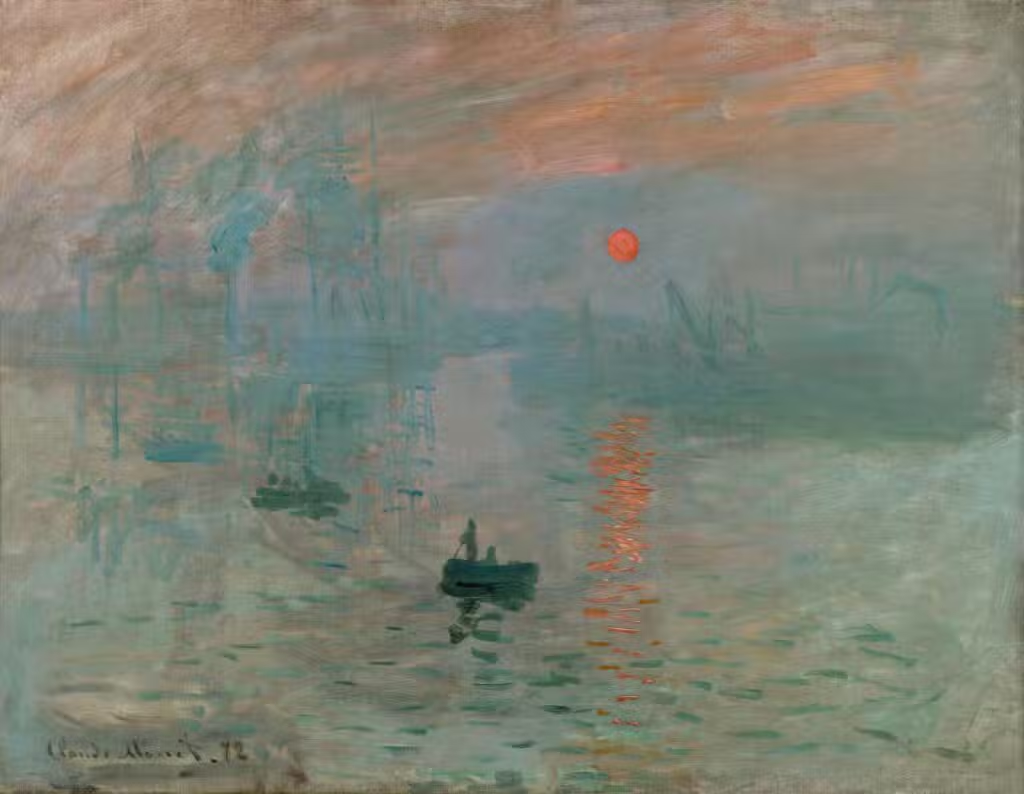
52- Impression, Sunrise by Claude Monet
Impression, Sunrise, painted by Claude Monet in 1872, is the work that gave its name to the Impressionist movement. This painting is an iconic representation of the light and atmosphere of a sunrise over the port of Le Havre, Monet’s hometown.
The painting depicts a maritime landscape at sunrise, with reflections of oranges and blues in the water. The port is only vaguely outlined, with blurred forms and silhouettes of boats emerging softly from the morning mist. The sunlight diffuses through the fog, creating an ethereal and vibrant atmosphere.
Monet employs rapid, visible brushstrokes to capture the effect of light and atmosphere rather than precise details. This painting technique conveys the immediate sensation and visual impression of the moment, focusing on the fleeting beauty of the sunrise rather than on realistic and detailed representation. The colors are applied in light layers, creating effects of light and reflection that capture the ephemeral beauty of the sunrise.
The title Impression, Sunrise was provocatively used to critique and define Monet’s and other Impressionist artists’ style, which sought to represent visual impressions rather than realistic details.
Impression, Sunrise is housed at the Musée Marmottan Monet in Paris. This work is widely celebrated for its artistic innovation and its role in the emergence of the Impressionist movement, marking a turning point in how light and color were represented in art.

53- The Great Wave off Kanagawa by Katsushika Hokusai
The Great Wave off Kanagawa, created by Katsushika Hokusai around 1831, is one of the most famous prints from the series Thirty-Six Views of Mount Fuji. This iconic ukiyo-e print is renowned for its dramatic depiction of nature’s power and its striking graphic beauty.
The print shows a massive wave crashing towards fishing boats at sea, with Mount Fuji appearing in the background, barely visible through the crest of the waves. The wave, which seems almost alive, is depicted with dynamic curves and exquisite detail, capturing the movement and force of the water.
Hokusai uses vivid colors and strong contrasts to highlight the power and majesty of the wave. The shades of blue, combined with touches of white for the foam, create a stunning visual effect. The details of the waves and boats are rendered with technical precision, showcasing Hokusai’s mastery of the printmaking art.
Mount Fuji, depicted in the background with softer tones, serves as a calm counterpoint to the turbulence of the wave in the foreground. This composition juxtaposes the vastness and tranquility of the mountain with the violence and force of the sea, creating a harmonious balance and visual depth.
The Great Wave off Kanagawa is housed in several collections worldwide, including the Metropolitan Museum of Art in New York and the Musée de l’Impressionnisme in Giverny. This print is often admired for its technical innovation and its ability to capture the sublime beauty and power of nature, making it a masterful example of the ukiyo-e genre.
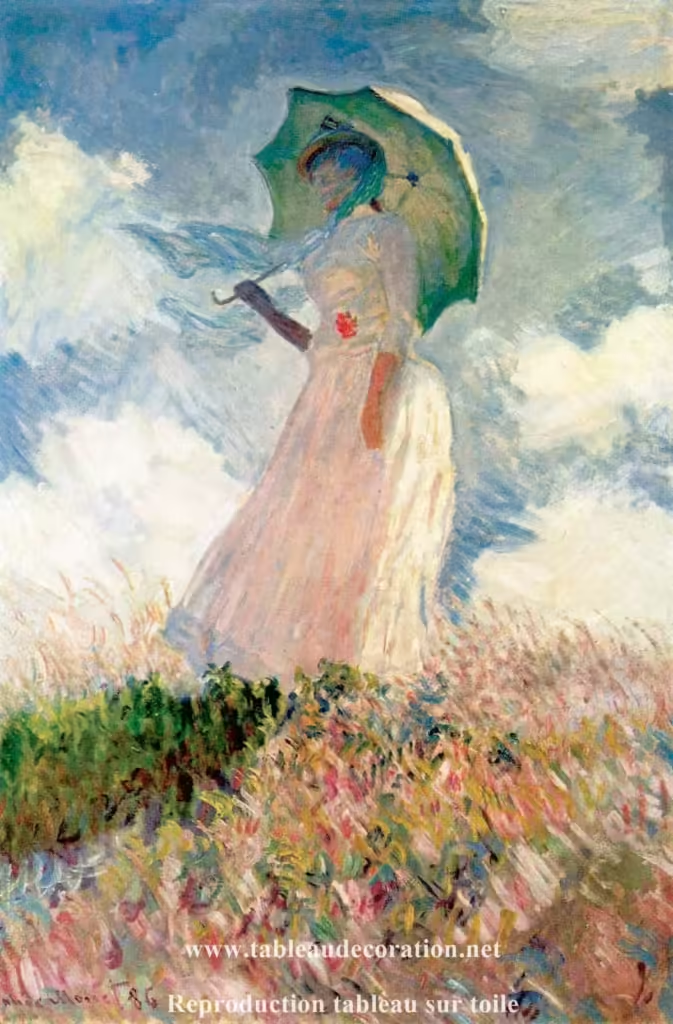
54- Woman with a Parasol – Madame Monet and Her Son by Claude Monet
Woman with a Parasol – Madame Monet and Her Son, painted by Claude Monet in 1875, is an iconic example of Impressionist style, capturing a fleeting moment of everyday life with the characteristic lightness and luminosity of Monet’s work.
The painting depicts a young woman in a white dress, holding a parasol to shield herself from the sun, walking through a flower-filled field. She is shown in profile, turned to the left, with her face partially obscured by the shadow of the parasol. The background features a blurred landscape bathed in light, with touches of color suggesting a green field and a bright sky.
Monet employs quick brushstrokes and light colors to create a sense of movement and fluidity. The details of the woman’s dress, the reflections on the parasol, and the nuances of light on the flowers are rendered with a keen sensitivity to natural light. Monet’s Impressionist technique is evident in the vibrant, free application of color that conveys the atmosphere of the moment rather than precise details.
The painting is celebrated for its ability to convey the lightness and beauty of the moment, as well as Monet’s mastery of light and color. Woman with a Parasol – Madame Monet and Her Son is often regarded as a perfect example of Monet’s art in capturing the ephemeral quality of light and the elegance of outdoor scenes.
This work is housed at the Musée d’Orsay in Paris, where it continues to captivate viewers with its delicate and Impressionist portrayal of late 19th-century daily life.
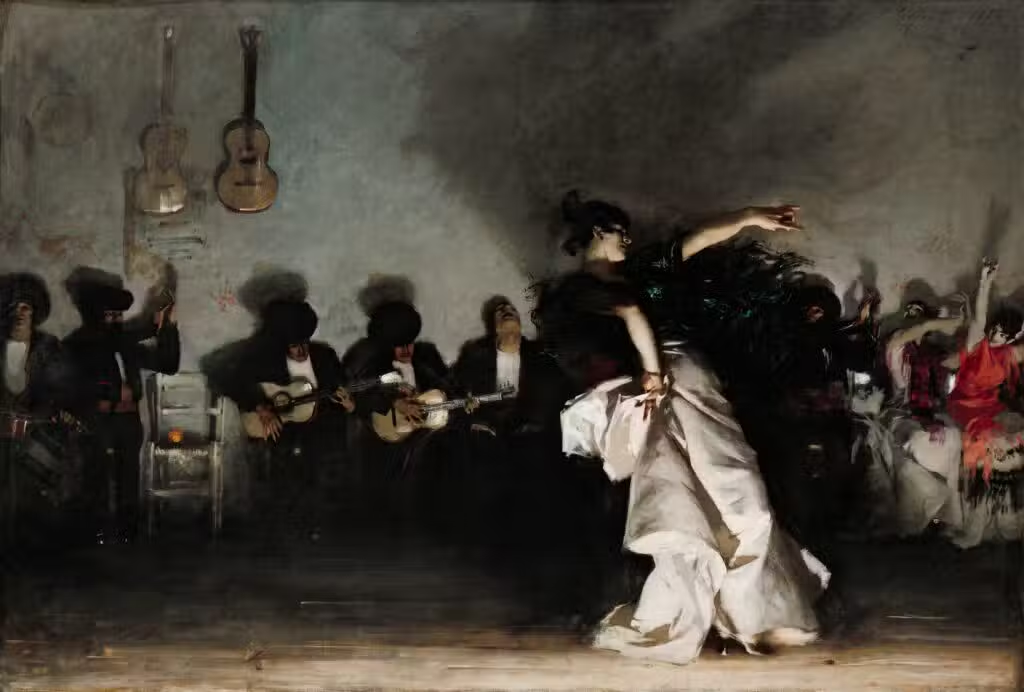
55- El Jaleo by John Singer Sargent
El Jaleo, painted by John Singer Sargent in 1882, is a vibrant work that captures the energy and passion of a flamenco performance, a traditional Spanish dance genre. This painting is a striking demonstration of Sargent’s style, combining impressive technical mastery with a vivid representation of Spanish culture.
The scene takes place in a richly decorated, dimly lit interior, where a flamenco dancer is captured mid-movement. The dancer, dressed in a traditional costume adorned with intricate details, is surrounded by musicians and spectators, contributing to the lively atmosphere of the performance. The dynamism of the dance is highlighted by the dancer’s expressive gestures and dynamic posture.
Sargent employs a palette of rich, deep colors with touches of light to accentuate key elements of the scene, such as the dancer’s costume and the musical instruments. The contrasts between light and shadow create an intense and immersive ambiance, drawing the eye toward the center of the performance.
The painting is also notable for its bold composition and use of space. Sargent arranges the figures to create a sense of depth and movement while emphasizing the energy and passion of the spectacle. The meticulous details of the costumes, instruments, and the expressions of the characters showcase Sargent’s talent for capturing the nuances of life and culture.
El Jaleo is housed at the Isabella Stewart Gardner Museum in Boston. This work is often admired for its ability to capture the essence of flamenco with visual and emotional intensity, demonstrating Sargent’s mastery in expressing color, light, and movement.

56- Two Satyrs by Peter Paul Rubens
Two Satyrs, painted by Peter Paul Rubens in 1618, is a quintessential example of Baroque style, showcasing Rubens’ interest in mythology and his ability to depict classical figures with great expressiveness and visual dynamism.
The painting features two satyrs, mythological creatures that are half-man, half-goat, drawn from Greco-Roman mythology. These figures are depicted in active poses, with facial expressions and postures that convey their wild and mischievous nature. The satyrs are portrayed with robust bodies and detailed physical traits and attitudes.
Rubens employs a palette of warm, vibrant colors to enhance the texture and sensuality of the figures. The interplay of light and shadow highlights the muscles and contours of the satyrs, creating a sense of depth and movement. The details of their hair, beards, and skin are rendered with great precision, showcasing Rubens’ skill in capturing the nuances of flesh and fabric.
The background is generally blurred or suggestive, emphasizing the main figures while creating an atmosphere that complements their mythological and wild character. The composition is dynamic, with a particular focus on the representation of forms and textures to create a visually captivating image.
Two Satyrs is housed at the Museo del Prado in Madrid. This work is often admired for its technical mastery and expressiveness, representing classical mythological themes with the intensity and richness characteristic of Rubens’ Baroque style.

57- Great Blue Horses by Franz Marc
Great Blue Horses, painted by Franz Marc in 1911, is a hallmark of German Expressionism and represents a key work from Marc’s avant-garde period. This painting showcases the artist’s passion for color and form, as well as his interest in the symbolic representation of nature.
The painting features three powerful and majestic horses rendered in intense shades of blue. The horses are stylized and simplified, with geometric shapes and vibrant colors that emphasize their presence and energy. Their bodies are depicted with dynamic, curved lines that express movement and vitality.
Marc uses blue, a color he associates with spirituality and harmony, to create a serene and almost mystical atmosphere around the horses. The contrast between the blue of the horses and the more neutral colors of the background enhances their importance and beauty. The abstract geometric shapes and colors reflect the influence of Cubism and Fauvism on Marc’s work, while remaining deeply rooted in his symbolic vision of nature.
The background consists of abstract colors and shapes that complement the horses’ figures without distracting from their central presence. The composition is balanced and harmonious, highlighting the interaction between the horses and their environment while maintaining a sense of serenity and grandeur.
Great Blue Horses is housed at the Neue Galerie in New York. This work is celebrated for its ability to blend a stylized depiction of nature with innovative use of color and form, capturing the essence and power of the animals while exploring spiritual and symbolic themes.
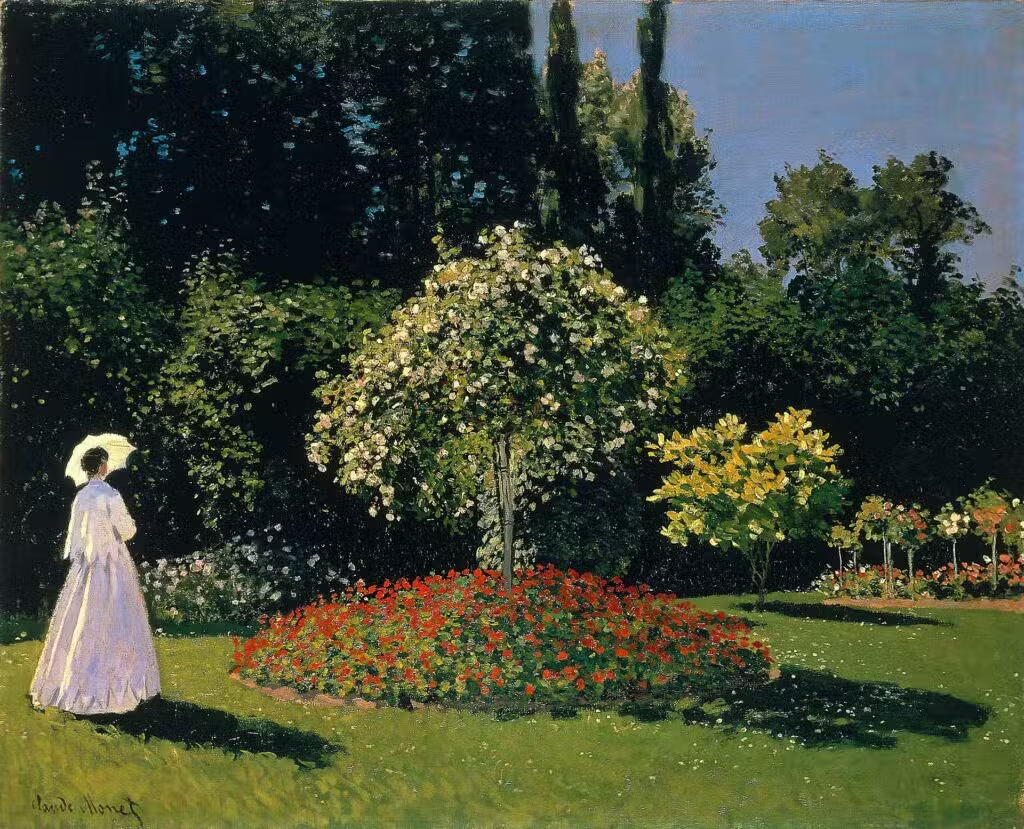
58- Lady in White in the Garden by Claude Monet
Lady in White in the Garden , painted by Claude Monet in 1867, is an Impressionist masterpiece that captures an intimate and elegant moment of a woman in a lush garden. This painting is a striking example of Monet’s exploration of light and color effects in everyday scenes.
The painting depicts a woman dressed in a white gown, seated or standing in a blooming garden. She is surrounded by luxuriant foliage, with colorful flowers and greenery creating a vibrant contrast with her light attire. Sunlight reflects off the white dress, creating delicate play of light and shadow that enhances the texture and transparency of the fabric.
Monet uses visible brushstrokes and fresh colors to capture the essence of the moment and the atmosphere of the garden. The color palette is dominated by greens and floral tones, with touches of white and blue to highlight the light and brightness of the scene. The background is blurred and Impressionistic, suggesting the depth and richness of the garden without focusing on precise details.
The composition is balanced and harmonious, with the figure of the woman and the surrounding vegetation complementing each other to create a peaceful and elegant scene. The work reflects Monet’s interest in capturing natural light effects and the fleeting beauty of outdoor environments.
Lady in White in the Garden is held at the National Gallery of Art in Washington. This painting is often admired for its subtle depiction of light and color, as well as its ability to capture a moment of calm and beauty in nature.
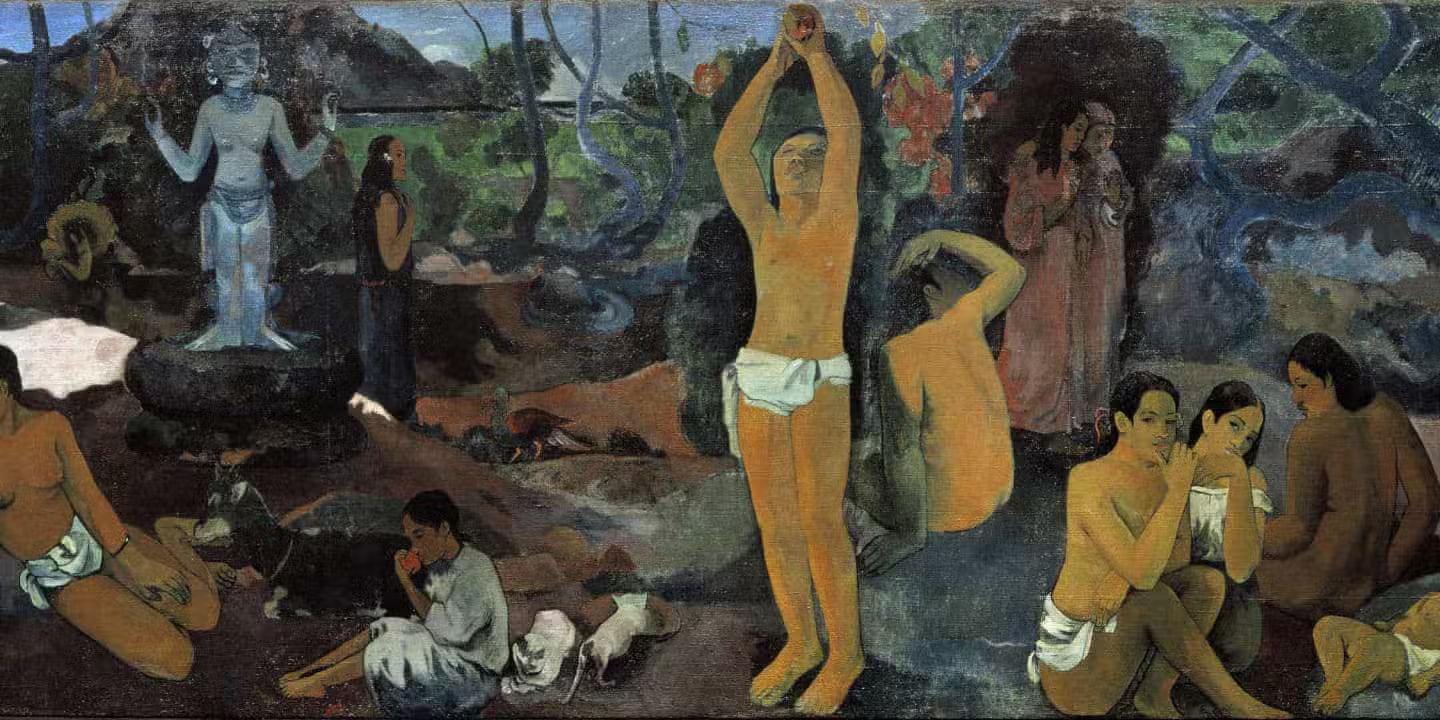
59- Where Do We Come From? by Paul Gauguin
Where Do We Come From?, painted by Paul Gauguin between 1897 and 1898, is a monumental and emblematic work of Post-Impressionism, created during his time in Tahiti. This painting is often seen as a manifesto of Gauguin’s personal and symbolic vision of life and human destiny.
The painting is a large canvas divided into several sections, each representing different stages of human life, from birth to death, in a symbolic and symbolist style. The human figures are depicted within an exotic and dreamlike landscape, characteristic of Gauguin’s later works.
On the left, the scene depicts birth and youth. The figures are shown in postures and attitudes that evoke innocence and curiosity.
In the center, the scene illustrates adult life with its complexities and dilemmas. The characters are engaged in various interactions and reflections that reflect the diverse facets of human existence.
On the right, the scene represents old age and death, with older and more melancholic figures, illustrating the end of life and the existential questions that accompany it.
Gauguin uses vibrant colors and stylized forms to express his symbolic themes. The figures are portrayed in dramatic poses and varied expressions, adding an emotional and philosophical dimension to the composition. The tropical landscape, with its saturated colors and stylized forms, enhances the mystical and introspective atmosphere of the painting.
Where Do We Come From? is housed at the Musée d’Orsay in Paris. This work is often admired for its artistic and philosophical ambition, as well as for its ability to blend an exotic aesthetic with profound questions about the human condition.
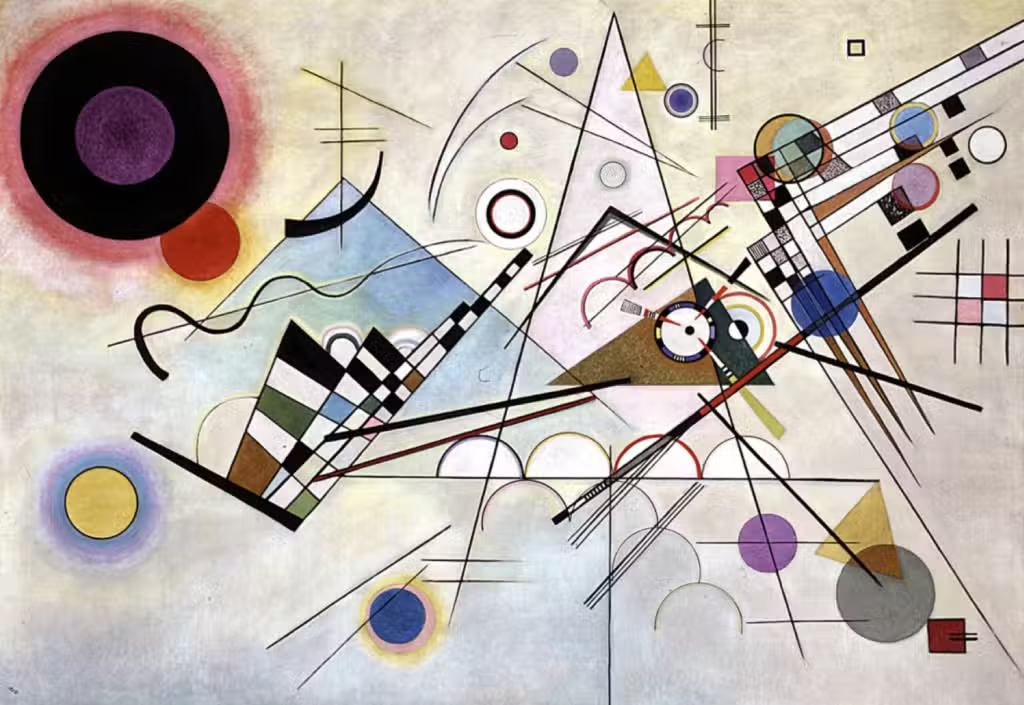
60- Composition VIII by Wassily Kandinsky
Composition VIII, created by Wassily Kandinsky in 1923, is a seminal work in geometric abstraction and a key illustration of Kandinsky’s style during his tenure with the Bauhaus. This painting is celebrated for its dynamic structure and visual innovations in abstract art.
The painting features a complex abstract composition characterized by bold use of geometric shapes, lines, and colors. Elements in the composition include circles, arcs, straight and curved lines, as well as rectangular and triangular forms, all interacting within a balanced and harmonious arrangement.
Kandinsky employs a vivid and contrasting color palette to accentuate the shapes and create a powerful visual impact. The colors are applied to establish dynamic relationships between geometric elements and areas of the canvas. The work explores depth and space through the layering of shapes and variation in sizes, creating a sense of movement and fluidity.
The composition is organized to guide the viewer’s eye through a complex network of forms and colors, inviting a visual and emotional exploration of the piece. Kandinsky’s use of abstraction allows him to express ideas and emotions in a non-figurative manner, providing a visual experience that transcends traditional representations of the physical world.
Composition VIII is housed at the Guggenheim Museum in New York. This work is often admired for its innovative approach to geometric abstraction and its ability to capture abstract concepts through technical mastery and marked aesthetic sensitivity.

61- Cleopatra by John William Waterhouse
Cleopatra, painted by John William Waterhouse in 1888, exemplifies Waterhouse’s skill in historical and mythological painting, highlighting his fascination with powerful and enigmatic female figures.
The painting depicts Cleopatra VII, the last queen of Egypt, in a dramatic and emblematic moment of her life. Cleopatra is portrayed in an elegant and dramatic pose, adorned with sumptuous garments and surrounded by exquisite jewelry. She is seated or reclining on a richly decorated divan or cushion, emphasizing her royal status and captivating beauty.
The scene is imbued with sensuality and luxury, with meticulous details of the fabrics and accessories capturing the opulence of the Egyptian court. The background often features oriental motifs and elaborate decorations, enhancing the exotic and historical atmosphere of the work.
The painting is also known for its depiction of Cleopatra’s death, alluding to the legend that she committed suicide by the bite of an asp. Cleopatra’s pose and expression are filled with melancholy and resignation, reflecting the themes of tragedy and fate that surround her historical figure.
Cleopatra is housed at the Tate Gallery in London. This work is admired for its technical mastery, historical detail, and ability to capture the grandeur and tragedy of one of the most famous figures in ancient history.

62- Circe Offering the Cup to Ulysses by John William Waterhouse
Circe Offering the Cup to Ulysses, painted by John William Waterhouse in 1891, is a work inspired by Greek mythology, showcasing Waterhouse’s fascination with mythological figures and epic narratives. This painting illustrates a famous episode from Homer’s Odyssey, featuring the enchantress Circe and the hero Ulysses (Odysseus).
The painting captures the moment when Circe, the powerful sorceress, offers a cup to Ulysses. Circe is depicted in an elegant and seductive pose, dressed in luxurious robes and adorned with jewels. Her presence is both enchanting and mysterious, accentuated by dramatic lighting and a mystical atmosphere. She extends the cup to Ulysses with an intriguing gaze, suggesting a blend of charm and danger.
Ulysses is portrayed as a determined and resolute figure, facing Circe’s offer with caution. The composition highlights the contrast between the seemingly innocent cup and Circe’s hidden intentions, adding a dramatic dimension to the scene.
The background is richly detailed with elements of Greek mythology and ornamental motifs that enhance the magical atmosphere of the scene. Waterhouse uses vibrant colors and sophisticated textures to emphasize the details of the clothing and accessories, creating a captivating and mysterious ambiance.
Circe Offering the Cup to Ulysses is housed at the Walker Art Gallery in Liverpool. This work is often admired for its dramatic and sensual portrayal of the myth, as well as Waterhouse’s technical mastery in creating an enchanting and richly detailed atmosphere.

63- Composition IX by Wassily Kandinsky
Composition IX, painted by Wassily Kandinsky in 1936, is a key work in the artist’s abstract style, marking an important stage in his exploration of color and form. This painting illustrates Kandinsky’s evolution toward a more complex and dynamic abstraction, while maintaining his interest in the interplay between music and emotions in art.
The painting is characterized by a complex and energetic composition, filled with various geometric forms such as circles, triangles, and wavy lines. These elements are arranged to create visual balance while conveying a sense of movement and fluidity. Kandinsky experiments with the juxtaposition of vivid colors and diverse shapes to generate intense visual interaction.
The colors are applied with strong contrasts and rich hues, ranging from deep blues and bright reds to luminous yellows and soft greens. This colorful palette is used to highlight the forms and create visual depth, while fostering a dynamic emotional and visual experience.
The composition also incorporates elements of texture and layering to add a tactile dimension to the work, enhancing the sense of movement and animation. The geometric forms are arranged in a way that evokes a visual choreography, reflecting themes of rhythm and musicality that were significant to Kandinsky.
Composition IX is held in a private collection. This work is often admired for its ability to blend abstract elements with a harmonious and expressively visual composition, showcasing Kandinsky’s mastery in using abstraction to convey emotional and spiritual concepts.
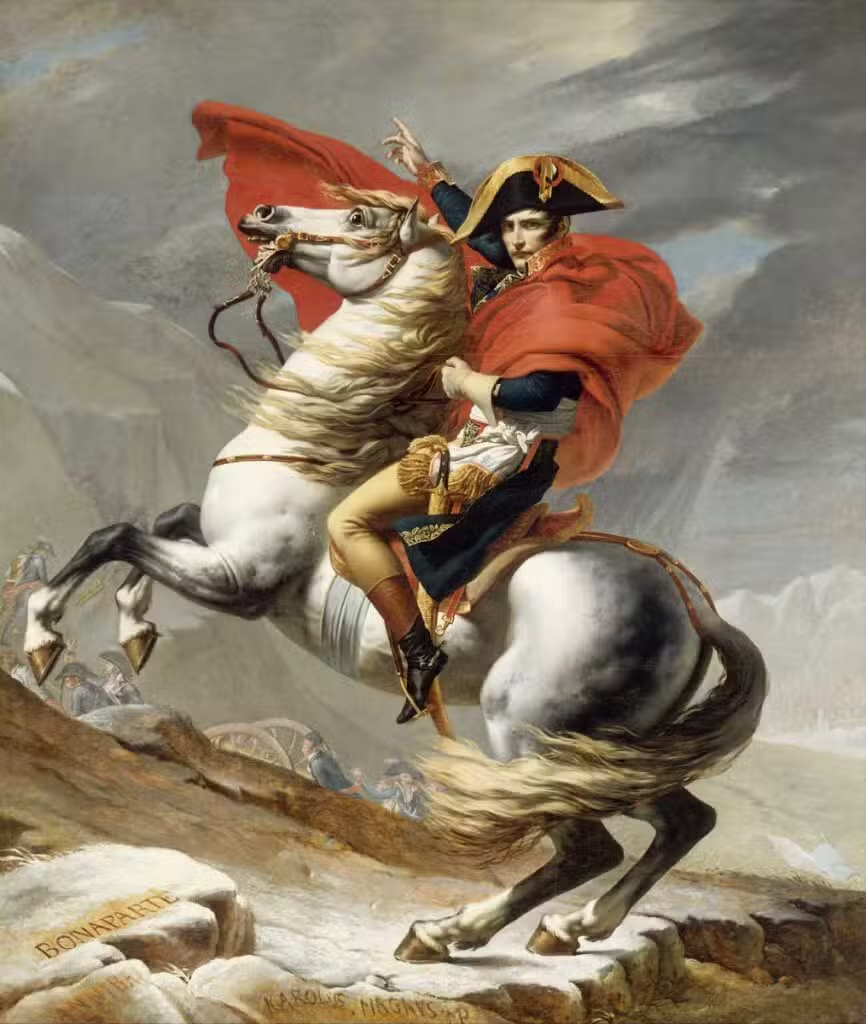
64- Bonaparte Crossing the Alps at the Saint-Bernard Pass by Jacques-Louis David
Bonaparte Crossing the Alps at the Saint-Bernard Pass, painted by Jacques-Louis David in 1800, is a monumental work celebrating Napoleon Bonaparte’s bold crossing of the Alps during the Italian campaign. This painting is one of David’s most famous works, showcasing his talent for historical portraiture and his adherence to the Neoclassical style.
The painting depicts Napoleon Bonaparte riding a horse with a commanding posture, crossing the Grand Saint-Bernard Pass under harsh conditions. Napoleon is shown in a heroic stance, dressed in his military uniform and wearing his iconic cloak. His expression is resolute and determined, reflecting the bravery and leadership he displayed during this expedition.
The Alpine landscape is portrayed with grandeur, featuring majestic snow-capped mountains in the background. David employs precise painting techniques to capture the texture of the snow, the rugged rocks, and the severe weather conditions, creating a striking contrast with the central figure of Napoleon.
The artwork is also notable for its symbolic use of light and shadow, highlighting Napoleon’s figure while emphasizing the vastness and difficulty of the terrain he is traversing. The painting celebrates Napoleon’s strength, determination, and ability to overcome obstacles, glorifying his role as a military leader.
Bonaparte Crossing the Alps at the Saint-Bernard Pass is held in the Musée du Louvre in Paris. This work is often admired for its impressive historical composition and its ability to capture the spirit of conquest and ambition of Napoleon, while demonstrating David’s technical mastery in depicting dramatic and heroic scenes.
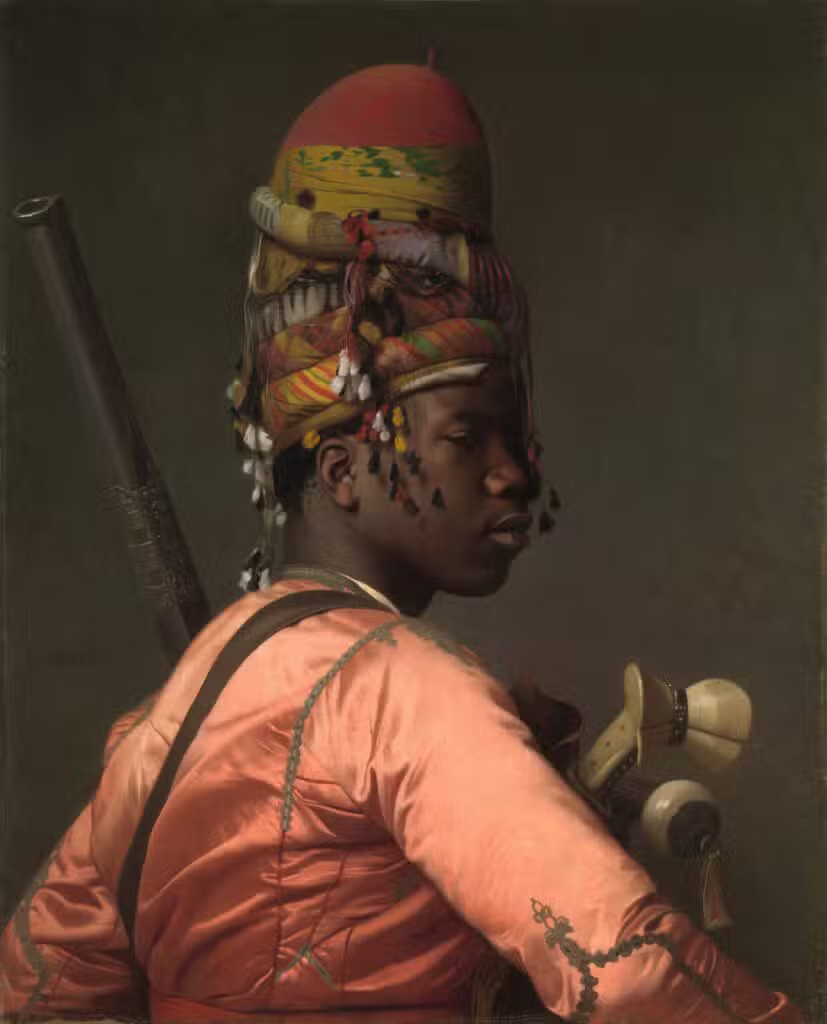
65- Bashi-Bazouk by Jean-Léon Gérôme
Bashi-Bazouk, painted by Jean-Léon Gérôme in 1869, is a quintessential work that captures the exoticism and cultural complexity of the East, a recurring theme in Gérôme’s oeuvre. The term “Bachi-Bouzouk” refers to irregular soldiers of the Ottoman Empire, known for their often unruly and undisciplined behavior.
The painting depicts a Bachi-Bouzouk, an Ottoman soldier, in traditional attire. The figure is shown in a dynamic pose, adorned with elaborate clothing and typical military accessories of the Ottoman dress. Emphasis is placed on the intricate details of the garments, weapons, and decorations, showcasing the richness and complexity of Ottoman costumes.
The background often features an elaborate Oriental scene, with architectural elements and decorative patterns typical of the Ottoman Empire. Gérôme uses rich colors and detailed painting techniques to create a contrast between the character and his environment, highlighting the visual richness and cultural depth of the scene.
The composition is balanced and meticulously orchestrated, with particular attention to detail and texture, reflecting Gérôme’s interest in historical accuracy and realistic representation of Eastern cultures. The painting captures both the individual character of the Bachi-Bouzouk and the general atmosphere of military life in the Ottoman Empire.
Bashi-Bazouk is held at the Musée d’Orsay in Paris. The work is often admired for its detailed rendering and realistic approach to the subject, illustrating Gérôme’s ability to combine meticulous observation with a sense of Eastern exoticism and mystery.
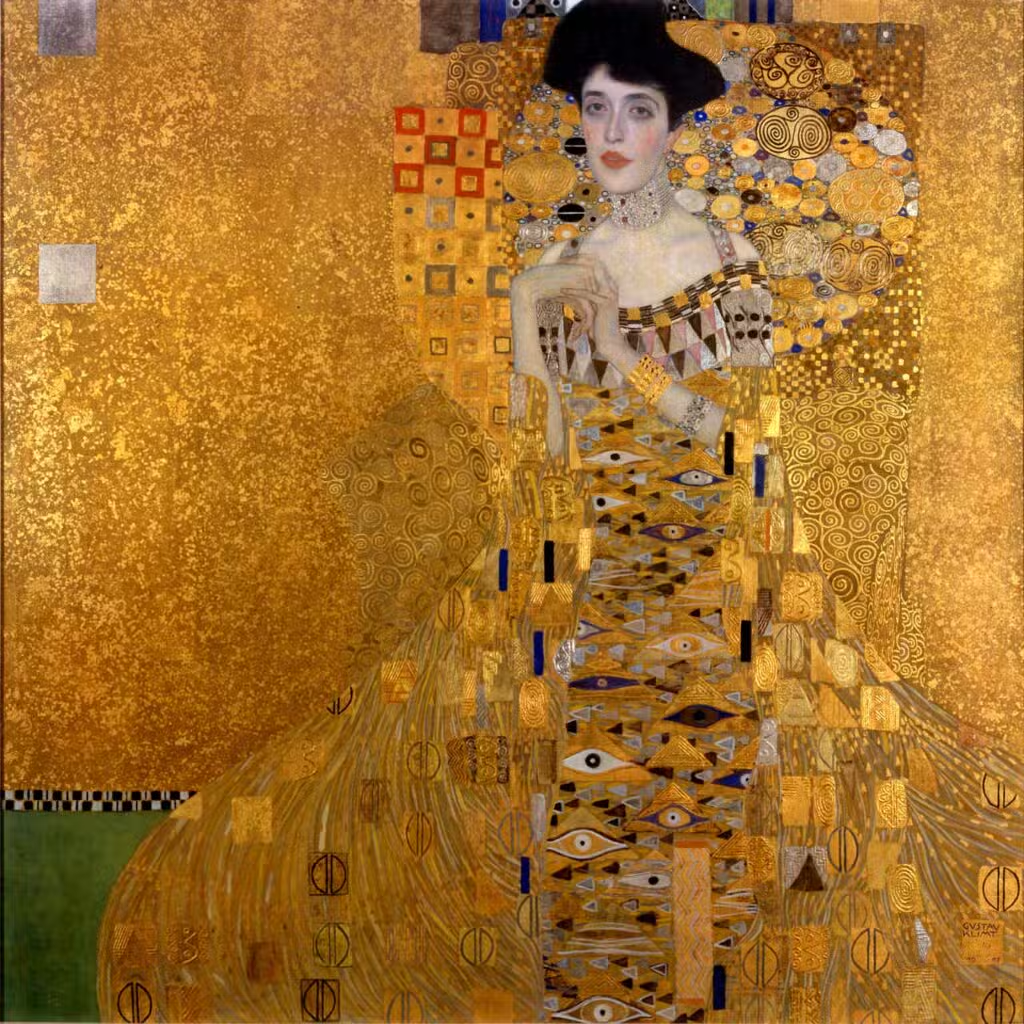
66- Portrait of Adele Bloch-Bauer by Gustav Klimt
Portrait of Adele Bloch-Bauer, painted by Gustav Klimt in 1907, is one of the artist’s most famous and iconic works. This sumptuous portrait is part of Klimt’s golden phase, where he incorporates Byzantine techniques and golden motifs to create luxurious and ornamental compositions. The painting is also known as The Woman in Gold.
The portrait depicts Adele Bloch-Bauer, a prominent figure in Viennese high society and the wife of a significant industrialist. She is shown seated, adorned in sumptuous robes and jewelry, with a gaze that is both mysterious and elegant. Klimt uses geometric patterns and organic forms, such as spirals, triangles, and mosaics, to decorate the composition. The background and Adele’s dress seem to merge into a whirl of golden and ornamental patterns, creating a rich and captivating visual effect.
The color palette is dominated by gold and yellow, symbols of wealth and beauty, as well as spirituality. Adele’s delicately painted face contrasts with the opulence of the background, highlighting her deep gaze and enigmatic expression. This contrast between the human figure and decorative elements is one of the hallmarks of Klimt’s style.
Portrait of Adele Bloch-Bauer has a fascinating history, linked to its acquisition by the Nazi regime during World War II and its restitution to Adele Bloch-Bauer’s heirs decades later. Today, the painting is held at the Neue Galerie in New York and is often admired for its masterful combination of figurative and decorative art, as well as its significant role in art and cultural history.
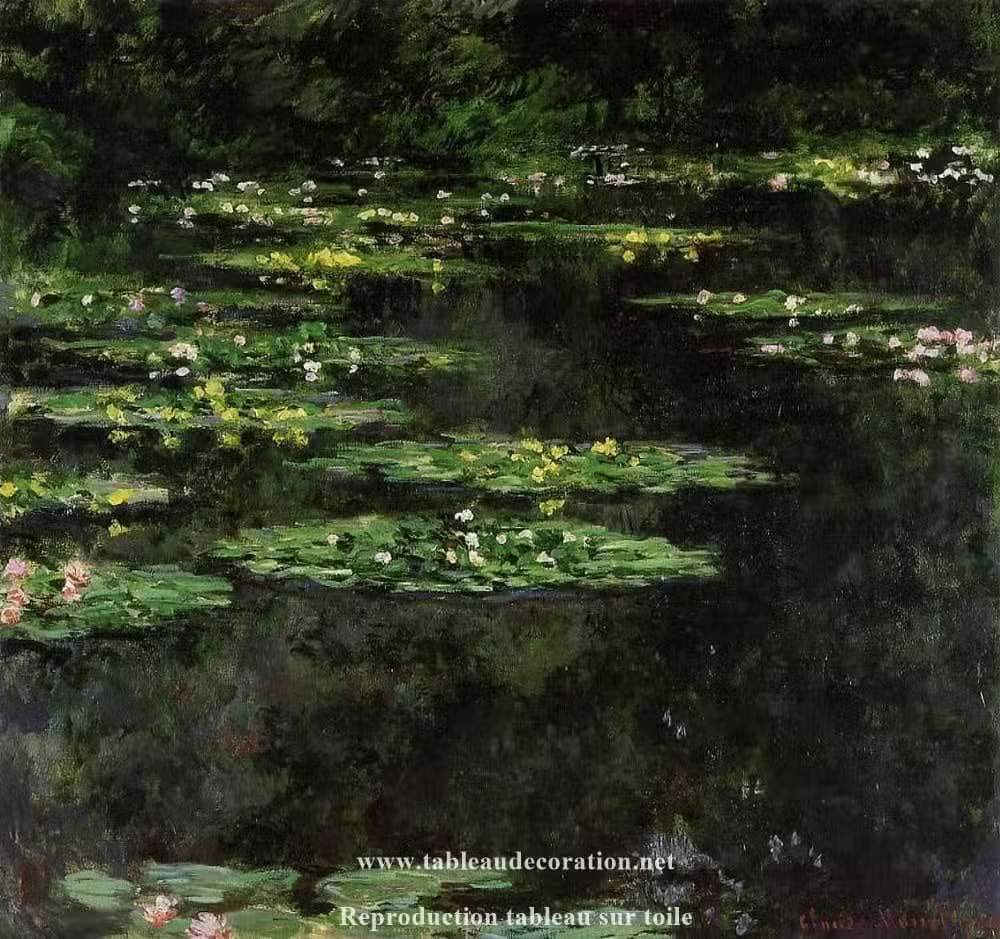
67- Black Water Lilies by Claude Monet
Monet, a pioneer of Impressionism, created numerous paintings depicting his garden in Giverny, with a particular focus on the famous water lilies floating on the water. This series, known as Nymphéas, explores the constant changes in nature and the effects of light on aquatic landscapes, characterized by broad brushstrokes, gentle colors, and an ability to capture the ephemeral.
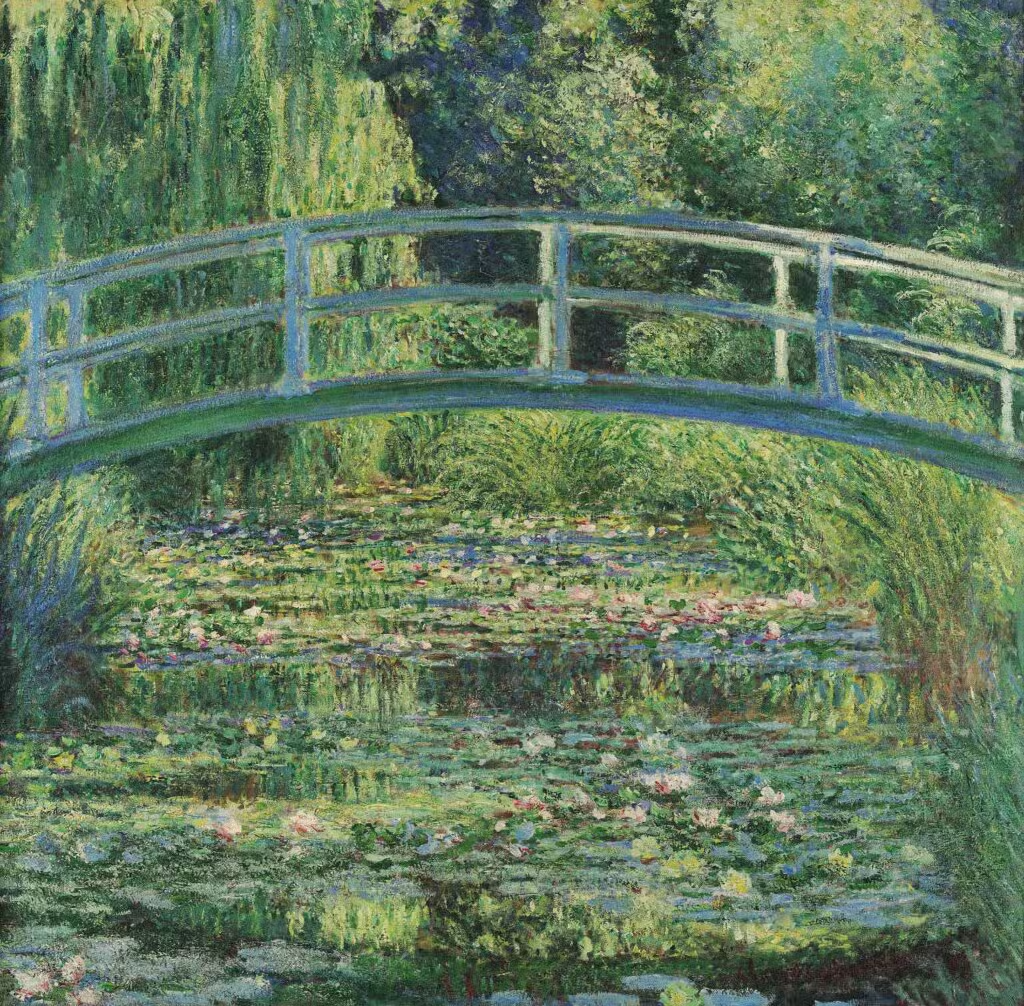
68- Water Lilies and Japanese Bridge by Claude Monet
Water Lilies and Japanese Bridge, painted by Claude Monet around 1899, is one of the artist’s iconic works that depicts his garden in Giverny, where he spent his later years. This painting is part of Monet’s extensive series focusing on water lilies and the Japanese bridge, capturing the evolving light and seasons in his aquatic garden.
The painting features a wooden arched Japanese bridge painted green, spanning a pond filled with water lilies. The bridge, inspired by the Japanese prints Monet collected, is surrounded by lush vegetation, including weeping willows and trees reflected in the calm pond water. The water lilies float gently on the surface, adding touches of white, pink, and yellow to the color palette.
Monet employs an Impressionist technique characterized by fluid, light brushstrokes that suggest reflections, shadows, and light playing on the water and vegetation. The sunlight, captured at different times of the day, bathes the scene in shifting hues, creating a peaceful and immersive atmosphere.
Water Lilies and Japanese Bridge illustrates Monet’s quest to represent the ephemeral and intangible, particularly the effects of light and seasons on nature. Like many other works in the Nymphéas series, this painting invites meditative contemplation, where the boundary between reality and abstraction becomes blurred.
This artwork, along with other pieces from the Nymphéas series, is displayed in various museums around the world, with notable examples at the Musée d’Orsay in Paris and the Metropolitan Museum of Art in New York.

69- The Three Ages of Woman by Gustav Klimt
“The Three Ages of Woman,” painted in 1905 by Gustav Klimt, is a major work that explores themes of femininity, the cycle of life, and mortality. True to his distinctive style, Klimt combines symbolism and ornamentation to create a composition that is both intimate and universal.
The painting depicts three female figures, representing the three stages of life: childhood, maturity, and old age. At the center of the work, a young woman, embodying maturity, holds a sleeping child in her arms. The tenderness and softness of this scene are accentuated by the floral patterns and warm colors that surround the two figures.
To the right, an elderly woman, bent and nude, stands alone, symbolizing old age. In contrast to the vibrant colors and floral motifs surrounding the mother and child, this figure is enveloped in darker and more austere hues, illustrating the transition toward the end of life. Her posture and expression evoke the solitude and vulnerability often associated with old age.
The golden ornaments and decorative patterns, typical of Klimt’s style, add a spiritual dimension to the scene, highlighting the contrast between the fleeting beauty of youth and the inevitability of aging.
“The Three Ages of Woman” is housed at the National Gallery of Modern Art in Rome. This work is admired for its symbolic depth and its poetic approach to universal themes related to the human condition.
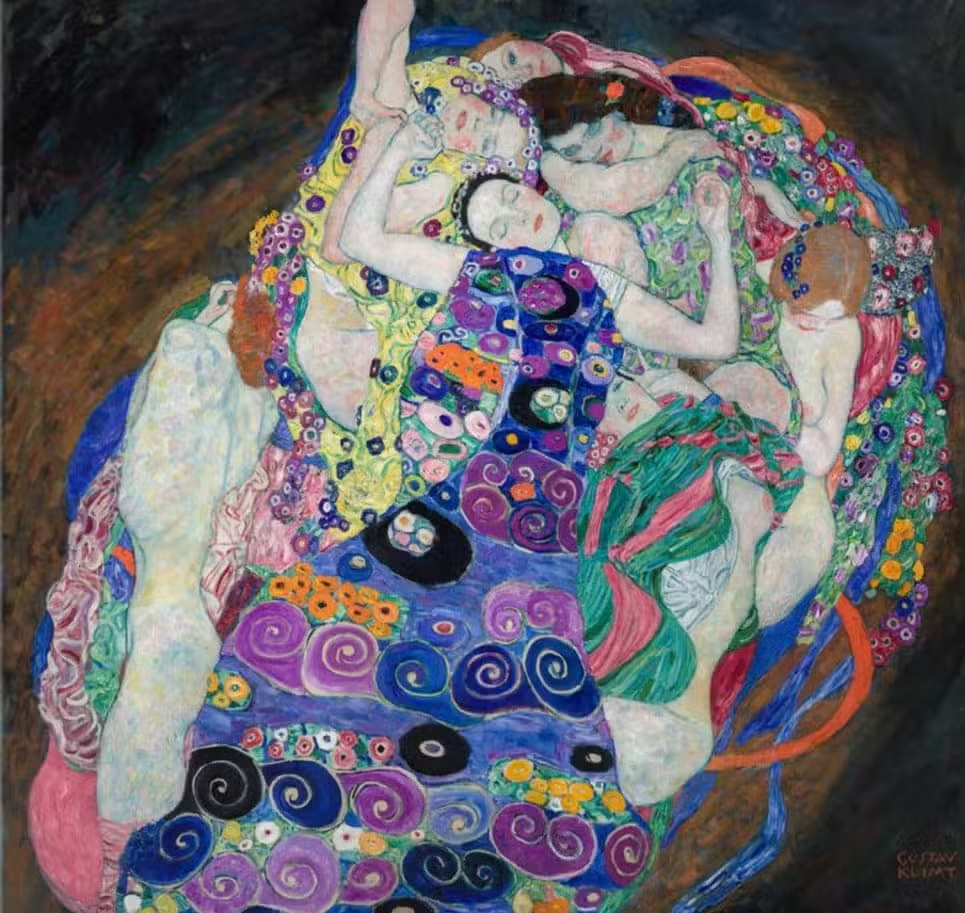
70- The Maidens by Gustav Klimt
“The Maidens,” painted in 1913 by Gustav Klimt, is a vibrant work that delves into themes of femininity, youth, and sensuality through a rich and colorful symbolic language. With its mesmerizing composition and lush motifs, this painting perfectly embodies Klimt’s ornamental and dreamlike style.
The work depicts a group of six young, nude women, reclining and intertwined in a circular arrangement. Their bodies seem to float in a whirlpool of fabric with colorful patterns and intricate decorative elements, creating an atmosphere that is both intimate and surreal. The women, with their serene and dreamy expressions, are surrounded by a richly adorned background of floral and geometric motifs, characteristic of the Art Nouveau style that Klimt helped define.
The colors are vibrant and dynamic, featuring tones of red, purple, blue, yellow, and gold, which enhance the energy and vitality of the scene. The women’s poses, delicately interwoven, suggest a kind of mystical dance or ritual, reinforcing the idea of a feminine inner world filled with desires, dreams, and sensuality.
The painting can be seen as a celebration of femininity, youth, and beauty, but it also holds a more symbolic dimension, suggesting transitions between different states of consciousness and experience, or even different stages of life.
“The Maidens” is housed at the National Gallery in Prague. The work is admired for its visual complexity, dynamic color, and the way Klimt combines decorative elements with emotional and psychological depth.

71- The Garden of Earthly Delights by Hieronymus Bosch
“The Garden of Earthly Delights,” painted by Hieronymus Bosch between 1490 and 1500, is a monumental and enigmatic triptych that explores religious, moral, and symbolic themes through a series of fantastical and detailed scenes. This work, considered one of the most fascinating and complex of medieval painting, is filled with strange characters and creatures that reflect both the pleasures and dangers of the earthly realm.
The triptych consists of three main panels. The left panel represents the Garden of Eden, where God introduces Eve to Adam in a paradisiacal landscape populated by exotic animals and mythological creatures. This scene illustrates the moment of Creation, imbued with innocence and purity.
The central panel, which gives the work its title, depicts a world of earthly pleasures where human figures indulge in hedonistic activities amidst lush nature. This panel is brimming with symbols of temptation and excess, featuring scenes of revelry, carnal love, and bizarre behaviors. The fantastical landscape is populated with hybrid creatures, giant plants, and surreal structures, creating an environment that is both captivating and unsettling.
The right panel, in stark contrast to the others, represents the torments of Hell. This dark and chaotic scene shows damned souls undergoing punishments for their sins. Bosch’s Hell is filled with grotesque demons, torture devices, and desolate landscapes, offering an apocalyptic vision of the consequences of sin and debauchery.
Overall, the work is interpreted as a reflection on human frailty, temptation, and morality, blending religious elements with a rich and imaginative imagery. “The Garden of Earthly Delights” is housed at the Prado Museum in Madrid, where it continues to captivate and intrigue viewers with its intricate details, disturbing scenes, and numerous possible interpretations.

72- The Yellow Tiger by Franz Marc
“The Yellow Tiger,” painted in 1912 by Franz Marc, is one of the major works by the German artist and co-founder of the expressionist movement Der Blaue Reiter. Franz Marc is renowned for his vibrant and symbolic representations of animals, which he saw as embodiments of purity and natural harmony.
In “The Yellow Tiger,” Marc depicts a stylized tiger coiled upon itself, poised to pounce. The tiger’s body is rendered in curved and angular lines, creating a dynamic sense of tension and movement. The color palette is bold, featuring vivid shades of yellow, orange, and red, contrasted with deep greens and blues. These striking and contrasting colors are characteristic of expressionism, where emotion and symbolism take precedence over realistic representation.
The tiger, a symbol of power and vitality, is integrated into a natural environment composed of stylized geometric shapes. These forms suggest mountains, trees, and rocks but are simplified and abstracted, creating a world where nature is transformed into a composition of pure energy.
Marc viewed animals as spiritual symbols, and in this work, the tiger embodies both raw strength and a certain serenity, blending into a landscape that seems to pulsate with the same rhythm as the animal. “The Yellow Tiger” is a celebration of nature in its most essential and spiritual form, capturing the vital energy that animates all creatures.
This work is now housed at the Städtische Galerie im Lenbachhaus in Munich, where it continues to be admired for its bold use of color and its symbolic vision of nature.

73- The Kiss by Gustav Klimt
“The Kiss,” painted by Gustav Klimt between 1907 and 1908, is one of the most famous works of the artist and the Art Nouveau period. This painting perfectly embodies Klimt’s ornamental and symbolic style, with his characteristic use of gold leaf, intricate patterns, and decorative elements inspired by Byzantine art and mosaics.
The work depicts a couple in an intimate and passionate embrace. The man, dressed in a long robe adorned with geometric patterns, gently holds the woman’s head in his hands while kissing her cheek. The woman, enveloped in a cloak with floral patterns, seems to lose herself in the embrace, her eyes closed in a state of deep tranquility.
The golden and abstract background gives the scene a timeless and mystical atmosphere, as if the two figures are detached from the material world and suspended in a dreamlike space. The omnipresent gold adds a sacred and precious dimension to the scene, reinforcing the idea that this love is something divine and eternal.
The patterns and ornaments in the painting also reveal a contrast between masculine forms, represented by rectangles and angular motifs, and feminine forms, evoked by rounded and floral patterns. This contrast highlights the complementarity between the two figures, who come together in a moment of perfect unity.
“The Kiss” is often interpreted as a celebration of love in all its sensuality and spirituality. The work is part of the collection at the Belvedere Museum in Vienna, where it is admired for its visual beauty, rich symbolism, and its ability to capture the intensity of human love.
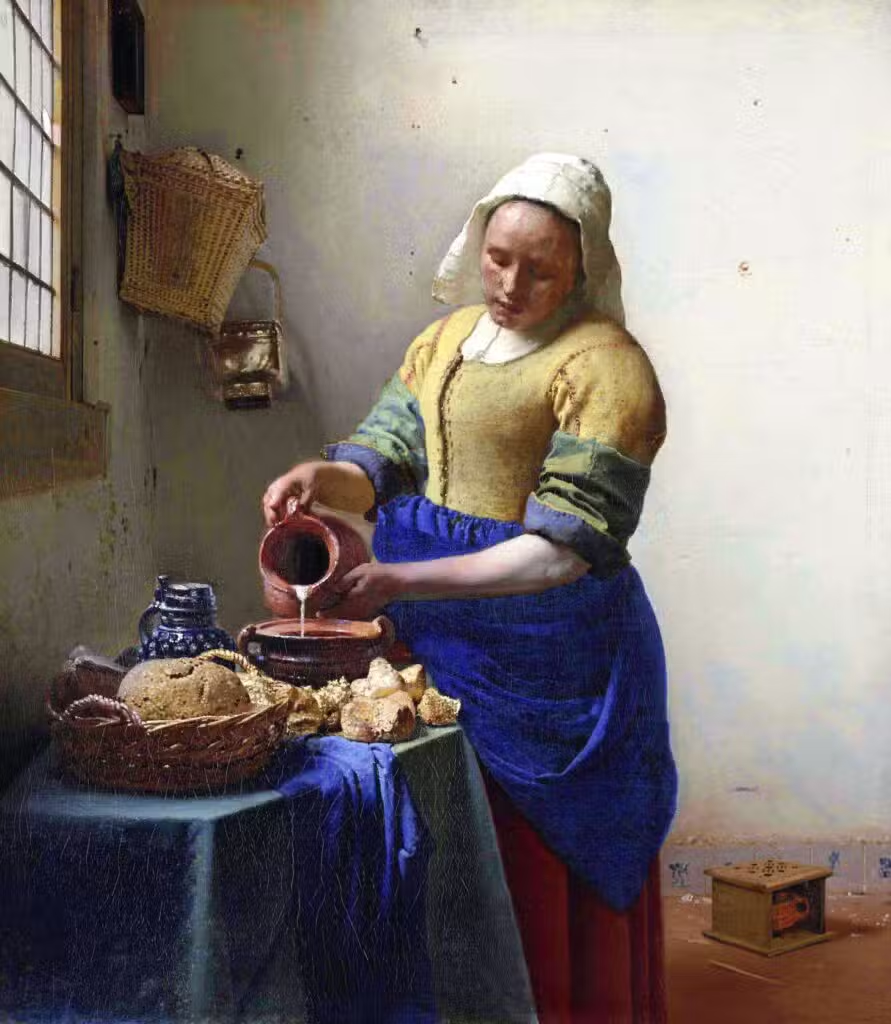
74- The Milkmaid by Johannes Vermeer
“The Milkmaid,” painted by Johannes Vermeer around 1658, is one of the most renowned works of the Dutch master from the Golden Age. This painting, depicting a simple domestic scene, stands out for its exquisite execution and the subtlety of light, hallmarks of Vermeer’s style.
The work portrays a young woman, likely a servant, pouring milk into a container, absorbed in her task. She is shown standing near a table covered with a white cloth, on which bread and other kitchen utensils are arranged. Behind her, a simple, uncluttered wall features a window that allows soft light to flood the scene, creating an atmosphere of calm and serenity.
The composition of the painting is both understated and masterful. Vermeer uses the natural light coming through the window to create subtle interplay of shadows and reflections, bringing life to every detail, from the folds of the milkmaid’s apron to the textures of the objects on the table. The colors, dominated by warm tones of yellow and blue, enhance the peaceful and harmonious character of the scene.
Although the scene appears simple, “The Milkmaid” is often interpreted as a celebration of daily life and humble work. Vermeer manages to transcend the ordinary by imbuing it with a quiet dignity and timeless beauty.
The work is housed at the Rijksmuseum in Amsterdam, where it continues to captivate visitors with Vermeer’s technical mastery and his ability to capture the essence of seemingly mundane moments with extraordinary sensitivity.
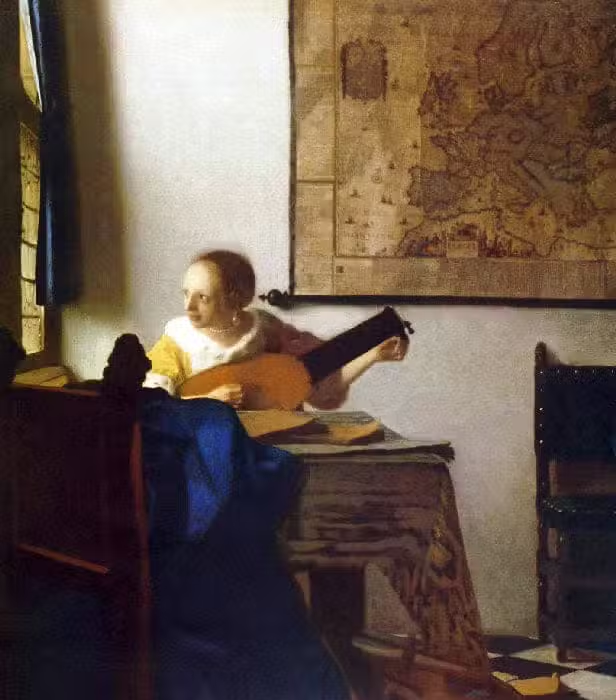
75- The Woman with a Lute by Johannes Vermeer
“The Woman with a Lute,” painted by Johannes Vermeer around 1662-1664, is another iconic work by the Dutch artist, featuring a female figure in a domestic interior, a recurring theme in his oeuvre. Vermeer, renowned for his mastery of light and balanced compositions, captures a moment of intimacy and contemplation here.
The painting depicts a young woman sitting near an open window, holding a lute, a popular musical instrument of the time. She gazes into the distance, appearing to dream or wait for someone, while a map of the world hangs on the wall behind her, evoking themes of discovery and exploration. The soft light coming through the window illuminates the scene, creating subtle contrasts and play of shadows on her face, clothing, and the instrument.
Vermeer’s color palette, as often, is dominated by shades of yellow, blue, and white, which add to the visual harmony of the scene. The meticulous details of the folds in the woman’s clothing, the wood of the lute, and the texture of the map showcase Vermeer’s precision and finesse as a painter.
“The Woman with a Lute” is sometimes interpreted as an allegory of love or aspiration, with music often symbolizing these themes. The woman’s relaxed posture and thoughtful gaze suggest an atmosphere of tranquility, contemplation, and anticipation.
This work, now housed at the Metropolitan Museum of Art in New York, is admired for its delicate intimacy and Vermeer’s ability to capture light and emotion in a domestic scene, transforming an everyday moment into a poetic and timeless vision.

76- The Astronomer by Johannes Vermeer
“The Astronomer,” painted by Johannes Vermeer around 1668-1669, is one of the most intriguing works by the Dutch artist, highlighting his talent for indoor scenes and his interest in science and knowledge. This painting is part of a series of Vermeer’s works depicting scholars and scientists and is often associated with “The Geographer,” another work of a similar genre.
The painting depicts an elderly astronomer, dressed in a richly decorated robe, leaning over a celestial globe. The man is seated at a table adorned with maps and scientific instruments, his gaze fixed on the globe as if he is delving into the mysteries of the universe. Soft light coming through a window on the left illuminates the scene, creating a delicate interplay of shadows on the astronomer’s face and the surrounding objects.
The work is characterized by its precise use of light and color, with a palette dominated by tones of blue, yellow, and brown. The quality of the light, as well as the meticulous rendering of the textures of the clothing and objects, attests to Vermeer’s technical mastery. The details of the scientific instruments and the celestial globe are painted with great precision, reflecting the period’s interest in science and astronomy.
“The Astronomer” can be seen as a celebration of the quest for knowledge and discovery. The astronomer’s focused demeanor and the tools around him evoke an atmosphere of intellectual reflection and scientific exploration.
The work is housed at the Louvre in Paris, where it is admired for its sensitive handling of light and its subtle evocation of the intellectual and scientific curiosity that characterized the Dutch Golden Age.

77- Flaming June by Frederic Leighton
“Flaming June,” painted by Frederic Leighton in 1890, is a masterful work by the British artist, often known by the title “June Flamboyante.” This painting is one of the most famous examples of Leighton’s academic style, depicting both an exotic and idyllic scene.
The painting portrays a woman asleep in a rich orange drapery, resting in a lush, blooming garden. The woman, dressed in a light gown of vibrant colors, lies on a couch or a chaise longue, her eyes closed and her head slightly tilted. Her deep brown hair is spread around her, enhancing the effect of tranquility and rest. The golden light bathing the scene highlights the vibrant colors of the gown and the surrounding flowers, creating a warm and serene atmosphere.
Leighton’s style is characterized by great precision in rendering textures and details, whether in the flow of fabrics or the richness of floral patterns. The composition is balanced and harmonious, with a particular focus on color use to evoke a sense of warmth and exoticism. The color palette, dominated by shades of red, orange, and gold, reinforces the impression of summer warmth.
“Flaming June” is often interpreted as a celebration of beauty and tranquility, a visual homage to the splendor and richness of summer months. The painting captures the elegance and sensuality of a moment of rest while showcasing Leighton’s technical mastery in depicting fabrics and landscapes.
The work is housed at the Museo de Arte de Puerto Rico, where it continues to be admired for its aesthetic beauty and sophisticated style.
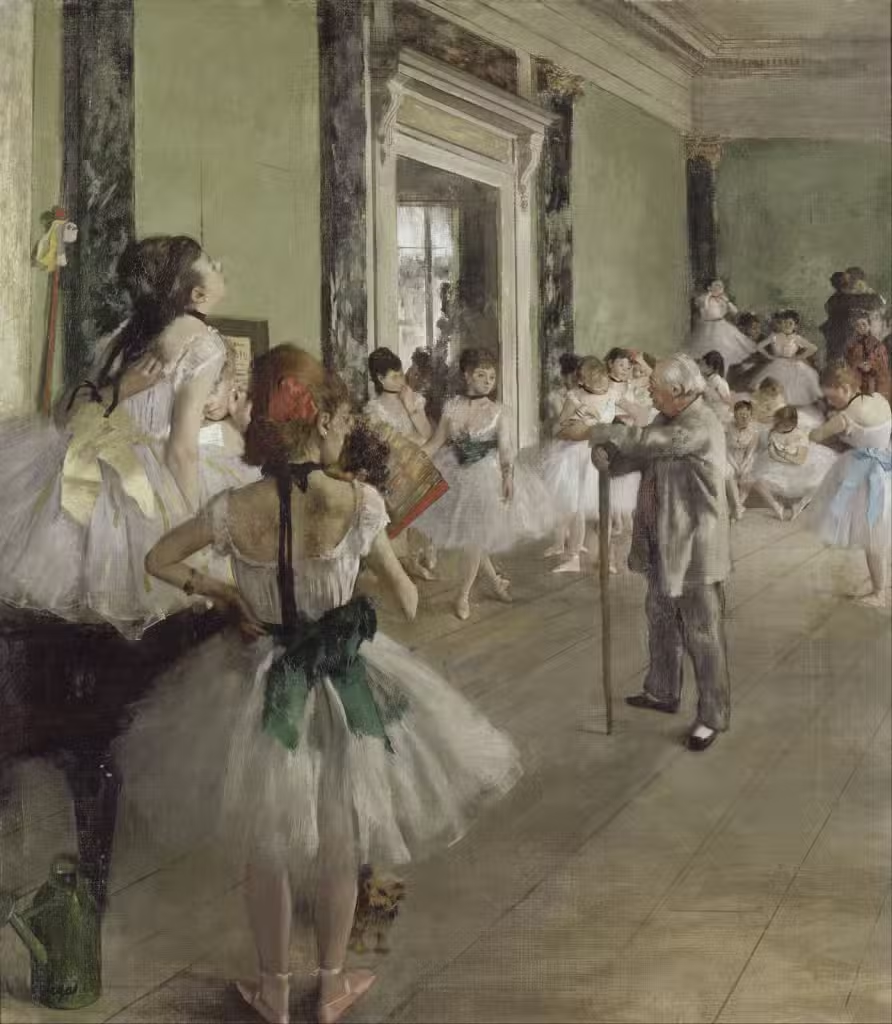
78- The Dance Class by Edgar Degas
“The Dance Class,” painted by Edgar Degas around 1874, is one of the artist’s most iconic works, celebrated for its depictions of the ballet world. This painting perfectly illustrates Degas’s interest in the daily life of ballerinas and his skills in composition and movement representation.
The painting shows a scene in a dance studio where a group of young ballerinas, dressed in white tutus, is rehearsing under the supervision of their ballet master. The composition is dynamic and deliberately chaotic, capturing the energy and disorder of the dance class. The ballerinas are portrayed in various poses and postures, with some waiting their turn, others practicing, or resting.
Degas employs a palette of soft, natural colors, including shades of pink, white, and beige, to create a warm and intimate atmosphere. The light filtering through the large windows of the studio adds highlights to the ballerinas’ costumes and the parquet floor, emphasizing the details of their movements and drapery.
The perspective and composition are also notable, with unusual angles and viewpoints that give the impression of being a hidden observer, discreetly watching the dancers in rehearsal. This approach allows Degas to capture moments from the ballerinas’ lives with great precision and particular sensitivity.
“The Dance Class” is often considered a masterpiece of the Impressionist style, not only for its innovative technique but also for its ability to convey the energy and beauty of the ballet world. The work is housed at the Musée d’Orsay in Paris, where it is admired for its unique and intimate portrayal of dancers’ lives.

79- The Lady with the Fan by Gustav Klimt
“The Lady with the Fan,“ painted by Gustav Klimt in 1910, is a signature work of the Austrian artist, showcasing his distinctive style and attention to ornamental details. This painting depicts an elegant and enigmatic woman, characteristic of the sophisticated and aesthetic world Klimt frequently explored in his art.
In the painting, a woman in an opulent gown is seated, holding a fan in her hands. The composition centers on the female figure, whose face is partially visible through the delicate veil covering her hair. Her posture is graceful and refined, enhanced by the use of decorative patterns and textures in her gown.
The woman’s dress is adorned with geometric and floral patterns, as well as touches of gold, which add a luxurious dimension to the work. The background is also richly decorated, featuring complex patterns and golden hues that create an opulent and enchanting atmosphere. The color palette uses warm and golden tones, perfectly in harmony with the Art Nouveau style Klimt mastered.
“The Lady with the Fan” is often seen as a representation of femininity and sophistication, with a particular focus on elegance and visual richness. The painting exemplifies Klimt’s ability to blend symbolism and ornamentation with a sensitivity to detail, transforming a simple figure into a masterful work of art.
The work is held in a private collection but continues to captivate art enthusiasts with its refined aesthetic and distinctive approach to depicting femininity.

80- Napoleon on the Imperial Throne by Jean-Auguste-Dominique Ingres
“Napoleon on the Imperial Throne,” painted by Jean-Auguste-Dominique Ingres in 1806, is a majestic work that captures the grandeur and authority of Napoleon Bonaparte at the height of his power. This painting is one of the most famous portraits of the emperor and illustrates Ingres’s neoclassical style, known for its attention to detail and sense of grandeur.
The portrait depicts Napoleon seated on an elaborately adorned imperial throne, dressed in a sumptuous ceremonial robe in vibrant colors, including red and gold. The robe is embroidered with intricate patterns and golden details, symbolizing power and wealth. Napoleon is shown in a solemn pose, with a direct and assured gaze, reinforcing his image as the undisputed sovereign.
The throne and the background are meticulously decorated, highlighting the architectural elements and luxurious ornaments surrounding the emperor. The details of the decor, from the columns to the tapestries, are rendered with remarkable finesse, showcasing Ingres’s technical skill.
“Napoleon on the Imperial Throne” is not only a tribute to the emperor’s power but also a demonstration of Ingres’s mastery as a portraitist. The painting captures both Napoleon’s physical stature and moral authority, using neoclassical conventions to emphasize the historical and political significance of the subject.
The work is housed at the Musée de l’Armée in Paris, where it continues to be admired for its grandeur and precision, as well as for its role in visually documenting Napoleon’s reign.

81- Ophelia by John Everett Millais
“Ophelia,” painted by John Everett Millais in 1851, is an iconic work of the Pre-Raphaelite movement, a 19th-century British artistic movement that aimed to return to the sincerity and beauty of early Renaissance art. This painting depicts the tragic death of Ophelia, a character from William Shakespeare’s play “Hamlet,” who drowns in a stream.
The scene shows Ophelia floating in the water, surrounded by flowers, her hair splayed out and her clothes in disarray. Despite the tragedy of her death, the young woman’s face is serene, almost peaceful. Millais uses a delicate and natural color palette to render the water, flowers, and surrounding vegetation with meticulous precision. The details of the flowers, aquatic plants, and floating fabric are painted with great care, characteristic of the Pre-Raphaelite style.
The painting is renowned for its detailed realism and the melancholic beauty it conveys. Millais worked en plein air to capture the texture of the flowers and the reflection of light on the water, giving the painting a near-photographic quality. The composition is carefully orchestrated to create a scene that is both idyllic and tragic, contrasting natural beauty with the pain of loss.
“Ophelia” is often interpreted as an exploration of beauty in death and a reflection on the fragility of life. The painting is housed at Tate Britain in London, where it is admired for its technical mastery and its ability to evoke deep emotions through a scene from literature.
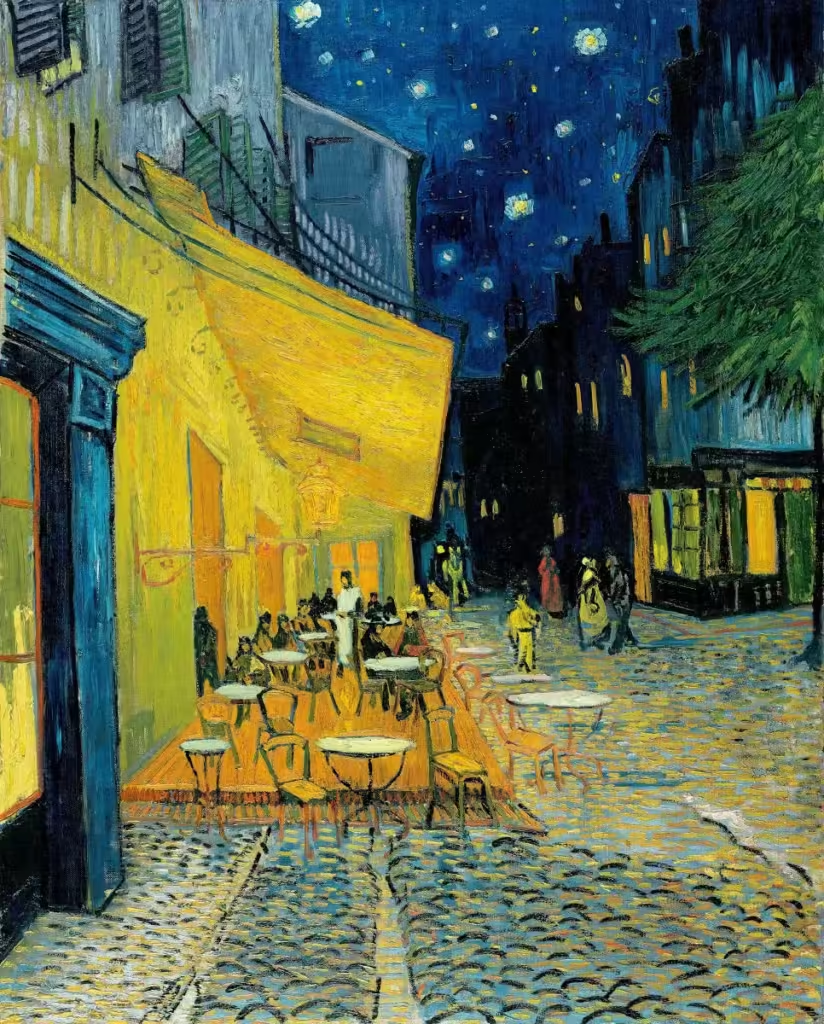
82- Café Terrace at Night by Vincent van Gogh
“Café Terrace at Night,“ painted by Vincent van Gogh in September 1888, is one of the most iconic works from the artist’s time in Arles, France. This painting captures the vibrant nighttime scene of a café terrace, showcasing Van Gogh’s ability to convey the energy and color of the night.
The painting depicts a café terrace illuminated by gas lamps, with patrons enjoying their evening. The architecture of the café is rendered in warm shades of yellow and orange, contrasting sharply with the deep blue, starry night sky. The cobblestone pavement and tables are bathed in the golden light from the lamps, creating a welcoming and lively atmosphere.
Van Gogh employs bold colors and energetic brushstrokes to create a luminous, textured effect. The swirling stars add a dynamic dimension to the sky, while the shadows cast by the structures and figures contribute to the vibrant and animated composition.
“Café Terrace at Night” is renowned for its innovative portrayal of nocturnal light and its expressive painting technique. The work reflects Van Gogh’s fascination with nightlife and the energy of the city, as well as his mastery of color and texture to evoke a unique and captivating ambiance.
The painting is housed at the Kröller-Müller Museum in the Netherlands, where it continues to be celebrated for its vivid and colorful depiction of an everyday scene transformed by Van Gogh’s artistic vision.

83- Venus Rising from the Sea by Jean-Léon Gérôme
“Venus Rising from the Sea,” painted by Jean-Léon Gérôme in 1880, is a notable work by the French artist, renowned for his realistic portrayals and Oriental scenes. This painting depicts a mythological scene inspired by the Roman goddess of love and beauty, Venus.
The painting features Venus emerging from the sea with the grace and elegance characteristic of classical representations of the goddess. Venus is shown in a sensual pose, with wet hair and extended arms, as if she is stepping out of a bath in the sea. She is surrounded by waves and seashells, creating an atmosphere of beauty and mystery.
Gérôme employs a soft and harmonious color palette to render the goddess’s luminous skin and the reflections of the water. The details of the waves, shells, and the underwater background are depicted with meticulous precision, showcasing Gérôme’s renowned realism. The textures of the water and the shades of blue and silver add depth and richness to the scene.
“Venus Rising from the Sea” is often interpreted as a celebration of feminine beauty and classical mythology. The painting is representative of Gérôme’s academic style, blending elements of realism with mythological and historical themes.
The work is held in a private collection but is admired for its beauty and attention to detail, as well as for its ability to capture the elegance and charm of classical mythology through a realistic technique.

84- A Bar at the Folies-Bergère by Édouard Manet
“A Bar at the Folies-Bergère,“ painted by Édouard Manet in 1882, is one of the artist’s major works, renowned for its audacity and innovation in portraying modern genre scenes. This painting captures the vibrant atmosphere and lively ambiance of the famous Parisian cabaret, the Folies-Bergère, a popular entertainment venue of the time.
The scene depicts a barmaid, dressed in a black gown and white apron, standing behind a counter amidst a crowd of patrons. Her face, turned towards the viewer, is marked by an expression of detachment and melancholy. The counter is adorned with bottles, glasses, and fruits, while the background features mirrors reflecting a partial view of the cabaret’s interior and its spectators.
Manet employs a vibrant and contrasting color palette to create depth and luminosity. The details of the objects on the counter are rendered with remarkable precision, while the reflections in the mirrors and the play of light add complexity to the composition. Manet’s technique, with visible brushstrokes and bold style, creates a dynamic and modern atmosphere.
“A Bar at the Folies-Bergère” is often interpreted as a reflection on themes of alienation and modernity in 19th-century urban society. The barmaid’s distant expression and the scene’s atmosphere highlight a contrast between the energy of the venue and the sense of isolation felt by the central figure.
The painting is housed at the Musée d’Orsay in Paris, where it is admired for its stylistic innovation and its honest portrayal of modern life, offering a fascinating glimpse into Parisian culture of the period.
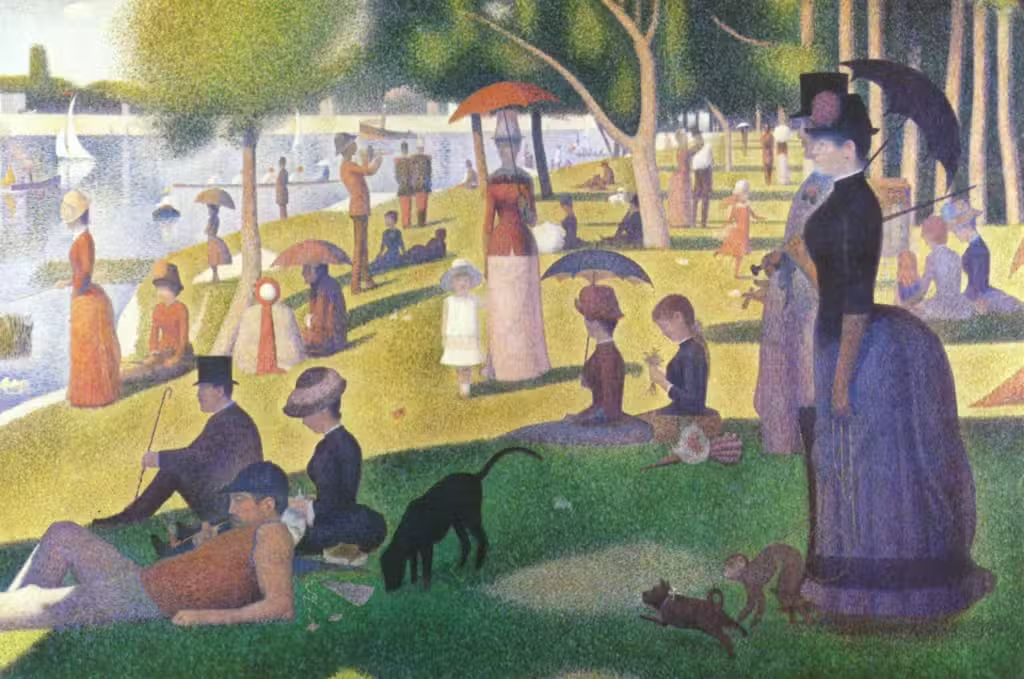
85- A Sunday Afternoon on the Island of La Grande Jatte by Georges Seurat
“A Sunday Afternoon on the Island of La Grande Jatte,” painted by Georges Seurat between 1884 and 1886, is one of the most iconic works of pointillism and a masterpiece of neo-impressionism. This monumental painting is renowned for its innovative technique and vibrant depiction of urban life in the 19th century.
The painting depicts a leisurely Sunday scene on the Île de la Grande Jatte, a recreational area along the Seine near Paris. The composition is rich in detail, featuring a variety of characters – men, women, children, and animals – strolling, resting, or enjoying outdoor activities. The island is portrayed with a soft color palette and diffuse light, creating a tranquil and idyllic atmosphere.
Seurat employs the technique of pointillism, applying distinct dots of color to create visual effects. The colors are arranged so that they blend optically when viewed from a distance, producing unique luminosity and texture. The figures and landscape elements are rendered with geometric precision, reflecting Seurat’s interest in color theory and the scientific principles of visual perception.
“A Sunday Afternoon on the Island of La Grande Jatte” is also known for its rigorous composition and harmonious balance. The painting is organized around a central axis, with groups of figures and landscape elements symmetrically arranged to create a sense of calm and serenity.
The artwork is housed at the Art Institute of Chicago, where it is widely recognized as a masterpiece of pointillism and a key example of artistic innovation at the end of the 19th century. It continues to be admired for its groundbreaking technique and captivating insight into Parisian life of the period.

86- On the Terrace by Pierre-Auguste Renoir
“On the Terrace“ (sometimes titled “The Café Terrace”), painted by Pierre-Auguste Renoir in 1876, is an emblematic work of Impressionism, showcasing the style and vibrant atmosphere of the movement. This painting is an excellent example of Renoir’s talent for capturing social life and human interactions with vivid light and color.
The painting depicts a scene of relaxation outdoors on a café or restaurant terrace, typical of Parisian life in the late 19th century. The figures, including an elegantly dressed woman and a man in a suit, are seated at a table, surrounded by an ambiance of conviviality and pleasure. Their faces are animated with expressions of contentment, and the interactions between the figures appear natural and spontaneous.
Renoir employs a vibrant color palette and soft lighting to create a joyful and intimate atmosphere. The brushstrokes are visible and fluid, capturing the texture of clothing, objects, and surfaces with great liveliness. Natural light, filtered through parasols or trees, plays a significant role in the composition, enhancing the nuances of color and the luminosity of the scene.
“On the Terrace” is also notable for its approach to portraiture and genre scene. Renoir skillfully combines elements of everyday life with artistic sensitivity, creating a work that offers both an insight into Parisian culture and an aesthetic expression of joie de vivre.
The artwork is housed at the Musée de l’Orangerie in Paris, where it is appreciated for its charming representation of society and its contribution to the evolution of the Impressionist style.
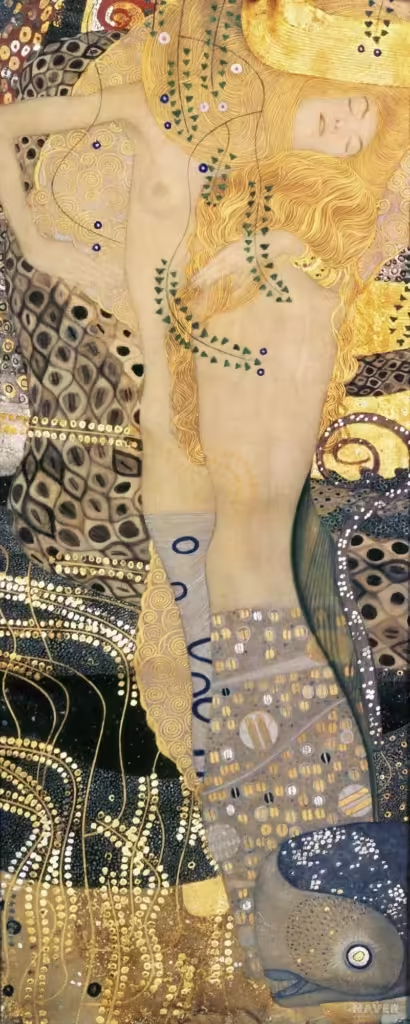
87- Water Serpent II by Gustav Klimt
“Water Serpent II“, painted by Gustav Klimt in 1904, is a remarkable piece that exemplifies his distinctive style and fascination with organic and symbolic motifs. This painting is part of Klimt’s series of works exploring themes of nature, sexuality, and mysticism.
The painting depicts a stylized aquatic serpent winding through a lush and decorative environment. The serpent is rendered with elaborate details and coiled patterns typical of Klimt’s style. It is often enveloped in golden motifs and rich textures, giving the artwork an opulent and enchanting quality.
The background of the painting is characterized by fluid forms and ornamental patterns that blend harmoniously with the serpent, creating a dynamic and elegant composition. Dominant colors include shades of blue, green, and gold, adding depth and richness to the scene. The use of gold and decorative patterns reflects influences from Art Nouveau and symbolist elements present in Klimt’s work.
“Water Serpent II” illustrates Klimt’s ability to integrate elements of nature and animal forms into highly stylized artistic compositions. The painting is an example of his exploration of themes of sensuality and beauty through a complex and ornate visual language.
The artwork is housed in a private collection and is often studied for its innovative representation and distinctive aesthetic, continuing to influence and inspire art enthusiasts and scholars.

88- After a Masquerade Ball by Jean-Léon Gérôme
After a Masquerade Ball, painted by Jean-Léon Gérôme in 1877, is a captivating work that showcases the artist’s flair for depicting the world of spectacle and mystery. Gérôme, known for his Oriental scenes and historical compositions, here turns his attention to a refined and elegant social setting.
The painting depicts figures exiting a masquerade ball, set in an opulent and sophisticated environment. The characters are dressed in elaborate costumes and masks typical of 19th-century masquerade events. The costumes are richly adorned, reflecting the style and grandeur of the era, with meticulous details highlighting Gérôme’s technical skill.
The background of the painting is also elaborate, featuring architectural elements and decorative motifs that contribute to the luxurious and mysterious atmosphere. The play of light and shadow is crucial in the composition, creating contrasts that enhance the figures and the details of the setting.
After a Masquerade Ball exemplifies Gérôme’s academic style, combining great precision in detail with a dramatic and elegant atmosphere. The painting captures the spirit of masquerade parties and the beauty of the setting, while providing a fascinating glimpse into the social culture of the time.
The work is held in a private collection but is admired for its refined representation and sophisticated artistic technique, reflecting Gérôme’s talent for capturing social scenes with remarkable depth and elegance.
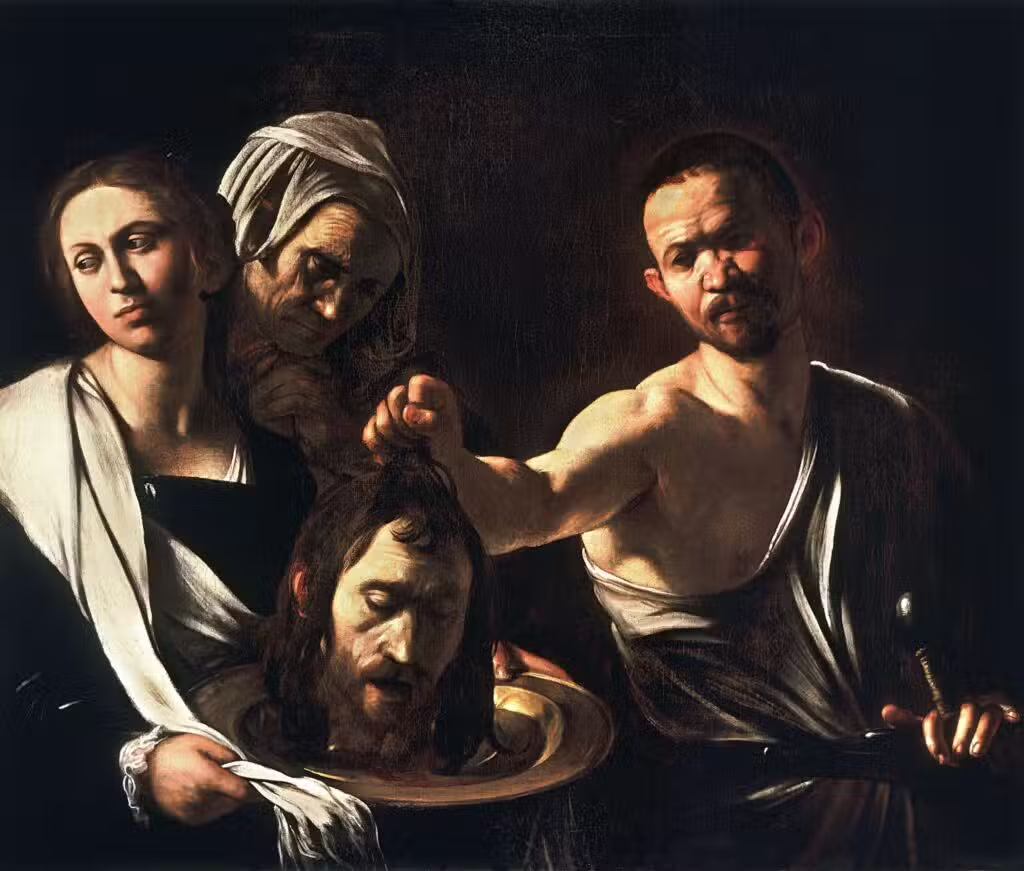
89- The Head of Saint John the Baptist by Caravaggio
The Head of Saint John the Baptist, painted by Caravaggio in 1608, is a striking work that showcases the artist’s mastery of dramatic realism and emotional intensity. The painting depicts the severed head of Saint John the Baptist, a powerful and evocative subject central to Caravaggio’s oeuvre.
The scene is rendered with raw realism and strong visual impact. The head of Saint John the Baptist, placed on a platter or support, is depicted with striking precision. The details of the face, illuminated by light and shadow, reveal an expression that is both serene and tragic. The half-closed eyes and slightly open mouth add a dimension of unsettling calm to the scene.
Caravaggio employs dramatic lighting and strong contrasts, characteristic of his use of chiaroscuro, to enhance the presence and emotional weight of the head. The light highlights the textures of the skin and anatomical details, while the deep shadows create a dark and mysterious atmosphere.
The painting is also notable for its meticulous composition. The head is centered on the canvas, immediately drawing the viewer’s eye, while the dark, sparse background focuses attention on the main subject.
The Head of Saint John the Baptist is often interpreted as a meditation on martyrdom and decapitation, reflecting themes of mortality and sacrifice present in Christian faith. The work exemplifies Caravaggio’s skill in realism and emotion, as well as his innovative approach to light and composition.
The painting is housed in the Galleria Borghese in Rome, where it is admired for its visual power and its contribution to the evolution of Baroque art.

90- Road with Cypress and Star by Vincent van Gogh
Road with Cypress and Star, painted by Vincent van Gogh in 1890, is a captivating work that illustrates the artist’s unique expressionism and innovative use of color and texture. This painting is a prime example of Van Gogh’s late style, characterized by dynamic brushstrokes and emotionally charged compositions.
The painting depicts a winding road through a rural landscape, with a majestic cypress tree standing prominently on the side. The tree, with its swirling forms and distinctive contours, dominates the composition, adding an element of grandeur and mystery to the scene. The road snakes through the field, guiding the viewer’s eye towards a horizon illuminated by a bright star or crescent moon, which lights up the nocturnal landscape.
Van Gogh employs a vivid and contrasting color palette, with deep blues, greens, and touches of yellow and orange to represent the light of the star. The brushstrokes are bold and energetic, creating a rich and dynamic texture that enhances the movement and emotion of the scene. The combination of swirling sky and cypress forms with the sinuous road creates a nearly dreamlike and surreal effect.
Road with Cypress and Star is often interpreted as an exploration of themes related to nature, the cosmos, and spiritual quest. The work reflects Van Gogh’s interest in natural phenomena and the mystical aspects of life, while showcasing his distinctive style and ability to capture the emotional essence of the landscape.
The painting is housed at the Van Gogh Museum in Amsterdam, where it is admired for its vibrant artistic expression and poignant depiction of the artist’s inner world.

91- Family Gathering by Frédéric Bazille
Family Gathering, painted by Frédéric Bazille in 1867, is a notable work by the French artist associated with the Impressionist movement. This painting captures a family reunion scene with a sensitivity and precision characteristic of Bazille’s work.
The painting depicts a group of the artist’s family members gathered in a domestic setting. Bazille pays close attention to detail and composition, highlighting the interactions and dynamics within the family. The figures are portrayed with great accuracy, their expressions and postures revealing a moment of conviviality and sharing.
The setting of the painting is bright, with a palette of vivid colors that reflects natural light. The characters’ clothing and elements of the décor are rendered with visible brushstrokes and touches of color, characteristic of the Impressionist style. The work is often marked by an atmosphere of intimacy and warmth, emphasizing familial bonds and daily life.
Family Gathering is also notable for its careful composition and attention to detail. Bazille incorporates decorative elements and patterns that enrich the scene while maintaining a harmonious balance between the figures and the setting.
The painting is housed at the Musée d’Orsay in Paris, where it is admired for its delicate portrayal of family life and its contribution to the development of the Impressionist style.

92- Paris Street, Rainy Day by Gustave Caillebotte
Paris Street, Rainy Day, painted by Gustave Caillebotte in 1877, is an iconic work of the Impressionist movement that showcases Caillebotte’s ability to capture urban life with a unique perspective and striking realism. This painting is renowned for its detailed and atmospheric depiction of a Parisian street in the rain.
The painting presents a view of a Paris street with pedestrians moving under umbrellas, and the wet cobblestones reflecting the light. Caillebotte employs an innovative perspective to create depth and dimension, placing the viewer at street level and offering an almost bird’s-eye view of the city scenes.
The umbrellas, both functional and decorative, add bright touches of color and movement to the composition. The rain is rendered with dynamic brushstrokes and shades of gray and blue, creating a damp and melancholic atmosphere. The reflections on the wet cobblestones are particularly noteworthy, illustrating Caillebotte’s interest in light effects and textures.
Paris Street, Rainy Day is also notable for its precision and attention to detail. The figures are depicted with great meticulousness, and the architecture of the buildings in the background is rendered with realistic accuracy.
The painting is housed at the Musée d’Orsay in Paris, where it is admired for its contribution to Impressionism and its vivid and poignant capture of Parisian urban life. The work is a perfect example of Caillebotte’s ability to blend realism with Impressionism to create an original and evocative representation of the city.

93- Saint John the Baptist by Leonardo da Vinci
Saint John the Baptist, painted by Leonardo da Vinci between 1513 and 1516, is one of the artist’s final masterpieces, created during his later years in France. This painting depicts Saint John the Baptist in a characteristic pose with an introspective expression, reflecting Leonardo’s mastery in portraiture and religious symbolism.
The painting shows Saint John the Baptist in bust, dressed in animal skins and holding a pilgrim’s staff with a cross. The saint is portrayed in backlight, with dramatically directed lighting that highlights the contours of his face and body. This light creates deep shadows and chiaroscuro effects, enhancing the emotional intensity of the portrait.
Saint John the Baptist’s expression is enigmatic and contemplative, with a faint smile reminiscent of Leonardo’s portraits like the Mona Lisa. The saint’s gaze is directed at the viewer with psychological depth, evoking both wisdom and solitude.
The work is painted on wood and uses a dark color palette, accentuated by touches of golden light that add depth and texture. Leonardo’s sfumato technique is clearly visible in the subtle blurring of contours and the smooth transitions between shadows and light.
Saint John the Baptist is housed at the Louvre Museum in Paris. This painting is a remarkable example of Leonardo da Vinci’s mature style and his talent for capturing the emotional and spiritual complexity of his subjects. The portrait is widely studied for its innovative treatment of light and detail, as well as its lasting impact on Renaissance art.

94- Return of Napoleon from Elba by Jacques-Louis David
Return of Napoleon from Elba, painted by Jacques-Louis David in 1815, is an iconic work that celebrates Napoleon Bonaparte’s triumphant return to France after his exile on the island of Elba. This painting captures a crucial moment in French history and reflects David’s neoclassical style and his talent for dramatic and heroic representation.
The painting depicts Napoleon arriving on French soil in March 1815, after escaping his exile. The composition prominently features Napoleon on his horse, surrounded by his supporters and enthusiastic troops. Napoleon’s determined expression and resolute posture are the focal points of the scene, reflecting his charisma and authority. The figures around him show visible admiration and allegiance, enhancing the impact of the leader’s return.
David employs a rich color palette and meticulous details to bring the scene to life. The costumes of the characters, the flags, and the decorative elements are rendered with great precision, adding to the sense of grandeur and solemnity. The lighting is directed toward Napoleon, creating a highlighting effect that emphasizes his central role in the event.
Return of Napoleon from Elba is also significant for its neoclassical style, with elements of rigorous composition and an emphasis on heroic grandeur. As Napoleon’s official painter, David captures the moment with dramatic intensity and stylistic exaggeration, underscoring the political and historical significance of Napoleon’s return.
The painting is housed at the Louvre Museum in Paris, where it is admired for its dynamic treatment of history and its visually striking representation of a key event of the Napoleonic era.

95- Portrait of Dr. Gachet by Vincent van Gogh
Portrait of Dr. Gachet, painted by Vincent van Gogh in 1890, is a seminal work that depicts the physician who cared for Van Gogh during his final weeks in Auvers-sur-Oise. This portrait is particularly significant as it captures not only the character of Dr. Gachet but also Van Gogh’s emotional state towards the end of his life.
The painting shows Dr. Paul Gachet seated in a simple yet evocative setting. The doctor is dressed in a dark jacket and has a contemplative expression that conveys melancholy and introspection. Van Gogh employs bold brushstrokes and vibrant colors to render the emotional aspect of the subject. The doctor’s face is marked by touches of blue and violet, adding a psychological dimension to his expression.
The background of the painting is also notable, with floral patterns that add texture and contrast to the composition. These decorative elements reflect Van Gogh’s distinctive style and his use of color and forms to express the subject’s state of mind.
Van Gogh created two versions of this portrait, one of which is housed at the Musée d’Orsay in Paris, and the other at the Van Gogh Museum in Amsterdam. Both versions portray Dr. Gachet similarly but with variations in color palette and details.
Portrait of Dr. Gachet is not only a depiction of an important individual in Van Gogh’s life but also an artwork that illustrates themes of human fragility and emotional connection. The portrait is considered a poignant example of Van Gogh’s artistic expression and is widely admired for its emotional depth and visual impact.

96- Ophelia by John William Waterhouse
Ophelia, painted by John William Waterhouse in 1894, is an iconic work of the Pre-Raphaelite movement that captures the romantic and tragic vision of the character Ophelia from William Shakespeare’s play Hamlet. The painting is renowned for its poignant and detailed depiction of Ophelia as she drowns in a lush natural setting.
The painting portrays Ophelia floating in water, surrounded by flowers and aquatic vegetation. Her face is serene and melancholic, contrasting with the implied violence of her drowning. The water, flowers, and plants are rendered with meticulous precision, showcasing Waterhouse’s attention to detail and texture. The vibrant colors of the flowers, such as cornflowers, roses, and daisies, add a touch of beauty and tragedy to the scene.
Waterhouse employs a delicate color palette and soft lighting to create a dreamlike and sorrowful atmosphere. The composition focuses on Ophelia, who is depicted with intricate details in her floating garments and hair, highlighting the ethereal and fragile nature of the character.
Ophelia visually illustrates a tragic moment from Shakespeare’s play, capturing the essence of desolation and beauty in the scene. The painting is also representative of the Pre-Raphaelite style, characterized by meticulous attention to detail, rich use of color, and sensitivity to literature and mythology.
The work is housed at the Tate Gallery in London, where it is admired for its visual beauty and emotional interpretation of Ophelia. The painting remains a striking example of Waterhouse’s talent for representing literary themes and Pre-Raphaelite aesthetics.

97- Pandemonium by John Martin
Pandemonium, painted by John Martin in 1841, is a spectacular work that depicts the infernal palace of the devil in a grandiose and dramatic vision. This painting is an exemplary representation of Martin’s Romantic style, known for its large-scale portrayals and visually impressive compositions.
The painting portrays “Pandemonium,” the palace of the devil as described in John Milton’s Paradise Lost. Martin uses dramatic perspective to illustrate a gigantic infernal landscape, featuring imposing architectural structures and interwoven demon forms in a chaotic scene. The painting is filled with elaborate details, including colossal columns, twisted arches, and an atmosphere of desolation and turmoil.
The colors are vivid and contrasted, with shades of red, orange, and black creating an impression of fire and destruction. Martin employs light and shadow effects to enhance the dramatic nature of the scene, with flashes of light and deep shadows adding to the visual intensity.
Pandemonium is notable for its ambition and scale. The painting represents a grand vision of hell, capturing the tumultuous and oppressive character of the place described by Milton. Martin is renowned for his ability to create scenes of epic grandeur and visual intensity, and Pandemonium is a striking example of his talent for dramatic representation and supernatural atmosphere.
The work is housed at the Tate Gallery in London, where it is admired for its embodiment of epic literary themes and its grand Romantic style.

98- Philosopher in Meditation by Rembrandt van Rijn
Philosopher in Meditation, painted by Rembrandt van Rijn around 1632-1634, is a captivating work that reflects the Dutch artist’s skill in representing intellectual reflection and emotional intensity through portraiture. This painting is a notable example of Rembrandt’s mastery of chiaroscuro and portrait psychology.
The painting depicts a philosopher, portrayed with a thoughtful posture and a deep expression, engaged in introspective meditation. The figure is often interpreted as a scholar or thinker, seated at a table with books and symbolic objects suggesting reflection and study. The dramatic lighting, typical of Rembrandt’s style, highlights the philosopher’s facial features and creates a striking contrast between light and shadow.
Rembrandt uses chiaroscuro to enhance the emotional depth of the character, creating a soft light effect that illuminates the face and hands while leaving the rest of the scene in shadow. The texture and richness of details, particularly in the treatment of clothing and objects, are rendered with great precision, adding to the realistic quality of the portrait.
Philosopher in Meditation is remarkable for its ability to capture the subject’s inner complexity through a simple yet powerful composition. The painting emphasizes psychological depth and emotional intensity, using innovative artistic techniques to create a contemplative atmosphere.
The painting is housed at the Musée du Louvre in Paris, where it is admired for its technical quality and profound exploration of portrait psychology. The work is a key example of Rembrandt’s ability to capture the essence of his subjects through light, shadow, and texture.

99- Olympia by Édouard Manet
Olympia, painted by Édouard Manet in 1863, is a revolutionary work that marks a turning point in modern art and the Impressionist movement. This painting, exhibited at the Salon de Paris in 1865, sparked intense controversy due to its bold and unconventional representation of the female figure.
The painting depicts a nude woman lying on a bed, looking directly at the viewer with an expression of defiance and confidence. Unlike the idealized portrayals of women in academic art of the time, Olympia presents a modern, realistic, and unadorned woman. The figure is painted with sharp brushstrokes and clear contours, and the light highlights the body’s forms in a direct and frank manner.
The woman is accompanied by a maid who brings her flowers, creating a contrast between the central figure and the background. The scene unfolds in a sparsely decorated room, further emphasizing the central figure and accentuating her assertive gaze. The title Olympia refers to a courtesan or companion, which heightened the controversy as it challenged the moral and social norms of the time.
Manet employs a bold color palette and touches of light to emphasize the forms and textures, creating a striking visual effect. The painting is characterized by its raw realism and absence of the romantic delicacy typical of academic works of the period.
Olympia is now considered a key work in the history of modern art for its innovative approach to representing the female body and its impact on the development of the Impressionist style. The painting is housed at the Musée d’Orsay in Paris, where it is admired for its artistic audacity and lasting influence on modern painting.
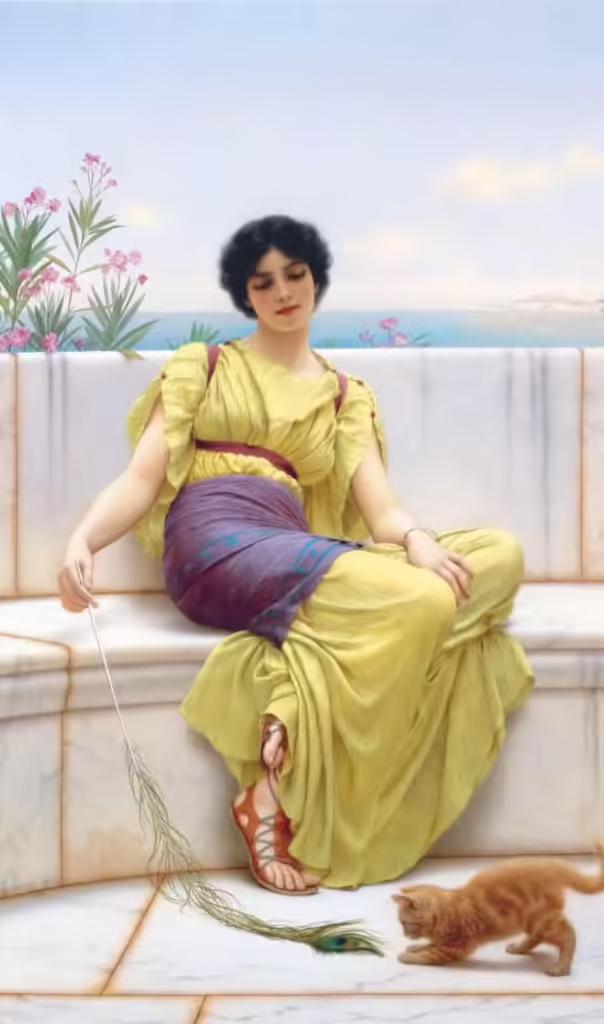
100- Idleness by John William Godward
Idleness, painted by John William Godward in 1894, is a representative work of the artist’s neoclassical style, known for its scenes inspired by antiquity and aesthetic refinement. The painting illustrates the grace and serenity of feminine figures in a classical setting, typical of Godward’s works.
The scene depicts a young woman reclining in a lush and soothing environment, likely a garden or terrace adorned in classical fashion. She is dressed in a light, draped gown and appears to be in a state of rest or contemplation. The atmosphere is calm and elegant, reflecting Godward’s sensitivity to the beauty and sophistication of ancient culture.
The painting is distinguished by its harmonious composition and meticulous attention to detail. Architectural elements, such as columns or arcades, are rendered with great precision, creating a subtle contrast with the softness of the drapery and textures of the central figure’s gown. The colors are rich and nuanced, with a palette of warm, golden tones that adds to the sense of luxury and serenity.
Idleness is an emblematic work of Godward’s style, blending classical influences with a contemporary sensitivity to create an atmosphere of timeless beauty. The painting is valued for its technical refinement and its ability to evoke a sense of peace and relaxation.
The artwork is housed in a private collection or a museum that values neoclassical art, where it is admired for its contribution to the aesthetic representation of beauty and tranquility in a classical setting.

101- Seated Nude on a Divan, d’Amedeo Modigliani
“Seated Nude on a Divan,” painted by Amedeo Modigliani in 1917, is an iconic work by the Italian artist known for his distinctive portraits and nudes. This painting is a striking example of Modigliani’s unique style, characterized by elongated forms, fluid lines, and a modern sensibility that transcends traditional conventions.
The painting depicts a nude woman seated on a divan or sofa in a relaxed and casual pose. The figure is stylized with elongated shapes and sinuous contours, which are typical of Modigliani’s style. The woman is portrayed with great simplicity and timeless elegance, her forms accentuated by clean lines and soft colors.
The background is generally simple, often in neutral tones or gradients that highlight the central figure. The woman’s facial and bodily features are rendered with stylized details rather than realistic representation, giving the work a dreamlike and almost surreal quality. The figure’s eyes are often depicted abstractly, with long and elongated features that contribute to the contemplative and meditative atmosphere of the portrait.
“Seated Nude on a Divan” is a perfect illustration of Modigliani’s modernist style, blending elements of cubism with a sensitivity to beauty and personal expression. The painting is appreciated for its ability to capture the grace and elegance of an intimate moment with visual simplicity and sophistication.
The work is housed in a private collection or a modern art museum, where it is admired for its stylistic originality and its impact on the development of modern portraiture and the representation of the nude.
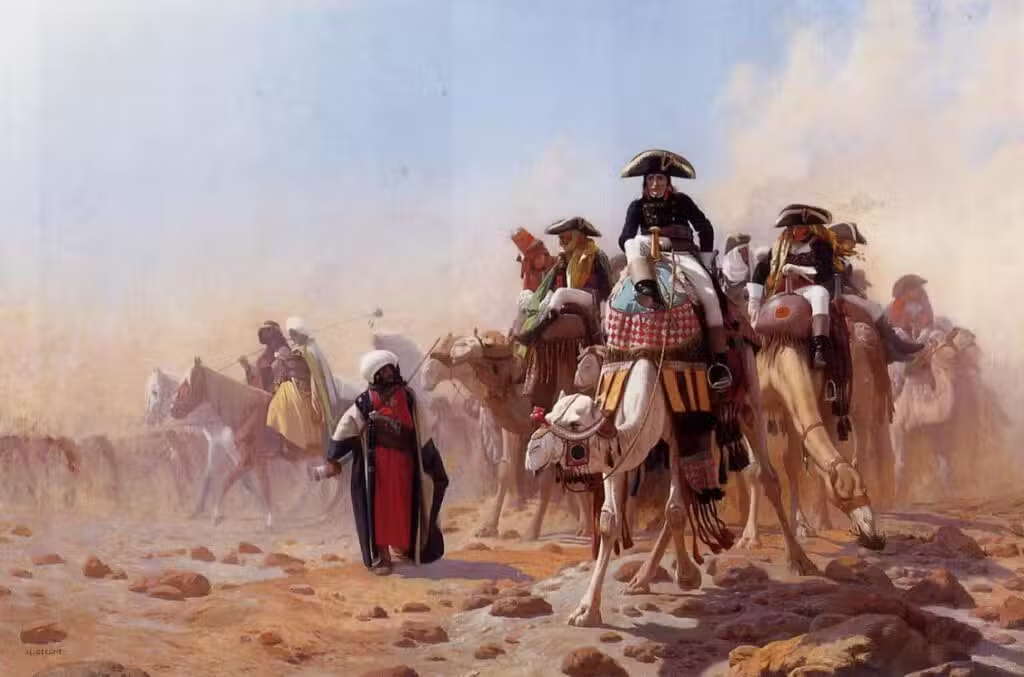
102- Napoleon in Egypt by Jean-Léon Gérôme
“Napoleon in Egypt,” painted by Jean-Léon Gérôme in 1867, is a significant work that captures a notable moment from Napoleon Bonaparte’s Egyptian campaign. This painting exemplifies Gérôme’s historical realism, known for its precise and dramatic depictions of historical events and Oriental scenes.
The painting portrays Napoleon Bonaparte in an Egyptian setting, depicted in a heroic and imposing stance. He is surrounded by soldiers and a desert landscape, with Egyptian architectural elements and monuments in the background. The scene highlights the contrast between the ancient Orient and Napoleon’s modern presence, underscoring the 19th-century fascination with ancient Egypt.
Gérôme employs a warm, earthy color palette to create an atmosphere of grandeur and heat. The details of costumes, weapons, and scenery are rendered with great precision, reflecting the artist’s commitment to historical accuracy and visual authenticity. The depiction of characters and objects showcases Gérôme’s characteristic attention to detail.
“Napoleon in Egypt” is also notable for its visual interpretation of Napoleon’s impact on Egyptian history and culture. The painting captures the blend of military power and exoticism associated with the Egyptian expedition while emphasizing Napoleon’s grandeur as a historical figure.
The artwork is housed at the Musée d’Orsay in Paris, where it is admired for its dramatic and faithful representation of a key moment in military history and the exploration of the Orient.
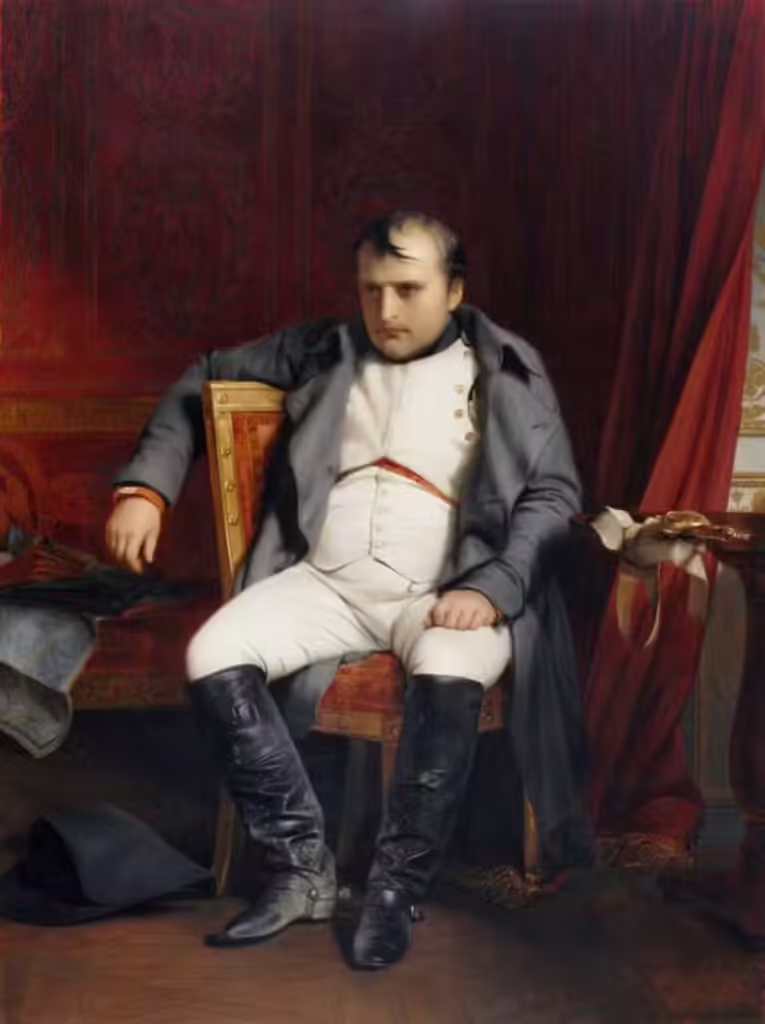
103- Napoleon Bonaparte Abdicates at Fontainebleau by Jacques-Louis David
“Napoleon Bonaparte Abdicates at Fontainebleau,” painted by Jacques-Louis David in 1814, is an iconic work capturing a pivotal moment in French history: Napoleon Bonaparte’s abdication at the Palace of Fontainebleau. This painting is a prime example of David’s neoclassical style, known for its grandiose depictions of historical events.
The scene depicts Napoleon signing his abdication, surrounded by his officers and advisors. Unlike previous portraits where he is often shown in a heroic and triumphant light, here Napoleon is portrayed in a state of defeat. Dressed in a military uniform, he appears overwhelmed, emphasizing the gravity of the moment.
David employs a formal and symmetrical composition to underscore the historical significance of the event. The painting highlights architectural details of the Palace of Fontainebleau, with dramatic lighting accentuating the expressions of sadness and resignation on the faces of the figures present. The colors are predominantly dark tones and earthy shades, reinforcing the atmosphere of crisis and loss.
“Napoleon Bonaparte Abdicates at Fontainebleau” is a powerful work that illustrates the end of an era for Napoleon and the transition from the empire to the Restoration. The painting not only serves as a testament to David’s artistry but also as a visual representation of the fall of one of the most influential figures in modern history.
The artwork is housed at the Musée de l’Armée in Paris, where it is studied for its historical and artistic significance. It remains a key example of how David used art to comment on and immortalize significant moments in contemporary history.

104- Mont Sainte-Victoire by Paul Cézanne
“Mont Sainte-Victoire,” painted by Paul Cézanne between 1882 and 1885, is an iconic work of the post-impressionist artist, renowned for its depiction of the Provençal landscape and its role in the development of Cubism. This painting is one of many representations of Mont Sainte-Victoire, a prominent peak in Provence that captivated Cézanne throughout his career.
The painting portrays Mont Sainte-Victoire as seen through a landscape of rolling hills and valleys in the foreground. Cézanne employs geometric brushstrokes and vibrant colors to create a composition that is both abstract and realistic. The mountain and the surrounding landscape are rendered with overlapping and juxtaposed color patches, creating a rich texture and a sense of depth.
Dominant colors include shades of blue, green, and ochre, capturing the light and atmosphere of the Provençal region. Cézanne experiments with perspective and geometric structure, using simple shapes to build a complex and dynamic view. This approach is characteristic of Cézanne’s style, which sought to explore the relationship between forms and visual perception.
“Mont Sainte-Victoire” is a key example of Cézanne’s work and his unique approach to landscape painting. The painting reflects his interest in geometric structure and compositional dynamics while capturing the natural beauty of the location. It is also seen as a precursor to the development of Cubism, influencing artists such as Pablo Picasso and Georges Braque.
The painting is housed at the Musée d’Orsay in Paris, where it is celebrated for its stylistic innovation and contribution to the evolution of modern painting. It remains an essential masterpiece of post-impressionism and a testament to Cézanne’s artistic genius.
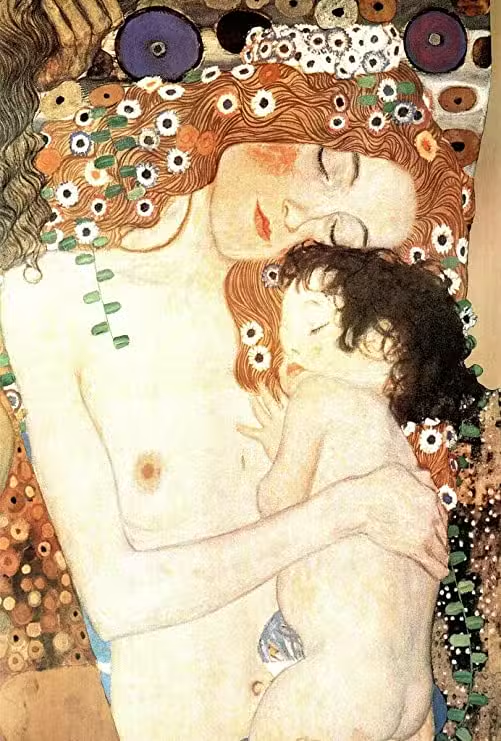
105- Mother and Child by Gustav Klimt
“Mother and Child,” painted by Gustav Klimt in 1905, is a poignant work that showcases the Austrian artist’s distinctive style and his interest in themes of motherhood and femininity. This painting is characteristic of Klimt’s “Golden Period,” where he incorporated ornamental and symbolic elements into his representations.
The painting depicts a mother holding her child in her arms, capturing a moment of affection and tenderness with artistic sensitivity. Klimt uses a palette of warm, rich colors, with golden and earthy tones that lend an almost mythical quality to the scene. The figures are enveloped in decorative patterns and elaborate textures, typical of Klimt’s style.
The mother and child are rendered with fluid contours and stylized forms, giving the work a dreamlike and idealized quality. The faces are delicately painted, with particular attention to the expressions and details of the eyes and gestures. The background of the painting is often filled with ornamental and abstract patterns, creating a visual contrast with the central figures.
“Mother and Child” explores the beauty and intimacy of the maternal relationship, expressed through Klimt’s unique aesthetic. The painting combines symbolic and decorative elements to create a work that is both emotionally and visually rich.
The piece is held in a private collection or art museum, where it is admired for its elegance and its ability to capture the depth of human emotions through Klimt’s distinctive style.

106- Barge Haulers on the Volga by Ilya Repin
“Barge Haulers on the Volga,” painted by Ilya Repin in 1873, is a powerful work that illustrates the harsh reality of the lives of Russian laborers in the 19th century. This painting is a notable example of Repin’s realism, known for its sincere and dramatic representations of the human condition.
The painting depicts a group of workers hauling barges along the Volga River, a major waterway in Russia. The figures are shown struggling against the river’s current, pulling the barges with ropes. The work captures the physical exhaustion and effort of the haulers, emphasizing the grueling nature of their labor.
Repin employs a palette of earthy and dark colors to underscore the weight of the work and the harsh conditions faced by the figures. The details of the workers’ faces and bodies are rendered with great precision, showing expressions of pain and fatigue that characterize their situation. The depiction of the landscape and the barges is also rendered realistically, adding to the authenticity of the scene.
“Barge Haulers on the Volga” is significant for its commitment to depicting the social and economic realities of 19th-century Russia. The painting is appreciated for its ability to convey the intensity and suffering of the laborers through a powerful composition and impressive technical execution.
The work is housed at the Tretyakov Gallery in Moscow, where it is admired for its striking realism and emotional impact. It remains an important testament to Repin’s art and his ability to capture the complexity of 19th-century Russian life.

107- Portrait of Madame X by John Singer Sargent
“Portrait of Madame X,” painted by John Singer Sargent in 1884, is one of the most famous and controversial works of the American artist, known for his refined and elegant portraits. The painting is renowned not only for its artistic quality but also for the scandal it provoked upon its exhibition.
The portrait depicts Madame Virginie Amélie Avegno Gautreau, a prominent Parisian socialite known for her beauty and sophistication. In the painting, she is shown standing in a sumptuous black gown with a daring décolleté, the fabric appearing almost sheer, and draped with remarkable sophistication. The bold use of black highlights the contrast with the pale skin of the model.
The painting is also notable for the meticulous attention to detail in the depiction of Madame X’s face and clothing. Sargent captures her delicate features and cool expression with precise and fluid brushwork. The dark, neutral background emphasizes the central figure and enhances the depth and texture of the gown.
The painting faced significant criticism during its exhibition at the Salon de Paris in 1884 due to the suggestive appearance of the gown’s décolleté, leading to a major scandal. Madame X became the target of harsh criticism, and the painting was withdrawn from the exhibition. As a result, Sargent lost many potential clients in France and eventually decided to return to London.
“Portrait of Madame X” is now regarded as a masterpiece of academic portraiture and is admired for its technical mastery and stylistic boldness. The painting is housed at the Metropolitan Museum of Art in New York, where it is showcased as a key example of Sargent’s talent and his impact on modern portraiture.
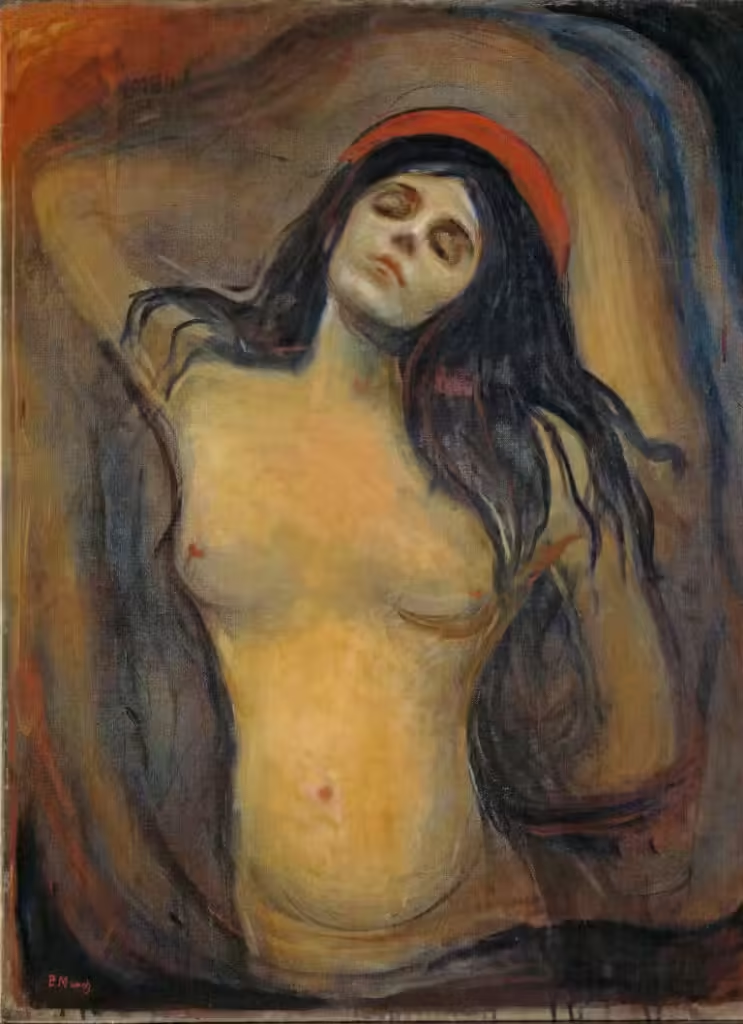
108- Madonna by Edvard Munch
“Madonna,” painted by Edvard Munch between 1894 and 1895, is an iconic work that exemplifies the Norwegian artist’s expressive and symbolic style. This painting is among Munch’s most famous works and is part of his series exploring themes of love, death, and spirituality.
The painting depicts a nude woman in a sensual and slightly curled pose, surrounded by a halo of light or an aura that suggests a mystical quality. Her face is rendered with intensity, displaying a complex mix of emotions that can be interpreted as passion, melancholy, or contemplation. The contours of her body are fluid and almost dreamlike, adding a surreal dimension to the piece.
Munch employs a vibrant color palette, with dominant reds and blacks, creating a dramatic contrast between the central figure and the background. The handling of colors and forms reflects the influence of Symbolism, an artistic movement with which Munch is often associated, as well as his own unique approach to Expressionism.
“Madonna” is also notable for its bold iconography, blending religious and erotic elements to create a tension between spiritual purity and earthly sensuality. This juxtaposition contributes to the painting’s emotional ambiguity and invites deeper reflection on themes of sexuality and the sacred.
The artwork is housed at the Munch Museum in Oslo, Norway, where it is admired for its visual and emotional daring. “Madonna” is a striking example of how Munch explored complex aspects of the human condition through his art, using powerful symbols and expressive compositions.

109- Marie-Antoinette with Rose by Élisabeth Louise Vigée Le Brun
“Marie-Antoinette with Rose,” painted by Élisabeth Louise Vigée Le Brun in 1783, is an iconic portrait of Queen Marie-Antoinette, created by one of the most renowned artists of the time. This work is a key example of Rococo style and portraiture at the French court.
In this painting, Marie-Antoinette is depicted in an elegant and natural pose, holding a rose in her hands. The work captures the queen in a moment of grace and sophistication, with particular attention paid to the delicacy and flow of her garments. She is dressed in a white satin gown adorned with ribbons and lace, and her hair is carefully styled, showcasing the fashion of the period.
The background features a soft and romantic landscape, with pastel hues that complement Marie-Antoinette’s refined appearance. The portrait is distinguished by its gentle light and harmonious composition, which enhance the beauty and dignity of the queen.
“Marie-Antoinette with Rose” is not only a testament to Vigée Le Brun’s technical skill but also illustrates her role as the official court painter. The portrait was commissioned to promote the image of the queen as a gracious and benevolent figure, contrasting with the negative perception of Marie-Antoinette by the public towards the end of her reign.
The artwork is housed at the Musée du Château de Versailles, where it is admired for its beauty and its role in the history of art and the French monarchy. “Marie-Antoinette à la Rose” remains a testament to Vigée Le Brun’s elegant style and her ability to capture the grandeur and complexity of her royal subjects.

110- Sunflowers by Vincent van Gogh
“Sunflowers” is a series of paintings created by Vincent van Gogh between 1888 and 1889, with the most famous version painted in 1888. These works are part of a series depicting sunflowers in vases and are among the most iconic of the Dutch artist’s oeuvre.
In this series, Van Gogh explores variations in color and light through vibrant representations of sunflowers in full bloom. The paintings feature the flowers in vases, often set against contrasting backgrounds that create a striking visual effect. Dominant colors include brilliant yellows, fresh greens, and touches of brown, capturing the warmth and vibrancy of summer.
Van Gogh employs bold and expressive brushstrokes to create dynamic textures and forms. The sunflower petals are painted with an impetuous technique, giving a sense of movement and vitality. The structure of the flowers is rendered with emotional intensity, reflecting the artist’s enthusiasm and passion for his subject.
Van Gogh’s “Sunflowers” are not only examples of his technical mastery but also of his ability to convey emotions and sensations through color and form. The works are often interpreted as an exploration of ephemeral beauty and the cycle of life.
The “Sunflowers” paintings are held in several major collections, including the Van Gogh Museum in Amsterdam, the National Gallery in London, and the Getty Museum in Los Angeles. Each version of this series has its own unique character and visual impact, but all share Van Gogh’s signature vibrant and expressive style.

111- The Musicians by Caravaggio
“The Musicians“, painted by Michelangelo Merisi da Caravaggio in 1595, is a prominent work by the Italian Baroque painter, renowned for his dramatic use of light and shadow as well as his realistic portrayal of human figures.
The painting depicts a group of young musicians, one of whom is playing the guitar while the others attentively listen. The work is characterized by its dynamic composition and masterful use of chiaroscuro—a technique where strong contrasts between light and dark create dramatic depth and highlight the details of the figures. The light illuminates the musicians’ faces and hands, drawing attention to their interaction and expressions.
The figures are rendered with intense realism, capturing the texture of their clothing and musical instruments with remarkable precision. The characters are painted in natural, relaxed poses, adding a touch of spontaneity to the scene. The choice of clothing and instruments reflects the authenticity and social context of the musicians, contributing to the painting’s intimate and everyday atmosphere.
“The Musicians” is often interpreted as a celebration of music and camaraderie, as well as an example of Caravaggio’s interest in genre scenes and realistic depictions of daily life. The painting also reflects Caravaggio’s innovation in using chiaroscuro to create a dramatic and emotional ambiance.
The work is housed in the Uffizi Gallery in Florence, where it is admired for its striking realism and its influence on the development of Baroque style in European art. “The Musicians” remains a key example of Caravaggio’s ability to transform ordinary scenes into extraordinary works of art through his unique and innovative style.

112- Las Meninas by Diego Velázquez
“Las Meninas“, painted by Diego Velázquez in 1656, is regarded as one of the most important masterpieces of Baroque art and a cornerstone of Western painting. This complex work is frequently studied for its innovative composition, use of perspective, and exploration of the role of the painter and the nature of reality.
The painting depicts a scene at the court of King Philip IV of Spain, set in the royal apartments of the Palacio del Buen Retiro. At the center of the composition is the young Infanta Margaret Theresa, surrounded by her ladies-in-waiting, or “meninas,” as well as other court members, including a dwarf and a dog. Velázquez himself is portrayed at work, painting the royal family, who are partially reflected in a mirror in the background.
“Las Meninas” is also notable for how it questions the nature of art and the creative process. The work is often interpreted as a reflection on the role of the painter as both creator and observer, as well as on the relationship between art, the viewer, and the subject.
The painting is housed in the Museo del Prado in Madrid, where it is celebrated as a masterpiece of Baroque painting and a profound exploration of the power of art. “Las Meninas” remains a captivating work that continues to inspire admiration and scholarly debate among art enthusiasts and researchers worldwide.

113- The Potato Eaters by Vincent van Gogh
“The Potato Eaters“, painted by Vincent van Gogh in 1885, is an iconic work from the artist’s Dutch period. This painting is a powerful example of Van Gogh’s expressive style and his interest in the living conditions of peasants.
The artwork depicts a peasant family seated around a modest table, eating potatoes. The figures are shown in simple, austere postures, with faces marked by fatigue and hard labor. The atmosphere of the scene is dark and earthy, reflecting the harsh living conditions of the peasants of the time.
“The Potato Eaters” is often interpreted as a realistic and empathetic representation of the peasant’s way of life, highlighting their hard work and dignity despite their hardships. The work marks a significant step in Van Gogh’s artistic development, showcasing his commitment to a more expressive and socially engaged approach in his art.
The painting is housed at the Rijksmuseum in Amsterdam, where it is admired for its emotional impact and its powerful depiction of peasant life at the end of the 19th century. “The Potato Eaters” remains a notable example of Van Gogh’s talent for capturing human depth through poignant compositions and bold stylistic choices.

114- The Large Bathers by Pierre-Auguste Renoir
“The Large Bathers“, painted by Pierre-Auguste Renoir between 1884 and 1887, is one of the major works of Impressionism and an iconic example of Renoir’s style. This painting depicts an idyllic scene of nude women bathing and relaxing in a natural setting, characteristic of the artist’s sensual and luminous style.
The artwork features several female figures in a dynamic and fluid composition, bathed in sunlight. The bathers are portrayed with voluptuous forms and relaxed poses, illustrating the pleasure and freedom of outdoor bathing. Renoir employs soft brushstrokes and a palette of warm, bright colors to capture the warmth and softness of the scene.
“The Large Bathers” is often interpreted as a celebration of feminine beauty and joie de vivre. The painting reflects Renoir’s interest in depicting human figures in natural contexts and his emphasis on light and color to create a vibrant and pleasing atmosphere.
The painting is housed at the Musée d’Orsay in Paris, where it is admired for its technical mastery and its expression of sensuality and beauty. “The Large Bathers” remains a key piece in Renoir’s repertoire and a significant example of Impressionism as an artistic movement.

115- Irises by Vincent van Gogh
“Irises“, painted by Vincent van Gogh in 1889, is one of the artist’s most famous works, created during his stay at the Saint-Paul-de-Mausole asylum in Saint-Rémy-de-Provence. This painting exemplifies Van Gogh’s vibrant and expressive style and his deep passion for nature.
The painting depicts a garden of irises in full bloom, with flowers rendered in vivid and varied colors. Van Gogh employs dynamic brushstrokes and a rich palette of deep blues, purples, greens, and touches of yellow. The irises are painted with great intensity, capturing their delicate beauty while highlighting the texture and movement of the petals.
“Irises” is often considered an example of Van Gogh’s mastery in capturing natural beauty and emotional force through color and texture. The work reflects his interest in plants and his desire to depict nature in a lively and expressive manner.
The painting is housed at the J. Paul Getty Museum in Los Angeles, where it is admired for its beauty and its significance in Van Gogh’s artistic development. “Irises” remains a testament to Van Gogh’s ability to transform natural subjects into deeply evocative works of art.

116- Fritza Riedler by Gustav Klimt
“Fritza Riedler“, painted by Gustav Klimt in 1906, is a remarkable portrait that exemplifies the distinctive style of the Austrian artist. This work is an important example of how Klimt merges classical portraiture with decorative and symbolic elements.
The painting portrays Fritza Riedler, an elegant and refined woman, dressed in a dark outfit adorned with gold details and decorative patterns. The background of the portrait features geometric and floral motifs typical of Klimt’s style, adding a decorative dimension to the composition.
“Fritza Riedler” is often appreciated for its representation of sophistication and elegance, as well as for its unique blend of portrait and ornamentation. The work reflects Klimt’s interest in visual beauty and his innovative approach to portraiture.
The painting is held in a private collection but is widely recognized for its contribution to Klimt’s oeuvre and the evolution of modern portraiture. “Fritza Riedler” remains a key example of Klimt’s ability to combine decorative art with portraiture in a work of great visual and emotional richness.

117- Blue Dancers by Edgar Degas
“Blue Dancers,” painted by Edgar Degas in 1890, is an iconic work that highlights the artist’s fascination with ballet and dancers. Degas is renowned for his depictions of the dance world, capturing both the grace and effort of dancers in moments of rehearsal and performance.
The painting depicts a group of dancers in blue ballet costumes, poised in a way that evokes both the rigor and fluidity of classical dance. The figures are shown in dynamic movements and elegant poses, emphasizing the discipline and beauty of ballet.
“Blue Dancers” is often praised for its ability to capture the energy and elegance of the ballet world. The work reflects Degas’s commitment to a realistic and expressive portrayal of dance, while showcasing his technical mastery and sense of movement.
The painting is housed at the Musée d’Orsay in Paris, where it is celebrated for its contribution to Degas’s body of work and its role in the evolution of Impressionist painting. “Blue Dancers” remains a notable example of how Degas explores and immortalizes the ballet world through his art.
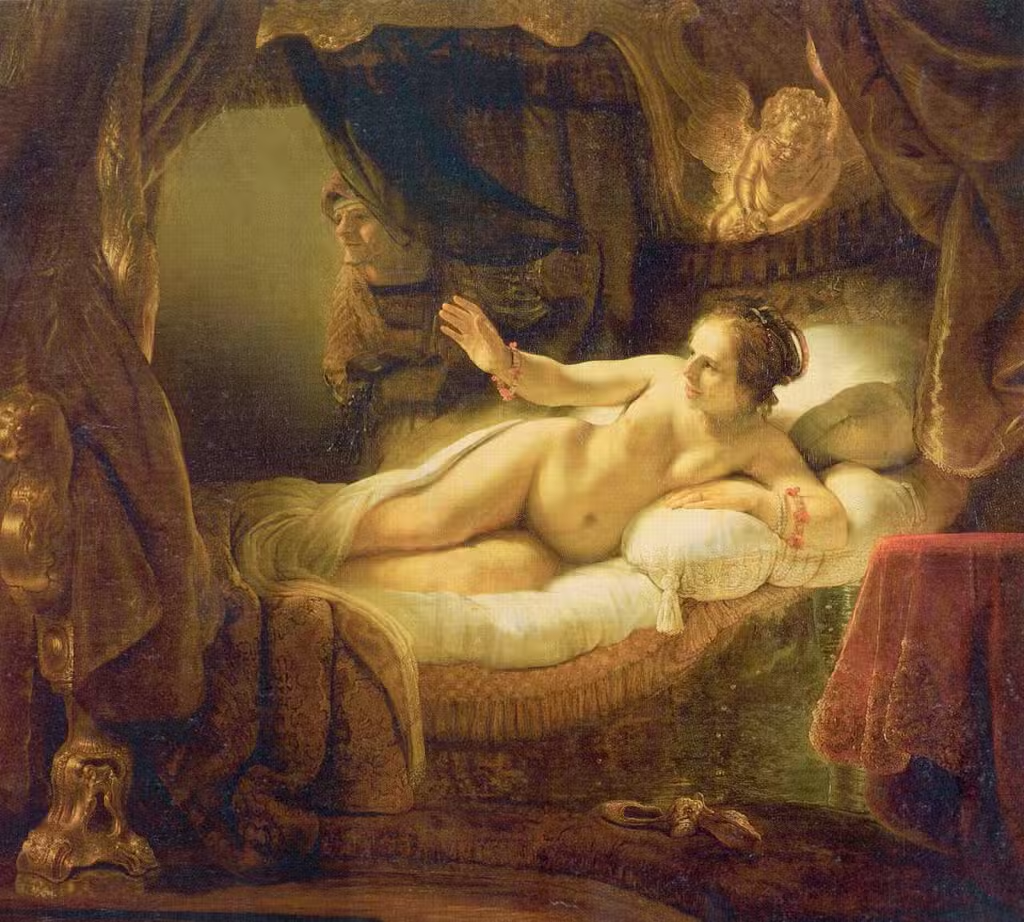
118- Danaë by Rembrandt van Rijn
“Danaë,” painted by Rembrandt van Rijn in 1636, is a masterful work that showcases the Dutch master’s skill in depicting light and emotion. This painting illustrates a scene from Greek mythology, featuring Danaë, the daughter of King Acrisius, who receives a divine visit from Zeus in the form of a shower of gold.
The painting is renowned for its bold use of light and its intimate composition. Danaë is depicted nude, reclining on a bed or cushion, as the golden rays fall upon her, symbolizing the divine encounter. The scene is both sensual and dramatic, capturing the moment Danaë is enveloped by the golden light.
“Danaë” is often admired for its technical mastery and its ability to convey moments of intense emotional impact. The work is a significant example of how Rembrandt uses light and color to create rich, evocative atmospheres.
The painting is housed in the Hermitage Museum in Saint Petersburg, where it is celebrated for its visual impact and its importance in Rembrandt’s oeuvre. “Danaë” remains a major example of Rembrandt’s genius in painting light and the human form.

119- Composition with Red, Blue, and Yellow by Piet Mondrian
“Composition with Red, Blue, and Yellow,” created by Piet Mondrian in 1921, is an iconic example of the neoplasticism style that Mondrian developed throughout his career. This painting is a key representation of Mondrian’s commitment to a pure form of abstract art, characterized by a rigorous use of color and geometric shapes.
The artwork consists of blocks of primary colors—red, blue, and yellow—arranged within a grid of black and white lines. This rigid and balanced composition reflects Mondrian’s aspiration to create universal visual harmony through abstraction.
“Composition with Red, Blue, and Yellow” is often interpreted as an exploration of visual harmony and balance through simplicity and abstraction. The piece illustrates Mondrian’s dedication to the principles of neoplasticism, which aim to establish a universal and objective form of art.
The painting is housed at the Museum of Modern Art in New York, where it is recognized for its contribution to the development of abstract art and its enduring impact on the history of modern art. “Composition with Red, Blue, and Yellow” remains a central example of Mondrian’s distinctive style and artistic vision.

120- Carnation, Lily, Lily, Rose by John Singer Sargent
“Carnation, Lily, Lily, Rose,” painted by John Singer Sargent between 1885 and 1886, is a remarkably captivating work that captures a moment of late English summer with great elegance. The painting is renowned for its vivid and luminous portrayal of two young girls among flowers, surrounded by Chinese lanterns in a garden.
The artwork depicts the young girls, daughters of Sargent’s friends, posing in a flower garden. They are holding lanterns, presumably lit at twilight, creating a contrast of light and shadow that brings the scene to life.
“Carnation, Lily, Lily, Rose” is often admired for its charming atmosphere and its superb handling of light and color. The painting is considered an example of Sargent’s ability to capture fleeting moments of beauty and serenity in his work.
The painting is housed at the Tate Gallery in London, where it is celebrated for its visual beauty and its significance in Sargent’s oeuvre. “Carnation, Lily, Lily, Rose” remains a lasting testament to Sargent’s talent for depicting light and color in art.
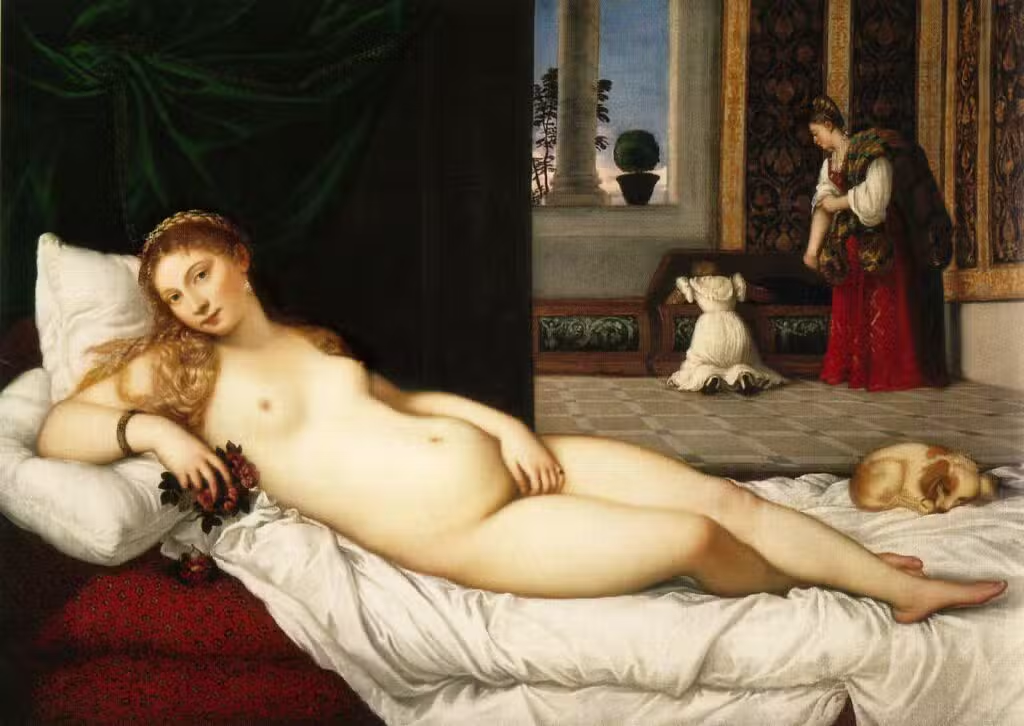
121- Venus of Urbino by Titian
“Venus of Urbino,” painted by Titian in 1538, is one of the most famous works of Venetian Renaissance art and a quintessential example of nude painting. This piece is often regarded as a masterpiece of Renaissance art for its bold depiction of sensuality and feminine beauty.
The painting portrays a nude woman reclining on a richly adorned couch in an opulent interior. The figure is identified as Venus, the goddess of love, and is placed in a domestic rather than a mythological setting, adding a layer of realism to the scene.
“Venus of Urbino” is admired for its elegant and innovative representation of the female nude. The work has influenced many subsequent artists and remains a central piece in the history of Western art.
The painting is housed at the Uffizi Gallery in Florence, where it is celebrated for its technical mastery and impact on the tradition of nude painting. “Venus of Urbino” continues to be an icon of Renaissance art and a testament to Titian’s genius in capturing beauty and desire through painting.

122- The Card Players by Paul Cézanne
“The Card Players,” painted by Paul Cézanne between 1890 and 1895, is a series of works that explores the theme of card games through a unique and innovative approach. These paintings are among Cézanne’s last creations and showcase his ability to reinvent traditional forms and compositions.
The painting depicts two men seated at a table playing cards, captured in a moment of intense concentration. Cézanne deconstructs the scene into simplified geometric shapes and employs an earthy color palette to create a balanced composition.
“The Card Players” is often appreciated for its influence on the development of modern art, particularly for its role in the transition toward Cubism. Cézanne explored new ways of representing reality through geometric abstraction, inspiring many future artists.
The various versions of this painting are housed in prestigious museums such as the Musée d’Orsay in Paris and the Metropolitan Museum of Art in New York. “The Card Players” remains a key work in Cézanne’s stylistic evolution and an important example of his contribution to art history.

123- The Gleaners by Jean-François Millet
“The Gleaners,” painted by Jean-François Millet in 1857, is one of the most emblematic works of French Realism. This painting depicts three women gleaning leftover ears of wheat after the harvest, a scene from rural life that illustrates the living conditions of peasants in the 19th century.
The painting is known for its poignant representation of the hard labor and challenging conditions faced by agricultural workers. Millet portrays the gleaners with dignity and respect, highlighting their essential role in the community while emphasizing the difficulties they encounter.
“The Gleaners” is often praised for its impact on art and society of the time. The painting is housed at the Musée d’Orsay in Paris, where it is admired for its powerful and humane depiction of agricultural labor. “The Gleaners” remains a significant work of Realism, demonstrating Millet’s commitment to authentic representation of the working classes and social realities of his era.

124- The Large Bathers by Paul Cézanne
“The Large Bathers,” painted by Paul Cézanne between 1894 and 1905, is a major work from the end of his career and a quintessential example of his innovative style. This painting depicts a group of nude women bathing in a natural landscape, capturing a moment of tranquility and harmony.
Cézanne represents the female figures with geometric simplification, integrating the human forms into the landscape in a fluid and natural manner. The bathers’ bodies are depicted with clear contours and full volumes, blending organically with the environment.
The composition is characterized by Cézanne’s bold use of color and a rigorous structuring of forms. He employs broad brushstrokes and blocks of color to create a sense of depth and movement while maintaining a degree of abstraction.
“The Large Bathers” is often interpreted as a testament to Cézanne’s evolution toward a more radical approach to spatial representation and form. The painting is housed at the Musée d’Orsay in Paris, where it is admired for its technical mastery and its influence on modern art.
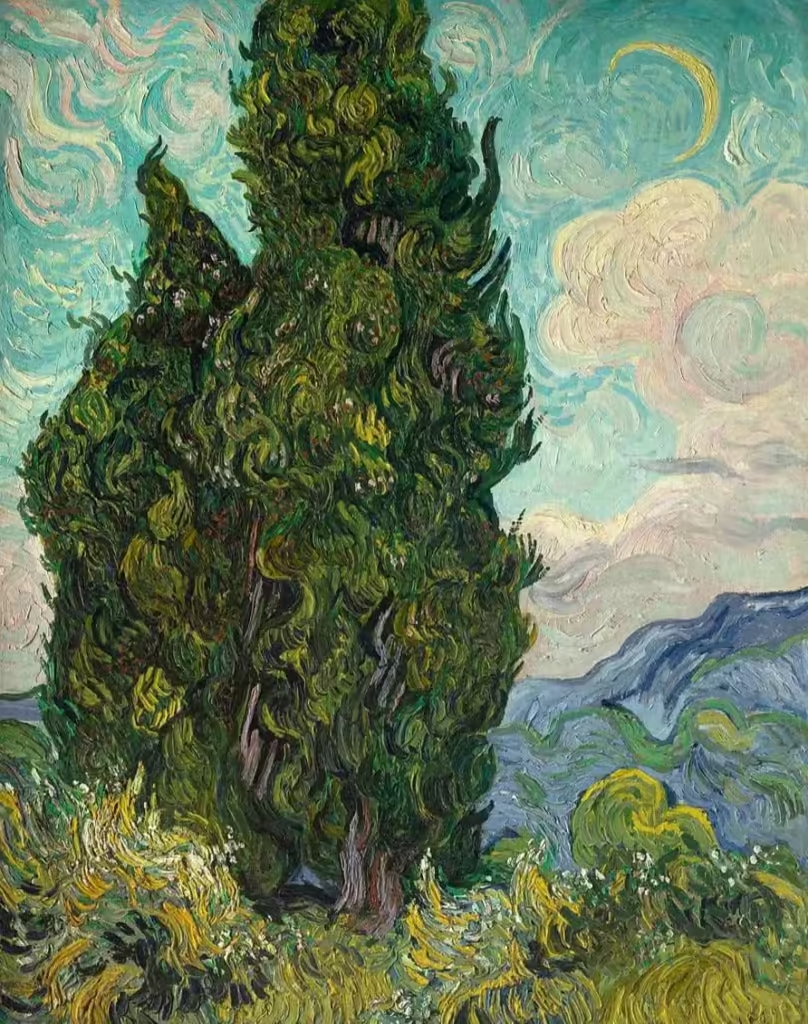
125- The Cypresses by Vincent van Gogh
“The Cypresses,” painted by Vincent van Gogh in 1889, is a vibrant and expressive work that forms part of the series created during his stay at the asylum of Saint-Rémy-de-Provence. This painting highlights the distinctive features of cypress trees, which Van Gogh frequently depicted in his Provençal landscapes.
The artwork presents a scene where the tall, sinuous cypress trees dominate the landscape. Van Gogh employs bold brushstrokes and intense colors to create a dramatic and dynamic effect. The swirling sky and the moving trees appear almost to blend into a harmonious whole, reflecting the artist’s emotional state.
The composition is marked by the use of wavy forms and contrasting colors, imparting a sense of movement and vitality to the scene. The cypresses, often associated with death and solitude in Mediterranean culture, are depicted here in a majestic and almost hypnotic manner.
“The Cypresses” exemplifies how Van Gogh integrated natural elements into his work to express his emotions and state of mind. The painting is housed at the Musée d’Orsay in Paris, where it is celebrated for its visual power and unique expression of the landscape.

126- Danaë by Gustav Klimt
“Danaë,” painted by Gustav Klimt between 1907 and 1908, is an iconic work of Art Nouveau and a major example of Klimt’s distinctive style. This painting depicts the mythical Danaë, the Greek princess who was visited by Zeus in the form of a golden shower.
In this artwork, Klimt captures the sensuality and richness of the myth through a lush and decorative composition. Danaë is portrayed reclining, enveloped in a rich golden drapery, with fluid forms and ornate details. Zeus’s golden shower is depicted as thousands of tiny golden flecks, creating a dazzling visual effect.
“Danaë” is often celebrated for its beauty and visual boldness, as well as its role in redefining artistic conventions of the time. The painting is housed at the National Gallery in Prague, where it is admired for its unique exploration of mythology and sensuality through Art Nouveau.
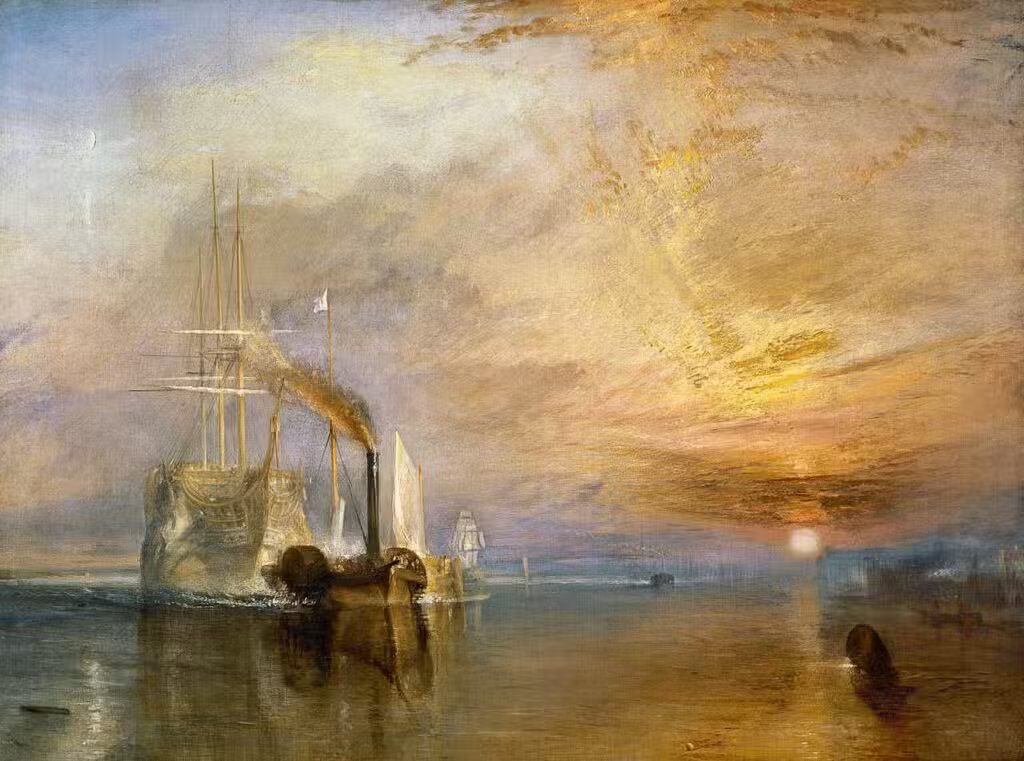
127- The Fighting Temeraire by J.M.W. Turner
“The Fighting Temeraire,” painted by J.M.W. Turner in 1839, is an iconic work by the British artist and a remarkable example of his mastery of light and color. The painting depicts the famous HMS Temeraire being towed to the scrapyard, symbolizing the end of an era and the transition to modernity.
The painting is distinguished by its dramatic use of light and color, with fluid brushstrokes and a vibrant palette that capture both the grandeur of the ship and the beauty of the sunset. Turner employs striking contrasts between the warm hues of the sky and the darker tones of the ship and water, creating a scene that is both poignant and majestic.
“The Fighting Temeraire” is widely recognized for its influence on the development of Romantic and modern landscape painting. The artwork is housed at the National Gallery in London, where it is celebrated for its emotional expression and innovative technique.

128- The Monk by the Sea by Caspar David Friedrich
“The Monk by the Sea,” painted by Caspar David Friedrich between 1808 and 1810, is an iconic work of German Romanticism. The painting depicts a solitary monk contemplating a dramatic coastal landscape, highlighting themes of sublime nature and spiritual reflection.
In the painting, the monk is seen from behind, standing on a rocky promontory, facing a tumultuous sea and a stormy sky. This composition emphasizes the contrast between the human figure and the vastness of the surrounding nature, underscoring a sense of isolation and inner contemplation.
The scene is dominated by dark tones and shades of gray, which enhance the melancholic and sublime atmosphere of the painting. The tempestuous sky and the raging sea are rendered with great expressiveness, creating a powerful contrast with the monk’s calm silhouette.
“The Monk by the Sea” is often interpreted as a meditation on the insignificance of humanity in the face of nature’s grandeur and unpredictability. The work is housed at the Galerie Neue Meister in Dresden, where it is celebrated for its ability to evoke profound emotions through a landscape that is both majestic and intimate.
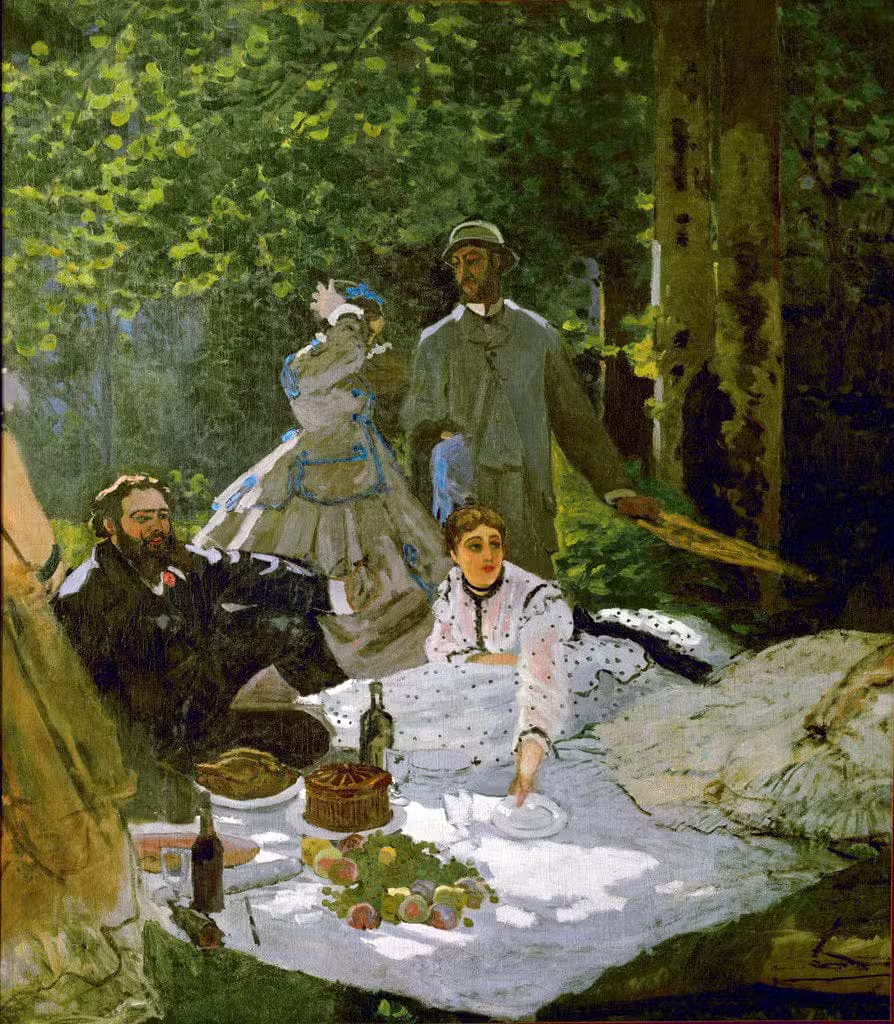
129- Luncheon on the Grass (Right Section) by Claude Monet
“Luncheon on the Grass (Right Section),“ painted by Claude Monet in 1866, is a work that is part of a larger composition often associated with Édouard Manet’s famous painting of the same name. This fragment, often regarded as a preparatory study, captures a moment of relaxation in the open air, characteristic of Monet’s Impressionist style.
In this part of the painting, Monet depicts a sunny scene with female and male figures lounging on the grass. The composition is distinguished by the use of vibrant colors and fluid brushstrokes that capture the light and atmosphere of the moment. The figures are rendered with a certain fluidity, lacking the meticulous details found in academic paintings of the time.
The right section of the painting highlights lush natural elements and a tranquil ambiance, emphasizing the simplicity and beauty of outdoor life. Monet employs Impressionist techniques to represent light and color in a vibrant manner, offering a modern and refreshing take on the traditional landscape genre.
“Luncheon on the Grass (Right Section)” is valued for its pioneering representation of the Impressionist style and its innovative approach to plein air painting. The work is held in private and museum collections, where it is celebrated for its influence on the evolution of modern art.

130- Luncheon of the Boating Party by Pierre-Auguste Renoir
“Luncheon of the Boating Party,“ painted by Pierre-Auguste Renoir in 1881, is an iconic Impressionist work that captures a moment of conviviality and relaxation in an outdoor setting. This painting depicts a group of friends gathered for a meal by the Seine in Chatou, a suburb near Paris.
In this vibrant and lively scene, Renoir encapsulates the essence of bourgeois life at the time, showcasing relaxed figures, animated conversations, and expressions of joy. The painting is distinguished by its use of natural light and fresh colors, as well as its detailed depiction of the environment, including the terrace, trees, and furniture.
Renoir demonstrates great skill in representing textures and materials, from the women’s dresses to the men’s suits, as well as the surface of the water and the play of light reflections. Renoir’s Impressionist style is evident in the swift brushstrokes and dabs of color that create a warm and lively atmosphere.
“Luncheon of the Boating Party” is housed at the Phillips Collection in Washington, D.C., where it is celebrated for its joyful and vibrant depiction of social life and its influence on the development of the Impressionist movement.

131- The Scream by Edvard Munch
“The Scream,“ painted by Edvard Munch in 1893, is one of the most iconic works of Expressionist art. The painting captures a moment of profound anguish and despair through a central figure that appears to be screaming amid a swirl of vivid, distorted colors.
In the painting, an androgynous silhouette, hands on ears, stands before a turbulent landscape where the sky and water blend into a maelstrom of red, orange, and blue. The central figure expresses intense emotion, capturing the essence of existential crisis and inner turmoil.
The work is distinguished by its bold style, with sinuous contours and bright colors that enhance the dramatic effect. Munch employs expressive painting techniques to convey a sense of emotional and psychological crisis.
“The Scream” is often interpreted as a reflection on modern anxiety and alienation. It is housed at the Munch Museum in Oslo, where it is celebrated for its emotional power and lasting impact on modern art.

132- The Course of Empire: Destruction by Thomas Cole
“The Course of Empire: Destruction,” painted by Thomas Cole in 1836, is the third work in the series The Course of Empire, an ambitious project that delves into the rise and fall of civilizations. This painting vividly depicts the decline and destruction of a grand civilization, offering a dramatic and symbolic portrayal of loss and decay.
The scene is set in a magnificent landscape where a majestic city, inspired by ancient architecture, is being ravaged. The grand structures lie in ruins, with flames and smoke engulfing the scene, and natural elements seemingly contributing to the devastation. The composition features a powerful contrast between the natural elements and the remnants of human civilization, emphasizing the fragility of human achievements in the face of nature’s forces.
Cole employs a palette of dark, dramatic colors to enhance the sense of ruin and chaos. The painting is characterized by an apocalyptic atmosphere and epic composition, underscoring the vanity of human ambitions and the fleeting nature of power.
The Course of Empire: Destruction is housed at the Cleveland Museum of Art, where it is celebrated for its poignant visual treatment of themes related to civilization and nature. This work stands as a key example of Thomas Cole’s significant role in the development of Romantic landscape painting and 19th-century American art.

133- The Coronation of Napoleon by Jacques-Louis David
“The Coronation of Napoleon,“ painted by Jacques-Louis David between 1805 and 1807, is a monumental work capturing a pivotal historical moment: Napoleon Bonaparte’s coronation as Emperor of the French. This painting is a prime example of Neoclassical style and illustrates David’s role as Napoleon’s official painter.
The painting depicts the coronation ceremony held at Notre-Dame Cathedral in Paris on December 2, 1804. Napoleon is shown crowning himself, a symbolic act emphasizing his power and authority. His wife, Marie-Louise of Austria, is also portrayed receiving the imperial crown from Napoleon, underscoring the dynastic nature of the event.
The Coronation of Napoleon is housed at the Louvre Museum in Paris, where it is admired for its grandeur and historical significance. The work remains a key piece for understanding the Napoleonic era and David’s impact as a painter of the Empire.
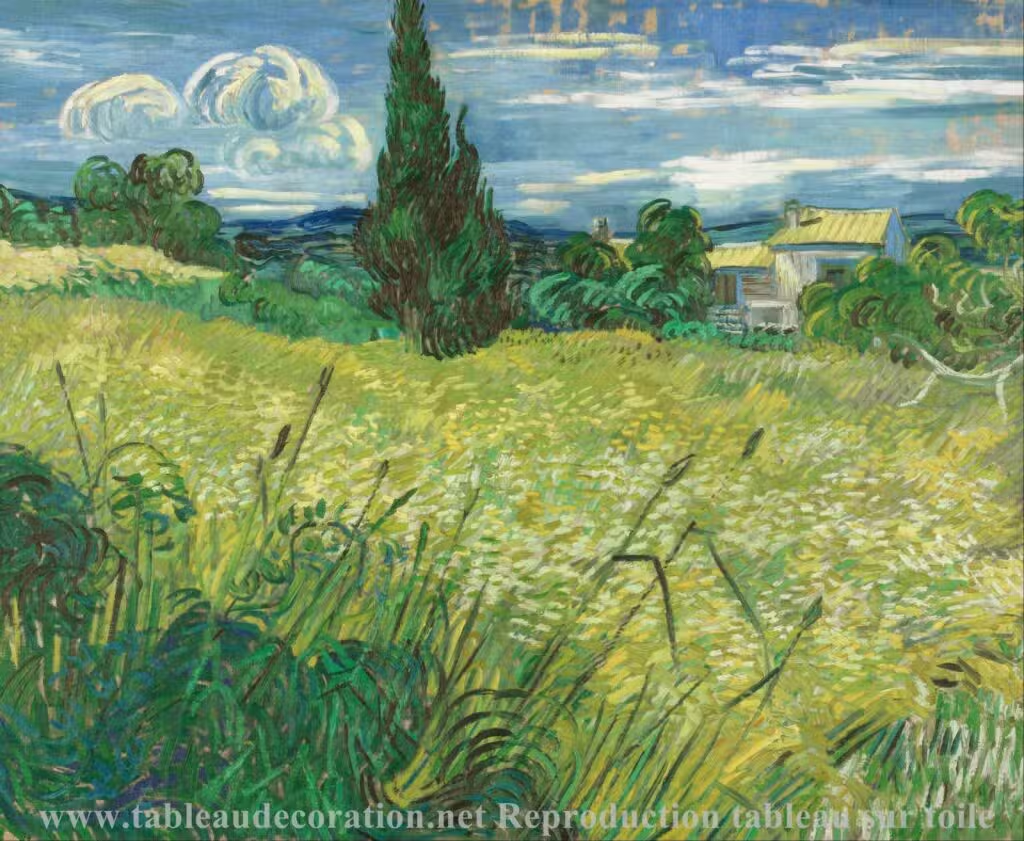
134- Green Wheat Field with Cypress by Vincent van Gogh
“Green Wheat Field with Cypress,” painted by Vincent van Gogh in 1889, is an iconic work that reflects the Dutch painter’s fascination with the natural landscapes of Provence. In this painting, Van Gogh depicts a lush wheat field, with the stalks swaying gently in the breeze, and towering cypress trees set against a vibrant and tumultuous sky.
The painting is notable for its rich, saturated color palette, featuring bright greens for the wheat and deep, swirling blues for the sky. Van Gogh’s dynamic and expressive brushstrokes create a lively texture and a sense of movement, while the cypress trees, with their elongated and slender forms, add a vertical and dramatic dimension to the composition.
Green Wheat Field with Cypress is often interpreted as an exploration of the relationship between humanity and nature, as well as an expression of the sense of vastness and freedom Van Gogh felt in the landscape. This work is part of Van Gogh’s series of Provençal landscapes and is housed at the Musée d’Orsay in Paris, where it is celebrated for its beauty and emotional impact.
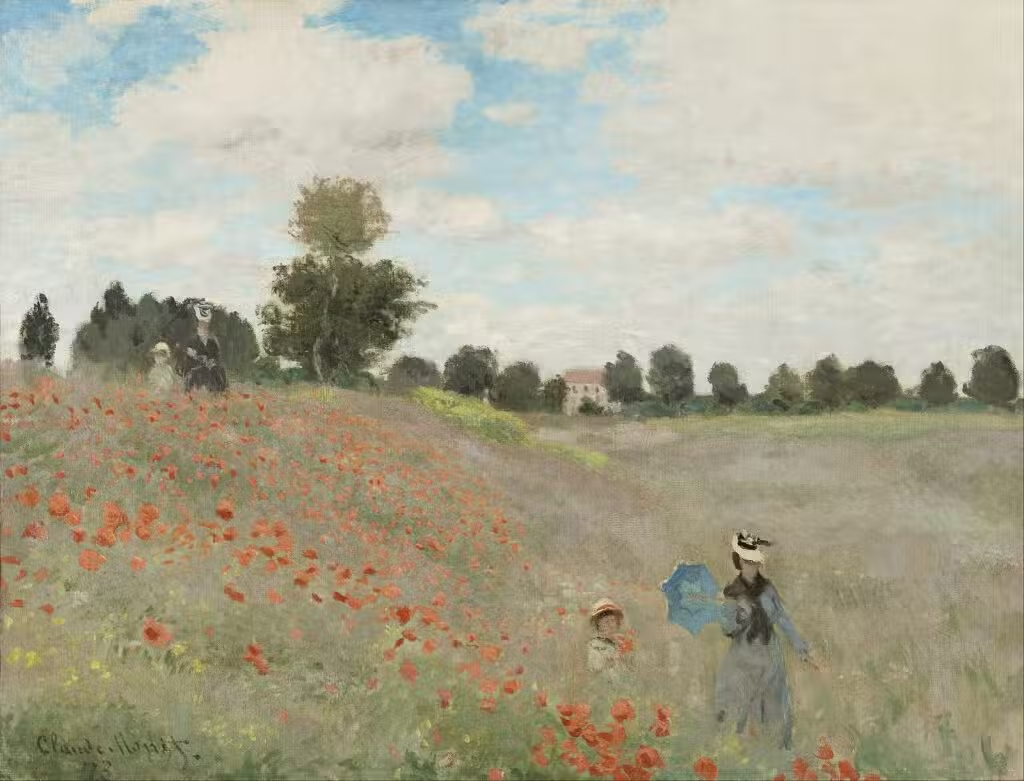
135- Poppies by Claude Monet
“Poppies,” painted by Claude Monet in 1873, is an iconic work of Impressionism that showcases the artist’s distinctive style and innovative approach to landscape painting. The painting depicts a field scattered with blooming poppies, with human figures relaxing in a vibrant natural setting.
Monet employs a vivid color palette, with striking red poppies contrasting against the lush green grass and the soft blue sky. The composition features swift, fluid brushstrokes that create a bright and airy atmosphere. The human figures are rendered in a blurred manner, seamlessly integrated into the landscape and enhancing the sense of movement and lightness.
Poppies is often seen as a celebration of nature’s ephemeral beauty and the joys of outdoor life. The painting is housed at the Musée d’Orsay in Paris, where it is admired for its ability to capture the essence of a moment and its influence on the development of the Impressionist movement.
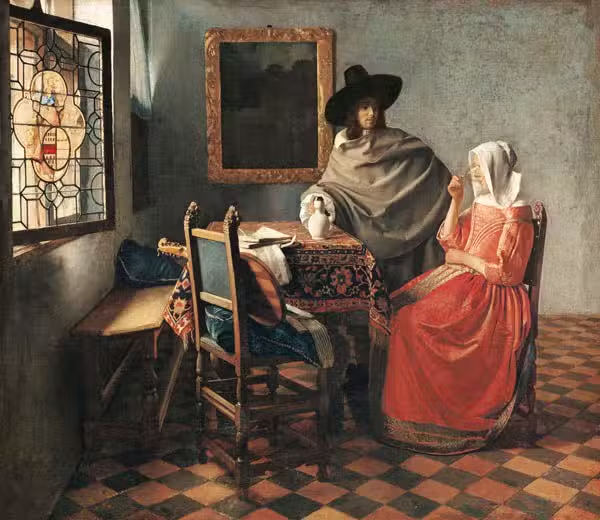
136- The Glass of Wine by Johannes Vermeer
“The Glass of Wine,” painted by Johannes Vermeer between 1660 and 1661, is a refined work that demonstrates Vermeer’s mastery in depicting light and intricate details. The painting features a young woman holding a glass of wine within a serene and elegant interior.
The scene is set in a sophisticated room with soft, natural lighting that highlights the texture of the woman’s clothing and the transparency of the wine glass. The woman is portrayed in a calm and composed manner, with a particular focus on the glass’s gleam and clarity. The details of the setting, such as the tablecloth and surrounding objects, are rendered with remarkable precision, enhancing the visual richness of the piece.
The Glass of Wine is often admired for its subtle exploration of light and color, as well as Vermeer’s delicate portrayal of everyday life. The painting is housed at the Gemäldegalerie Alte Meister in Dresden, where it is celebrated for its technical excellence and tranquil atmosphere.

137- The Third of May 1808 by Francisco de Goya
“The Third of May 1808,” painted by Francisco de Goya in 1814, is a powerful and poignant work that depicts the tragic events of the Spanish War of Independence against Napoleonic occupation. This painting is an emotional response to the atrocities committed by French troops in Madrid on May 3, 1808.
The scene unfolds in a dark night, where a group of Spanish resistance fighters, captured by French soldiers, are on the brink of execution. The painting is characterized by a stark contrast between light and darkness, with the light from a lantern illuminating the figures of the condemned. The terror and resignation on the faces of the prisoners, along with the brutality of the soldiers, are captured with dramatic intensity.
The painting is divided into two distinct sections: on the left, French soldiers prepare to fire, while on the right, the condemned await their fate with tragic resignation. Goya uses dark colors and expressive brushstrokes to convey the urgency and violence of the scene, heightening the sense of despair and injustice.
The Third of May 1808 is often regarded as a powerful commentary on war and human suffering. It is housed at the Museo del Prado in Madrid, where it is celebrated for its emotional force and social critique.
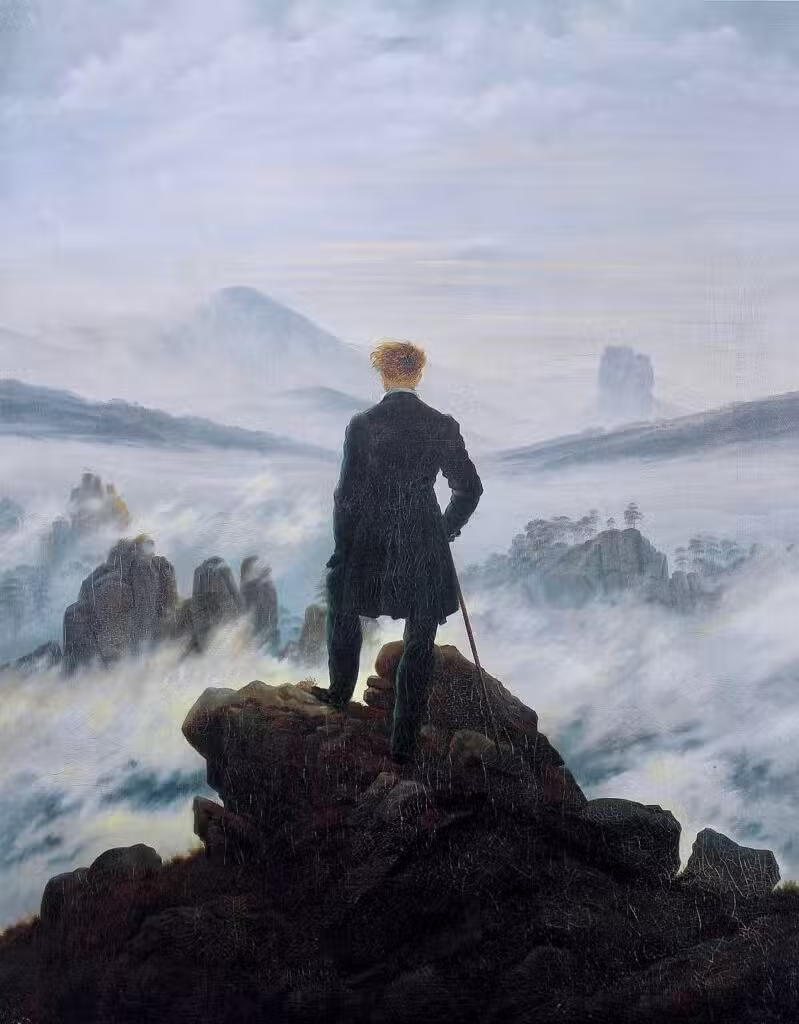
138- Wanderer Above the Sea of Fog by Caspar David Friedrich
“Wanderer Above the Sea of Fog,” painted by Caspar David Friedrich in 1818, is one of the most iconic works of German Romanticism. The painting depicts a solitary traveler standing atop a cliff, gazing out over a vast landscape shrouded in clouds and mist.
The composition highlights the traveler’s figure, silhouetted against the grand landscape, symbolizing the contemplation of nature and the sublime. The clouds and mist enveloping the scenery create a mysterious and immersive atmosphere, accentuating the contrast between the solid ground and the boundless sky.
Friedrich employs a cool color palette and meticulous details to convey the majesty and vastness of the landscape. The expansive view of the clouds and distant mountains invites reflection on the smallness of humanity in the face of nature’s grandeur.
Wanderer Above the Sea of Fog is housed at the Neue Nationalgalerie in Berlin. The work is celebrated for its exploration of the sublime and its ability to evoke a profound connection between humanity and nature.
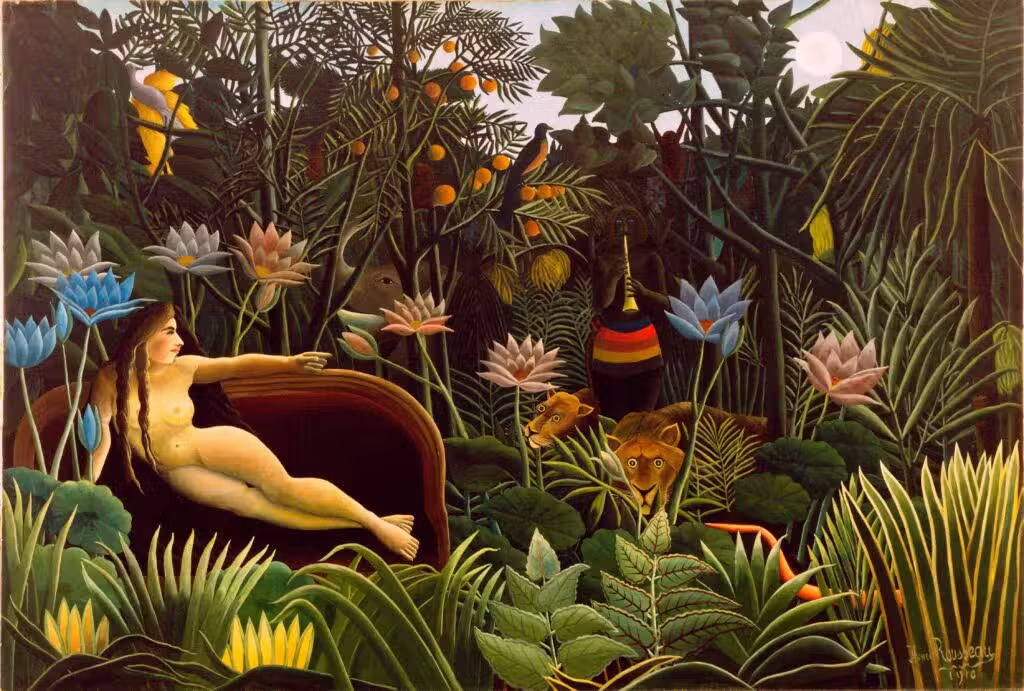
139- The Dream by Henri Rousseau
“The Dream,“ painted by Henri Rousseau in 1910, is a quintessential example of the artist’s naïve and primitive style. The painting depicts a fantastical and exotic scene in which a nude woman reclines on a couch amidst a lush jungle.
The composition features a striking contrast between the central figure of the woman and the vibrant jungle backdrop. The woman is placed prominently in the center, surrounded by dense vegetation, tropical plants, and exotic flowers. The jungle elements are rendered with meticulous detail and a vivid color palette that contrasts with the woman’s pale skin.
The Dream is characterized by its flat perspective and stylized representation of natural elements, hallmarks of Rousseau’s naïve style. The work evokes a sense of dreaming and escapism, blending realistic and imaginary elements to create an atmosphere of mystery and fantasy.
The painting is housed at the Musée d’Orsay in Paris, where it is admired for its visual quality and creative imagination. The Dream remains a central piece in Rousseau’s oeuvre and a significant example of early 20th-century naïve art.

140- The Oath of the Horatii by Jacques-Louis David
“The Oath of the Horatii,” painted by Jacques-Louis David in 1784, is a seminal work of Neoclassicism and a notable example of the artist’s style. The painting depicts a legendary episode from Roman history, showing the Horatii, a family of Roman warriors, swearing to defend their homeland.
The dramatic composition features the three Horatii brothers raising their hands to take an oath before their father, while the women and children of the family in the background express their emotions and concerns. The scene is animated by a stark contrast between the vigor and determination of the men and the sadness of the women.
David employs a subdued color palette and a symmetrical composition to reinforce the themes of loyalty and patriotic sacrifice. The figures are rendered with classical precision, and the painting is structured to direct the viewer’s gaze towards the solemn gesture of the oath.
The Oath of the Horatii is often seen as an illustration of republican ideals and the values of the French Revolution, promoting themes of courage and patriotic duty. The work is housed at the Musée du Louvre in Paris, where it is celebrated for its visual power and historical impact.

141- The Return of the Prodigal Son by Rembrandt van Rijn
“The Return of the Prodigal Son,” painted by Rembrandt van Rijn in 1668, is a masterful work that depicts a scene from the biblical parable of the Prodigal Son, found in the Gospel of Luke. The painting is renowned for its poignant portrayal of reconciliation and forgiveness.
The artwork shows the prodigal son, having returned from his travels and wayward life, being warmly and emotionally welcomed by his father. The father is depicted in an act of forgiveness and love, holding his son in his arms. The scene is filled with emotion, with a soft light highlighting the figures and enhancing the atmosphere of reconciliation.
The Return of the Prodigal Son is distinguished by Rembrandt’s masterful use of light and shadow to create emotional depth and dramatic intensity. The expressions of the characters, their postures, and their interactions are rendered with great sensitivity, illustrating the profound feelings and family relationships.
This masterpiece is housed at the Hermitage Museum in St. Petersburg, where it is celebrated for its emotional richness and technical excellence. The Return of the Prodigal Son remains a central piece in Rembrandt’s oeuvre, symbolizing universal themes of forgiveness and redemption.

142- The Bookworm by Carl Spitzweg
“The Bookworm,” painted by Carl Spitzweg in 1850, is a charming work that exemplifies the Bavarian artist’s distinctive style, known for its detailed and refined genre scenes. This painting depicts a rat, dressed in a small frock coat, reading a book in a richly decorated library.
The painting anthropomorphizes the rat, showing it seated at a table surrounded by ancient books in a richly adorned library setting. The rat is portrayed with a studious and focused expression, adding a touch of humor and satire to the scene. The background details, including the shelves filled with books, lamps, and other library objects, are rendered with care, showcasing Spitzweg’s talent for meticulous representation and social observation.
The Bookworm is often interpreted as a satire of contemporary habits and prejudices, infused with a sense of fantasy and irony. The painting is housed at the Neue Pinakothek in Munich, where it is admired for its visual charm and subtle humor.
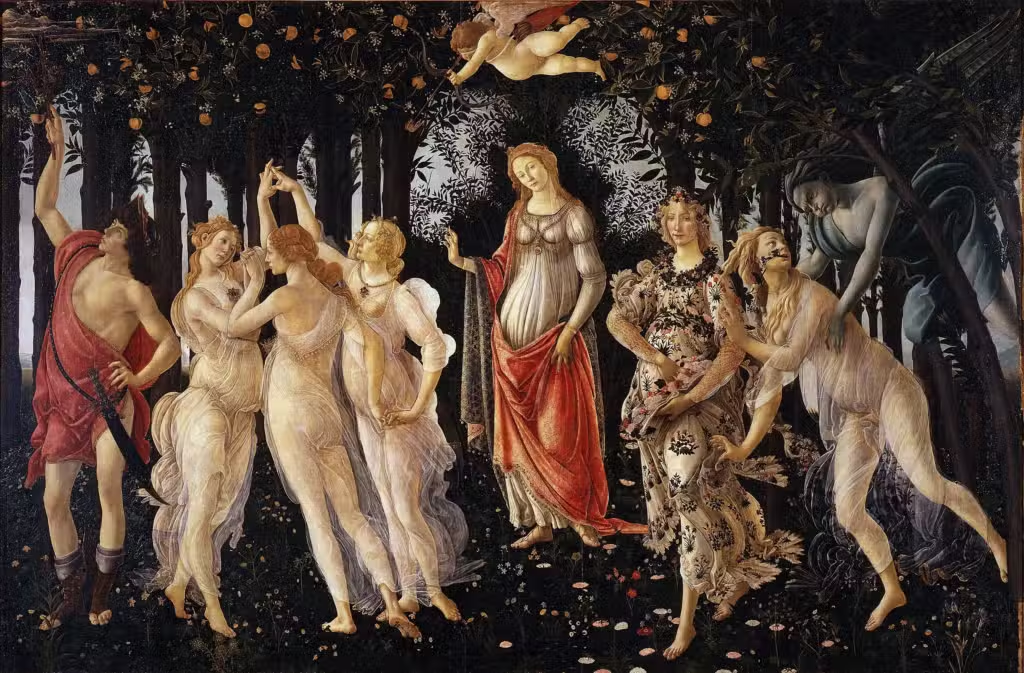
143- Spring by Sandro Botticelli
“Spring,” painted by Sandro Botticelli between 1477 and 1482, is an iconic work of the Italian Renaissance, rich in symbolism and mythological detail. The painting is often interpreted as a celebration of nature and renewal, embodied by the central figure of Venus, the goddess of love and beauty.
The composition of the painting is complex and filled with mythological characters. At the center, Venus is surrounded by various symbolic figures: the Three Graces dance on the left, representing beauty, joy, and love; Mercury, on the right, uses his staff to chase away the clouds; and Chloris, the nymph of flowers, is shown transforming into Flora, the goddess of flowers, scattering blooms across the scene.
The painting is distinguished by its elegant depiction of human figures, flowing lines, and delicate use of color. The floral details and the texture of the characters’ clothing add visual richness, while the arrangement and gestures of the figures create a harmonious sense of movement throughout the composition.
Spring is housed at the Uffizi Gallery in Florence, where it is admired for its timeless beauty and its exploration of mythological and natural themes. The work is a significant example of the Renaissance idealization of beauty and harmony.

144- The Raft of the Medusa by Théodore Géricault
“The Raft of the Medusa,” painted by Théodore Géricault between 1818 and 1819, is a monumental and dramatic work that represents a turning point in Romantic art. The painting is based on the real-life shipwreck of the French frigate Méduse, which ran aground off the coast of Africa in 1816, leading to a disaster where survivors were left adrift on an improvised raft.
The painting depicts a poignant and tense scene, showing the raft’s survivors in a state of extreme despair. Géricault captures the critical moment when the exhausted and dying castaways finally spot a rescue ship on the horizon. The composition is marked by emotional intensity, with the figures expressing pain, fatigue, and resignation.
The Raft of the Medusa is noted for its brutal realism and bold use of light and shadow to emphasize the drama of the scene. The meticulous details and expressive portrayal of the castaways’ bodies enhance the visual impact of the work. The painting is often seen as a powerful critique of the incompetence and corruption of the French authorities of the time.
Housed at the Louvre Museum in Paris, The Raft of the Medusa is celebrated for its emotional power and its significant contribution to the Romantic movement. It remains a central piece in Géricault’s oeuvre and a major example of engaged and dramatic art from the early 19th century.

145- The Poor Poet by Carl Spitzweg
“The Poor Poet,“ painted by Carl Spitzweg in 1839, is an emblematic work of the Bavarian artist’s style, known for his genre scenes and portraits of picturesque characters. This painting depicts a poet composing his verses in a humble and modest setting.
In the painting, the poet is shown seated at a cluttered desk, surrounded by scattered books and papers. He is depicted in worn clothing, deeply absorbed in his work, illustrating the contrast between his rich inner life and his impoverished external environment. The room is dark and dilapidated, with stone walls, simple furniture, and details that underscore the poet’s precarious condition.
The Poor Poet is characterized by its use of muted colors and a composition that highlights the contrast between the character’s intellectual creativity and his material circumstances. Spitzweg uniquely captures the poet’s solitude and dignity, while adding a touch of irony about the challenges artists often face in their pursuit of recognition and success.
The painting is housed at the Neue Pinakothek in Munich, where it is appreciated for its subtle humor and its ability to capture the human condition with both tenderness and critique. The Poor Poet remains a significant example of Spitzweg’s talent for depicting daily life and singular characters from the 19th century.

146- Luncheon on the Grass by Claude Monet
“Luncheon on the Grass,” painted by Claude Monet between 1865 and 1866, is a seminal work of early Impressionism. This painting, often confused with Édouard Manet’s similarly titled work, depicts a scene of outdoor leisure in a distinctly Impressionist style.
The painting shows a group of people enjoying a meal on a lush, green lawn. Monet captures the moment with his characteristic use of natural light and vibrant colors. The scene is bathed in a soft light, and the figures are depicted in relaxed, informal poses, reflecting the simple pleasure of outdoor living.
The composition is marked by fluid brushstrokes and a palette of bright colors that create an atmosphere of freshness and lightness. Monet focuses on the effects of light and the natural environment on the figures and objects, illustrating his interest in capturing visual impressions and changing light conditions.
Luncheon on the Grass is housed at the Musée d’Orsay in Paris, where it is admired for its stylistic innovation and its representation of modernity and nature. This work is a significant example of the transition to Impressionism, marking a departure from the academic conventions of the time in favor of a more spontaneous and visual approach.

147- Luncheon on the Grass by Édouard Manet
“Luncheon on the Grass,” painted by Édouard Manet in 1863, is a revolutionary and controversial work that marks a significant turning point in art history. Presented at the Salon des Refusés in 1863, the painting provoked strong reactions due to its audacious subject matter and innovative style.
The painting depicts an outdoor picnic with a nude woman seated on the grass in front of two clothed men who are having lunch. The incongruity of the naked woman among the dressed figures, along with the direct and unadorned representation of nudity, scandalized contemporary audiences and challenged the artistic and social norms of the time.
Manet employs a realist style and painting technique that contrasts sharply with the traditional academic style. The figures are rendered with sharp outlines and flat colors, lacking the shadows and gradations typical of the period’s artworks. This stylistic choice intensified the shock value of the scene and contributed to the break with prevailing artistic conventions.
Luncheon on the Grass is housed at the Musée d’Orsay in Paris, where it is recognized for its boldness and its impact on the development of modern art. The work is often seen as a precursor to Impressionism, heralding a new era in art with its direct approach and innovative treatment of subject matter and technique.

148- Wheat Field with Cypresses by Vincent van Gogh
“Wheat Field with Cypresses,“ painted by Vincent van Gogh in 1889, is one of the artist’s iconic works, reflecting his unique style and deep connection with nature. This painting is part of a series of landscapes Van Gogh created during his stay at the Saint-Paul-de-Mausole asylum in Saint-Rémy-de-Provence.
The artwork depicts a vast golden wheat field, with vibrant cypress trees rising in the background under a swirling sky. The cypress trees, symbols of death and resurrection in art, add a dramatic, vertical element to the landscape, contrasting with the expansive wheat fields and the undulating sky. The sky is alive with swirls and dynamic movements, creating an impression of motion and turbulence that is characteristic of Van Gogh’s style.
Van Gogh uses expressive brushstrokes and a vibrant color palette to capture the light and atmosphere of the landscape. The textures of the wheat and the shapes of the cypress trees are rendered with emotional intensity, reflecting the artist’s passionate and turbulent state of mind.
Wheat Field with Cypresses is housed at the Musée d’Orsay in Paris, where it is admired for its visual impact and as a striking example of Van Gogh’s post-impressionist technique. The painting remains a poignant illustration of the artist’s ability to transform ordinary landscapes into profound and personal expressions of his experience and imagination.

149- The Sea of Ice by Caspar David Friedrich
“The Sea of Ice,“ painted by Caspar David Friedrich in 1824, is a masterful example of German Romanticism. This painting captures the grandeur and majesty of nature in a style typical of Friedrich, known for his sublimely dramatic and introspective landscapes.
The artwork depicts a vast glacier with imposing ice formations and snow-covered mountains in the background. A group of human figures is visible on the glacier, rendered almost insignificant against the immense landscape. The painting emphasizes the contrast between human fragility and the indomitable power of nature.
Friedrich employs cool tones and meticulous detail to capture the brilliance and texture of the ice, as well as the icy, austere atmosphere of the landscape. The composition highlights the vastness and grandeur of the glacier, evoking a sense of solitude and contemplation.
The Sea of Ice is housed at the Alte Nationalgalerie in Berlin, where it is appreciated for its exploration of natural majesty and the human condition in the face of nature. The painting stands as a quintessential example of how Friedrich uses landscape to express themes of the sublime and melancholic, characteristic of Romanticism.

150- The Maja naked by Francisco de Goya
“The Maja naked,” painted by Francisco de Goya between 1797 and 1800, is one of the most renowned and controversial works of the Spanish artist. This painting is famous for its bold and direct representation of female nudity, which sparked significant debate and controversy at the time of its creation.
The painting depicts a nude woman reclining on a couch with a relaxed posture and a direct gaze towards the viewer. Goya’s use of light and shadow enhances the forms and contours of the body, emphasizing the sensuality and beauty of the model. The composition is both intimate and audacious, pushing boundaries with its candid portrayal.
“The Maja naked” is often compared to “The Maja naked,” another of Goya’s works featuring the same woman, but clothed. The exact reasons behind these two paintings remain shrouded in mystery, and their association with Spanish high society, along with their daring content, has fueled speculation about the model’s identity and the circumstances of their commission.
Housed at the Museo del Prado in Madrid, “The Maja naked” is celebrated for its refined technique and its ability to capture beauty with an honesty and boldness that were unusual for the period. The work remains a central piece in Goya’s oeuvre and is a significant example of the representation of nudity in European art.

151 – The Saint-Lazare Station by Claude Monet
“The Saint-Lazare Station“, painted by Claude Monet in 1877, is an iconic example of Impressionism and a significant representation of how Monet captured the modernity of Paris in the late 19th century. This painting is one of several Monet created on this subject, reflecting his fascination with urban scenes and the effects of light and steam.
The painting depicts the Saint-Lazare Station, one of Paris’s major railway hubs, with a particular focus on the movement and atmosphere of the railway scene. Monet skillfully captures the steam from the trains, the light streaming through the station’s windows, and the metallic structures that form the architecture of the station. The composition is characterized by quick brushstrokes and a vibrant color palette, creating a dynamic and fluid impression of the station’s bustling activity.
Monet employs Impressionist techniques to convey the motion and changing light, as well as to express the city’s industrial modernity. The painting is marked by a misty, luminous atmosphere where details are suggested rather than rendered with precision, a hallmark of the Impressionist style.
“The Saint-Lazare Station” is housed at the Musée d’Orsay in Paris, where it is celebrated for its ability to capture the essence of urban modernity and its technical innovation. The work stands as a significant example of how Monet explored themes of industrial change and light in art, contributing to the evolution of the Impressionist movement.
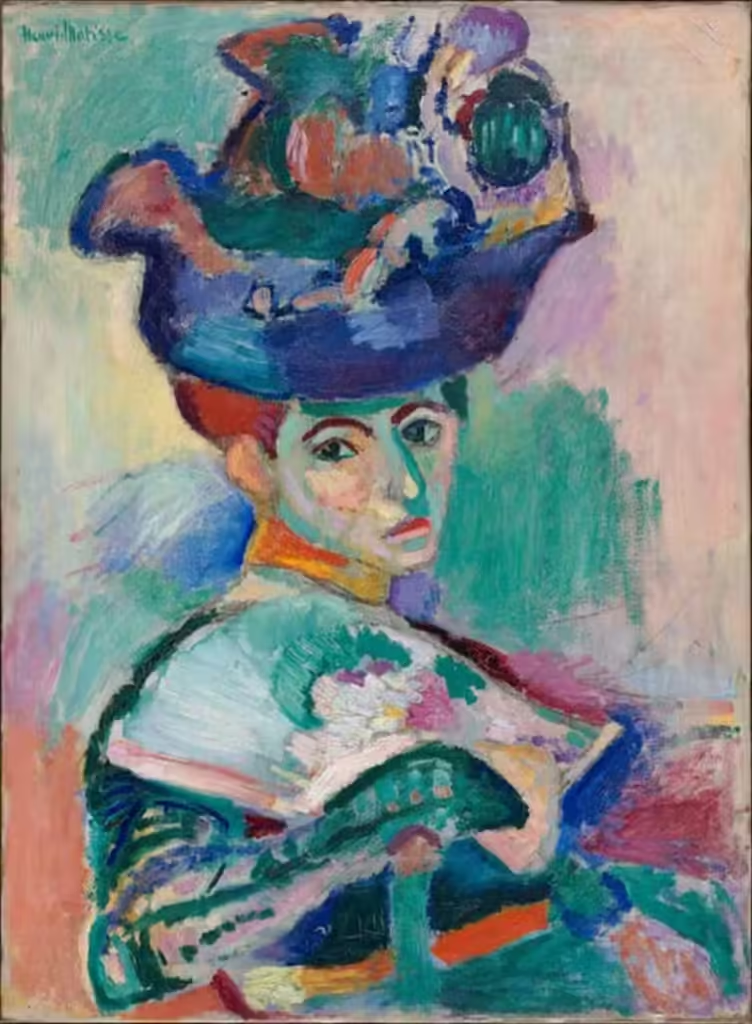
152 – The Woman with a Hat by Henri Matisse
“The Woman with a Hat“, painted by Henri Matisse in 1905, is an iconic work of Fauvism, a revolutionary art movement from the early 20th century. This painting is renowned for its bold use of color and simplified forms, marking a significant shift in the history of modern art.
The portrait depicts an elegant woman wearing a large hat adorned with feathers and ribbons. Matisse employs vivid, non-representational colors applied in broad strokes to create a striking visual effect. The woman is portrayed with simplified features against a vibrant background, contrasting sharply with the more naturalistic representations of the time.
The composition is characterized by its expressive use of color and a fluid, dynamic style. The bright colors and bold outlines are typical of Fauvism, which advocates an emotional and personal approach to color, emphasizing visual impact over faithful representation of reality.
“The Woman with a Hat” was exhibited at the Salon d’Automne in 1905, where it became associated with the term “Fauvism” (derived from the French word “fauves,” meaning “wild beasts”), describing how artists used color in a wild and expressive manner. The work is now housed at the Musée d’Orsay in Paris, where it is celebrated for its significant role in the development of Fauvism and its influence on the evolution of modern art.
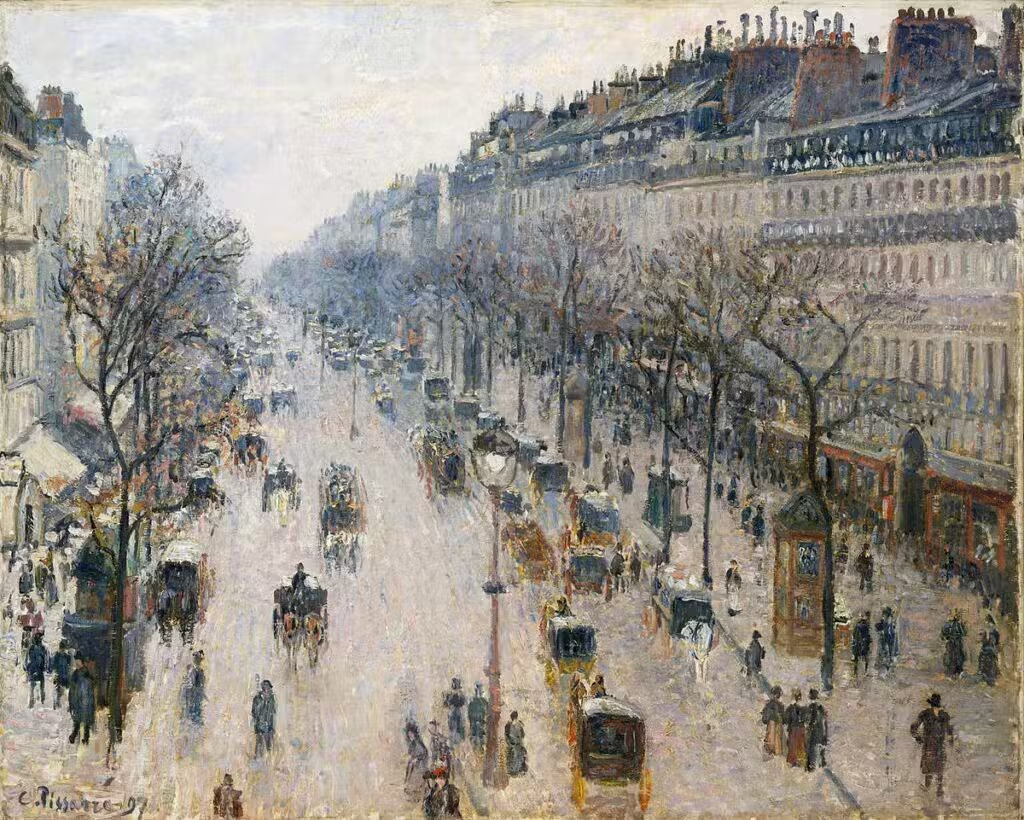
153 – Boulevard Montmartre on a Winter Morning by Camille Pissarro
“Boulevard Montmartre on a Winter Morning“, painted by Camille Pissarro in 1897, is a quintessential example of Impressionism, showcasing the artist’s skill in capturing urban atmospheres and the effects of light on everyday scenes.
The painting depicts a view of Boulevard Montmartre in Paris, covered by a light morning snow. Pissarro uses a palette of soft, cool colors to illustrate the wintry atmosphere with touches of white and gray. The bare trees lining the boulevard, the buildings in the background, and the pedestrians in their coats are rendered with quick, fluid brushstrokes that convey a sense of movement and light.
The work is notable for its use of light to render the effects of snow and the morning glow. Pissarro successfully conveys the depth and texture of the wintry urban landscape while maintaining the spontaneity and vibrancy typical of Impressionism. The cityscape is both dynamic and serene, demonstrating Pissarro’s skill in capturing the nuances of the urban environment and expressing atmospheric changes.
“Boulevard Montmartre on a Winter Morning” is housed at the Musée d’Orsay in Paris, where it is admired for its ability to capture the essence of a specific moment and place, as well as for its contribution to the Impressionist vision of urban life. The painting remains a valuable example of Pissarro’s talent for representing the beauty and complexity of everyday scenes.
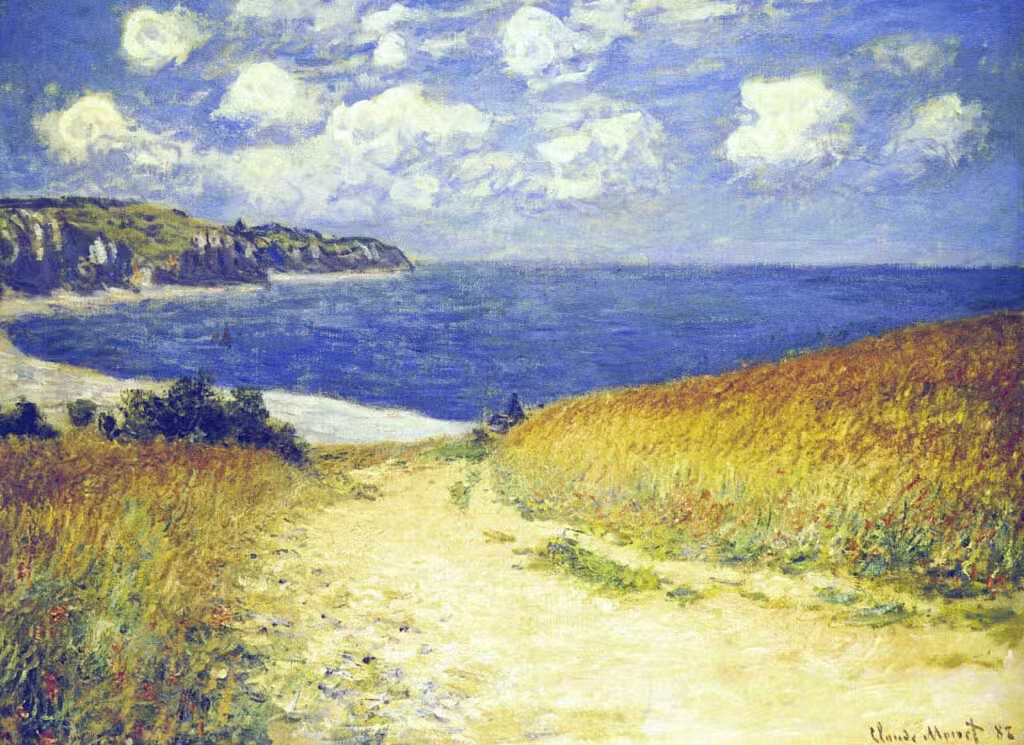
154 – Path in the Wheatfields at Pourville by Claude Monet
“Path in the Wheatfields at Pourville“, painted by Claude Monet in 1882, is a notable example of Impressionism, showcasing Monet’s talent for capturing light and texture in natural landscapes.
The painting depicts a winding path bordered by golden wheat fields, with a bright and clear sky overhead. Monet uses vibrant brushstrokes and luminous colors to convey the play of light on the wheat ears and the path’s surface. The scene is bathed in a golden light, evoking the warmth and tranquility of a summer day in the countryside.
The composition is characterized by a fluid perspective and a sense of movement, with the path meandering through the field, guiding the viewer’s eye through the landscape. Monet captures the depth and richness of the Pourville landscape, a coastal village in Normandy, with a technique that emphasizes the natural beauty and simplicity of the rural setting.
“Path in the Wheatfields at Pourville” is an excellent example of Monet’s Impressionist approach, focusing on capturing atmospheric effects and visual sensations rather than precise details. The painting is housed at the Musée d’Orsay in Paris, where it is admired for its poetic representation of nature and its contribution to the evolution of Impressionism.

155 – Self-Portrait (David) by Jacques-Louis David
“Self-Portrait“, created by Jacques-Louis David around 1800, is a significant work of Neoclassicism and one of the many self-portraits by this influential artist.
In this painting, David presents himself in a style characteristic of Neoclassicism, with a keen attention to detail and a formal approach to composition. The artist is depicted in bust, with a contemplative expression and a direct gaze, often interpreted as a demonstration of his artistic mastery and confidence in his own talent.
David employs subdued colors and precise lighting to create an effect of realism and dignity. The background is typically neutral or understated, allowing the focus to remain on the face and the details of the expression. The work is executed with meticulous technique that highlights the quality of the drawing and the accuracy of the rendering of textures.
“Self-Portrait” not only stands as a testament to David’s importance as a master of Neoclassicism but also reflects his influence on the art and culture of his time. The painting is housed at the Musée du Louvre in Paris, where it is admired for its striking representation of the artist and its role in the development of Neoclassical art.

156 – The Baptism of Christ by Leonardo da Vinci
“The Baptism of Christ“, painted by Leonardo da Vinci around 1472-1475, is an early work that marks the beginning of the artist’s career in religious painting. This piece was created in collaboration with his master, Andrea del Verrocchio, whose influence is also evident in certain parts of the work.
The scene depicts the moment when John the Baptist baptizes Jesus Christ in the Jordan River. Leonardo da Vinci focuses on expressive details and realistic representation of the figures, using chiaroscuro techniques to enhance depth and three-dimensionality.
“The Baptism of Christ” is notable for its innovative use of light and shadow to create a sense of volume and depth. Jesus is depicted nude and in an elegant pose, while John the Baptist, dressed in animal skins, is captured in a gesture of blessing. The angel on the left, holding Jesus’ garments, exemplifies the meticulous attention given to detail and the texture of the drapery.
The painting is housed at the Uffizi Gallery in Florence. It is recognized for its significance in the development of Leonardo da Vinci’s style and its contributions to painting techniques during the Renaissance. The careful work on expressions and bodily details demonstrates Leonardo’s early attention to realism and anatomy, elements that would become hallmarks of his later work.

157 – The Night Café by Vincent van Gogh
“The Night Café,“ painted by Vincent van Gogh in 1888, is one of the artist’s most famous works and a prime example of his mastery of color and technique to convey emotions and a specific atmosphere.
The painting depicts the interior of a café in Arles, where Van Gogh was living at the time. The scene is energized by vibrant, saturated colors, with the walls and furniture painted in bold reds and greens. The intense hues and energetic brushstrokes create an atmosphere of warmth and turbulence, reflecting the liveliness and restlessness of the nighttime environment.
Van Gogh employs striking color contrasts and curving lines to express the movement and energy of the space. The lighting, primarily from the café’s lamps, enhances the intense ambiance of the scene. The figures, though rendered in a simplified manner, are integrated into the composition in a way that reinforces the café’s vibrant and slightly oppressive atmosphere.
“The Night Café” is often interpreted as an exploration of nightlife and the impact of color on emotions. The work is housed at the Musée d’Orsay in Paris, where it is celebrated for its innovative use of color and its ability to convey a unique and personal ambiance. The painting is also an iconic example of Van Gogh’s expressive use of colors and shapes to capture moments from daily life.

158 – The Friends by Gustav Klimt
“The Friends,” painted by Gustav Klimt between 1917 and 1918, is a remarkable work that highlights the artist’s distinctive style and recurring themes while showcasing his later artistic explorations.
The painting depicts two women in an intimate and elegant pose, symbolizing friendship and camaraderie. The figures are surrounded by decorative motifs and ornaments characteristic of Klimt’s style. The work exudes a gentle sensuality and is richly ornamental, with meticulous attention to the details of the clothing and textures.
The colors are generally soft and harmonious, dominated by golden tones and floral patterns, creating a subtle contrast with the silhouettes of the characters. Klimt’s technique, which often involves geometric shapes and complex patterns, is evident in the decorative details and backgrounds.
“The Friends” exemplifies Klimt’s continued exploration of the relationship between the human figure and decoration, while integrating symbolic and emotional elements. The painting is held in a private collection and is frequently admired for its beauty and refinement, hallmarks of Klimt’s work.
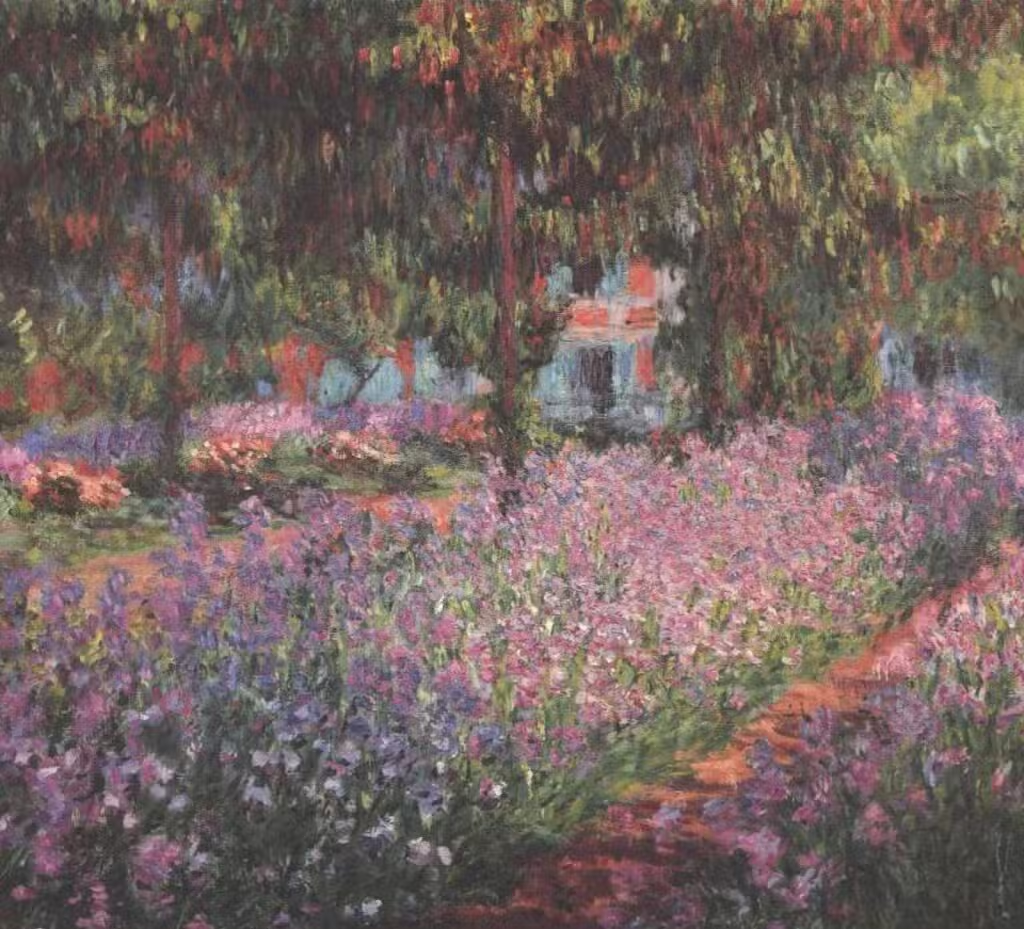
159 – The Artist’s Garden at Giverny (Iris) by Claude Monet
“The Artist’s Garden at Giverny (Iris),” painted by Claude Monet in 1889, is an emblematic work that showcases Monet’s talent for capturing the beauty of gardens and flowers, as well as his deep affection for his own garden at Giverny.
The painting depicts a lush tangle of blooming irises in Monet’s garden, with vibrant touches of blue, purple, and white. Monet employs a rich color palette and fluid brushstrokes to evoke the light and texture of the flowers. The irises are painted in a way that makes them appear almost in motion, with swift and dynamic brushstrokes reflecting the brilliance and diversity of colors in the garden.
The composition focuses on the irises but also includes elements of greenery and other flowers, creating an effect of lushness and depth. Monet captures the changing quality of light on the petals and foliage, illustrating his interest in atmospheric variations and light effects.
“The Artist’s Garden at Giverny (Iris)” is housed at the Musée d’Orsay in Paris. This painting is a prime example of Monet’s impressionist style and his love for nature and his garden. It demonstrates Monet’s ability to transform seemingly ordinary garden scenes into vibrant and expressive works of art, using color and light to create an immersive visual experience.
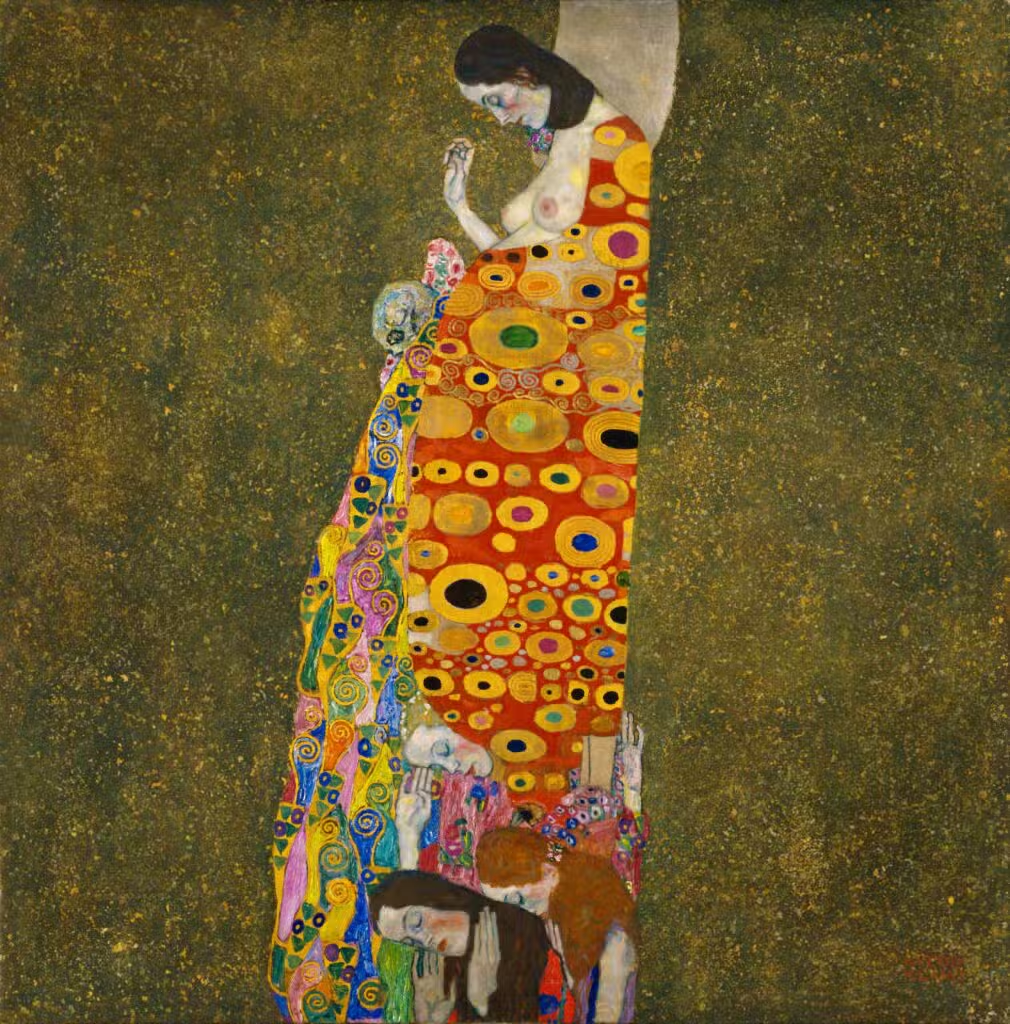
160 – Hope II by Gustav Klimt
“Hope II,” painted by Gustav Klimt in 1907, is a powerful work that embodies themes of maternity and hope, characteristic of Klimt’s symbolist period.
The painting depicts a pregnant woman draped in garments adorned with decorative patterns, holding a baby in her arms. The maternal figure is central to the composition, surrounded by symbolic forms and motifs that evoke protection, hope, and the continuation of life. The woman’s serene expression conveys both tranquility and dignity.
Klimt uses a warm color palette, with golden touches and intricate patterns to enhance the visual richness of the work. The background is often decorative and stylized, incorporating floral and geometric elements that contribute to the painting’s dreamlike and symbolic quality.
“Hope II” is a poignant expression of Klimt’s style, merging symbolism with decorative richness. The painting is held in a private collection and continues to be admired for its moving representation and distinctive use of patterns and color to explore universal and emotional themes.
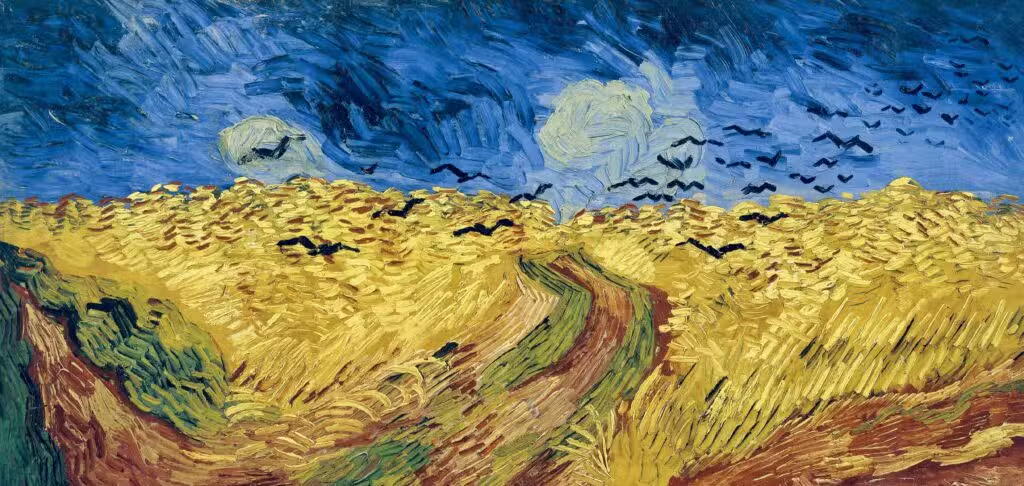
161 – Wheat Field with Crows by Vincent van Gogh
“Wheat Field with Crows,” painted by Vincent van Gogh in July 1890, is one of the artist’s most famous works, often associated with his final years and his tumultuous state of mind.
The painting depicts a vast wheat field under a stormy sky, with crows flying above the field. Van Gogh’s vivid colors and expressive brushstrokes capture the emotional intensity of the landscape. The wheat field is painted in golden yellow, contrasting starkly with the dark, threatening sky, while the crows add a dramatic element to the scene.
The rapid, swirling brushstrokes create dynamic movement and a rich texture, giving the painting a sense of turbulence and urgency. The sky, with its menacing clouds and turmoil, reflects Van Gogh’s mental state at the time, while the wheat field, central to the composition, symbolizes both beauty and inevitability.
“Wheat Field with Crows” is often interpreted as an expression of Van Gogh’s personal distress and mental state towards the end of his life. It is housed at the Van Gogh Museum in Amsterdam, where it is admired for its emotional power and innovative use of color and texture. This painting remains a poignant testament to Van Gogh’s artistic vision and inner struggle.

162 – Dance at Le Moulin de la Galette by Pierre-Auguste Renoir
“Dance at Le Moulin de la Galette,” painted by Pierre-Auguste Renoir in 1876, is a quintessential example of Impressionism and vividly captures the social life of Paris in the late 19th century.
The painting depicts a lively scene at a popular dance held at Le Moulin de la Galette, a well-known entertainment venue in Montmartre, Paris. The composition is vibrant and full of movement, showing couples dancing and socializing under dappled light filtering through the trees. Renoir employs a palette of bright and lively colors to convey the cheerful and festive atmosphere of the event.
The figures are painted with quick, light brushstrokes, creating a sense of fluidity and spontaneity. The details of the clothing and expressions capture the relaxed and convivial nature of the gathering, emphasizing social interactions and the pleasures of everyday life.
“Dance at Le Moulin de la Galette” is renowned for its Impressionistic rendering of light and shadow, as well as for its ability to convey the energy and vivacity of the scene. The painting is housed at the Musée d’Orsay in Paris and is celebrated for its contribution to the development of Impressionist style, as well as for its portrayal of the joie de vivre and charm of Parisian society in the 19th century.

163 – The Virgin, Jesus, and Saint John the Baptist by William Bouguereau
“The Virgin, Jesus, and Saint John the Baptist,“ painted by William Bouguereau in 1875, is a quintessential example of 19th-century academic art, showcasing the distinctive features of the artist’s style.
The painting depicts a classical religious scene featuring the Virgin Mary, the Infant Jesus, and Saint John the Baptist. Bouguereau portrays the figures with striking realism and meticulous attention to detail. The Virgin is shown holding Jesus in her arms, while Saint John the Baptist is depicted in a posture of devotion, often with an expression of serenity.
The figures are rendered with remarkable precision in their bodily forms and draperies, highlighting Bouguereau’s technical mastery in academic painting. The colors are soft and harmonious, creating a calm and pious atmosphere. The background often includes pastoral or landscape elements that add depth and context to the religious theme of the work.
“The Virgin, Jesus, and Saint John the Baptist” is admired for its refined technique, balanced composition, and its ability to capture the spiritual and emotional dimension of the subject. The painting is representative of Bouguereau’s style, which favored realism and elegance in his religious and mythological representations.

164 – Rue Montorgueil, Festivities of June 30, 1878 by Claude Monet
“Rue Montorgueil, Festivities of June 30, 1878,“ painted by Claude Monet in 1878, is a remarkable work that captures the exuberance of a public celebration in Paris. This painting vividly represents the French Republic’s fête held on June 30, 1878, during the Exposition Universelle in Paris that year.
The painting depicts Rue Montorgueil, bustling with a joyous and colorful crowd celebrating the event. Monet employs a vibrant color palette and a swift brushstroke technique to convey the energy and movement of the scene. The tricolor flags, decorations, and crowds are painted with dynamic strokes, creating a sense of light and motion.
The composition is characterized by its impressionistic approach, with brushstrokes capturing the light and atmosphere of the event rather than focusing on precise details. The figures are rendered in a fluid and relaxed manner, contributing to the overall effect of collective celebration and joy.
“Rue Montorgueil, Festivities of June 30, 1878” is housed in the Musée d’Orsay in Paris. The painting perfectly illustrates Monet’s interest in capturing everyday moments and events, using light and color to convey the vibrant and festive atmosphere of the time.

165 – The Night Watch by Rembrandt van Rijn
“The Night Watch,“ painted by Rembrandt van Rijn in 1642, is one of the most renowned works by the Dutch master and a masterpiece of the Dutch Golden Age. Officially titled “The Company of Frans Banning Cocq and Willem van Ruytenburch,” the painting depicts a militia company preparing for a nocturnal patrol.
The painting is remarkable for its dynamic composition and masterful use of lighting. Unlike the static group portraits typical of the time, Rembrandt employs dramatic lighting and deep shadows to create a lively and animated scene. The figures are depicted in active poses with varied expressions, illuminated by focused light that accentuates their presence and individuality.
The painting features Captain Frans Banning Cocq, dressed in black with a red sash, and his lieutenant, Willem van Ruytenburch, in golden attire. They are surrounded by their militia companions, portrayed in a range of poses and activities, conveying a sense of readiness and vigilance.
“The Night Watch” is celebrated for its innovative use of light and composition, transforming a group portrait into a dynamic and engaging scene. The work is housed in the Rijksmuseum in Amsterdam, where it is admired for its technical grandeur and dramatic impact. It stands as a quintessential example of Rembrandt’s genius in capturing the essence of his subjects through masterful use of light and shadow.
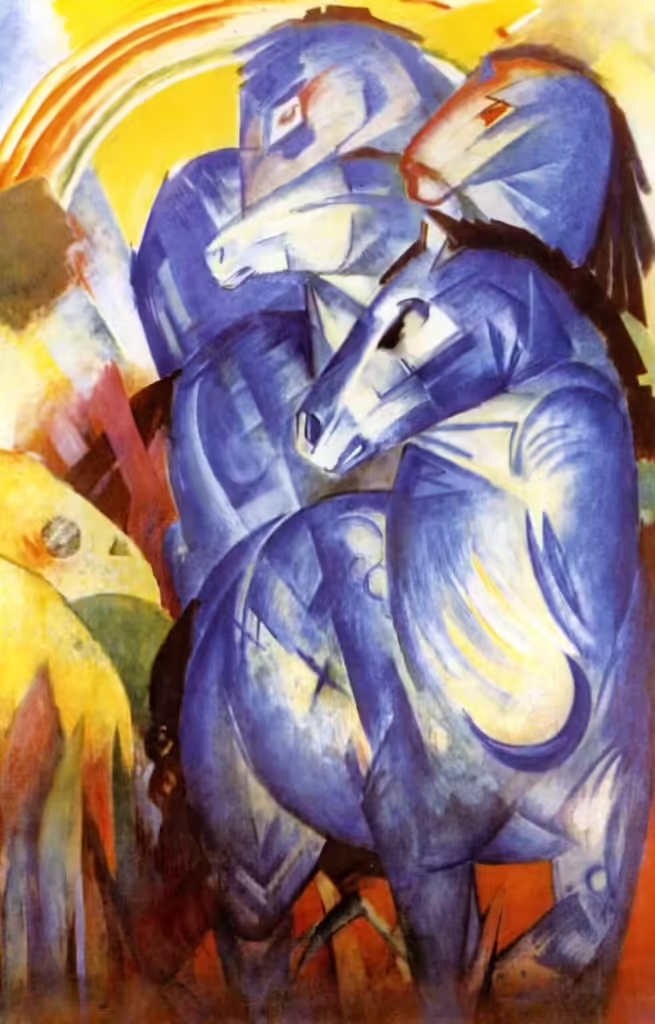
166 – The Tower of the Blue Horses by Franz Marc
“The Tower of the Blue Horses,” painted by Franz Marc in 1913, is a quintessential example of German Expressionism and a notable representation of the artist’s distinctive style.
The painting features a vibrant and dynamic composition centered on horses depicted in intense shades of blue, which dominate the canvas. A monumental and stylized tower rises in the background, adding an architectural dimension to the landscape. The color palette is bold and expressive, with a predominance of blues and greens that evoke a mystical and emotional atmosphere.
Marc, known for his fascination with animals and his ability to convey emotions through color, employs geometric shapes and vivid hues to explore the relationship between nature and architecture. The depiction of horses—often symbolizing freedom and power in Marc’s work—is rendered in a stylized yet expressive manner, emphasizing their prominent role in the painting.
“The Tower of the Blue Horses” is an excellent example of how Franz Marc used symbolism and color to create compositions that capture the emotional essence of his subjects. The painting is held in a private collection and continues to be admired for its unique fusion of abstraction and emotion with striking visual intensity.

167 – Starry Night Over the Rhône by Vincent van Gogh
“Starry Night Over the Rhône,“ painted by Vincent van Gogh in 1888, is a seminal work that showcases the artist’s fascination with the effects of nocturnal light and the beauty of the starry sky.
The painting depicts a view of the Rhône River, with shimmering reflections of city lights on the calm water. The night sky is dominated by a swirling array of bright stars, rendered with vibrant and swirling brushstrokes that capture the intensity of the light. The stars and constellations are depicted with a dynamism that contrasts with the tranquil aquatic landscape.
At the bottom of the canvas, the lights from streetlamps and buildings reflect on the water, adding depth and movement to the scene. Van Gogh employs expressive brushstrokes to create a visual effect that conveys both the serenity of the nocturnal landscape and the magic of the stars.
“Starry Night Over the Rhône” is often regarded as a precursor to Van Gogh’s more famous work, “Starry Night,” painted the following year. This piece is held at the Musée d’Orsay in Paris and is celebrated for its innovative use of color and light, as well as for its poignant expression of nighttime beauty.
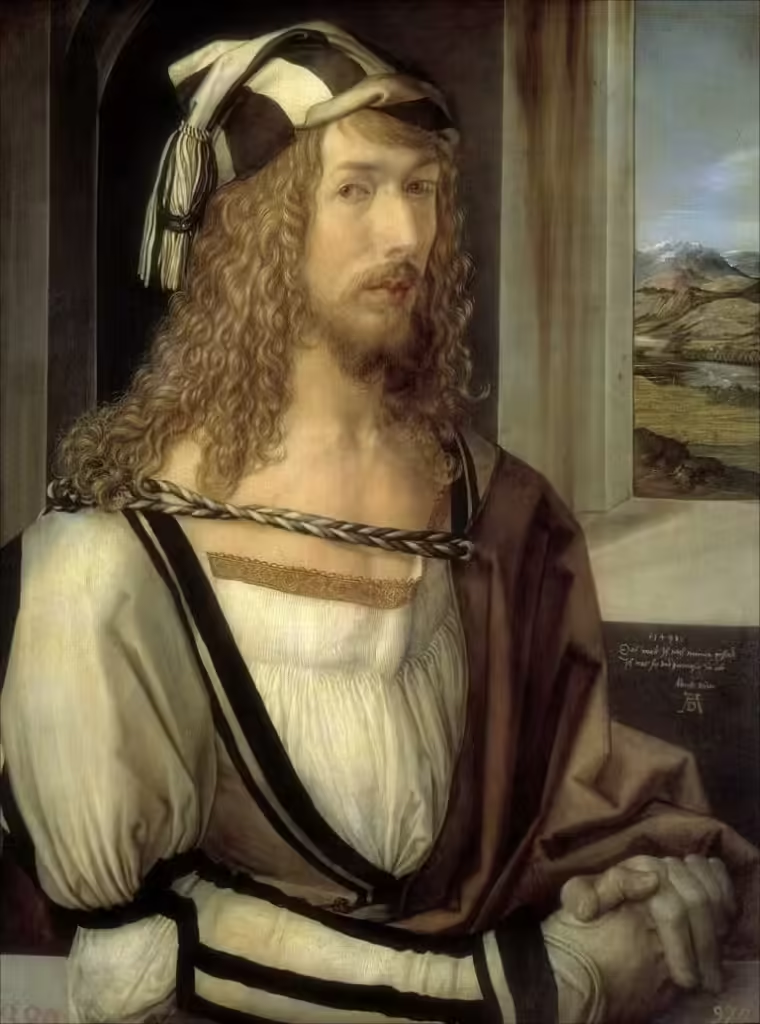
168 – Self-Portrait by Albrecht Dürer
“Self-Portrait,“ painted by Albrecht Dürer in 1500, stands as one of the most iconic works of the Northern Renaissance. This portrait is notable not only for its artistic style but also for its personal and historical significance.
Dürer presents himself in a frontal pose, with a serious expression and a majestic demeanor. The portrait is often compared to a religious icon due to its composition and the way Dürer portrays himself almost as a “man of God,” with elements that evoke religious traditions. The meticulous detail in the rendering of his hair and clothing reflects Dürer’s precision and mastery.
The painting is executed in oil on wood, and Dürer employs techniques of light and shadow to create depth and realism. The background is neutral, focusing attention on Dürer’s face and the intricacies of his attire.
“Self-Portrait” is housed at the Alte Pinakothek in Munich. This work is not only a masterpiece of individual portraiture from the Renaissance but also a testament to Dürer’s importance in the history of European art. It showcases his dedication to exploring artistic technique and the precise representation of human personality.

169 – Le Désespéré by Gustave Courbet
“Le Désespéré” by Gustave Courbet is a powerful depiction of profound human anguish. Painted between 1843 and 1845, this work is a striking self-portrait of the artist, capturing his intense emotional turmoil. The painting portrays Courbet with wide-open eyes and an open mouth in a silent scream, conveying a palpable sense of despair. The stark contrast between the clarity of his face and the surrounding darkness enhances the dramatic impact of the piece.
This painting is not merely a portrayal of personal anxiety but also serves as a significant artistic statement. As a leading figure of Realism, Courbet uses “Le Désespéré” to challenge the academic conventions of his time, presenting human emotions with unprecedented honesty. The painting, though intimate as a self-portrait, transcends personal experience to explore universal themes of fear and suffering.
The somber and oppressive atmosphere, highlighted by Courbet’s rich brushstrokes, reflects an existential despair. “Le Désespéré” is often seen as a reflection of the artist’s uncertainty about his future and his desire to assert himself in a rapidly changing art world. The work remains one of the most compelling representations of psychological distress in Western art history.
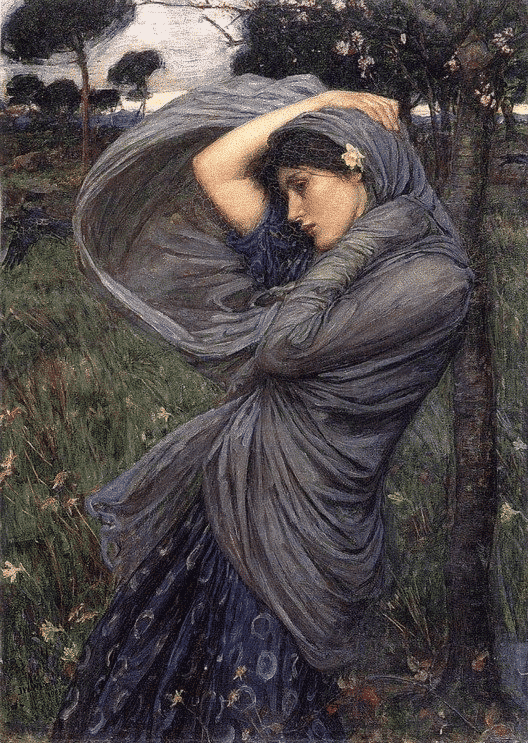
170 – Borée by John William Waterhouse
“Borée“, painted in 1903 by John William Waterhouse, embodies the ethereal and mystical beauty of the female figures that populate the artist’s work. Inspired by Boreas, the Greek god of the north wind, this painting depicts a young woman caught in the powerful gusts of the wind, her clothing and hair swept up by the icy breeze. The figure, graceful yet vulnerable, represents both delicacy and strength in the face of natural forces—a recurring theme in Waterhouse’s art.
Known for his mythological and literary compositions, Waterhouse captures in “Borée” a moment suspended between serenity and turmoil. The cool tones of the painting, dominated by shades of blue and gray, enhance the sense of cold and solitude. The meticulously detailed flowing robe and expressive face of the young woman showcase Waterhouse’s skill in blending realism with imagination.
“Borée” is aligned with the Pre-Raphaelite movement, with which Waterhouse was closely associated. The painting reflects the movement’s fascination with nature, emotion, and timeless beauty. By portraying the young woman as both fragile and resilient against the elements, Waterhouse provides a romantic vision of the struggle between humanity and nature, celebrating the poetic aesthetics that define his work.
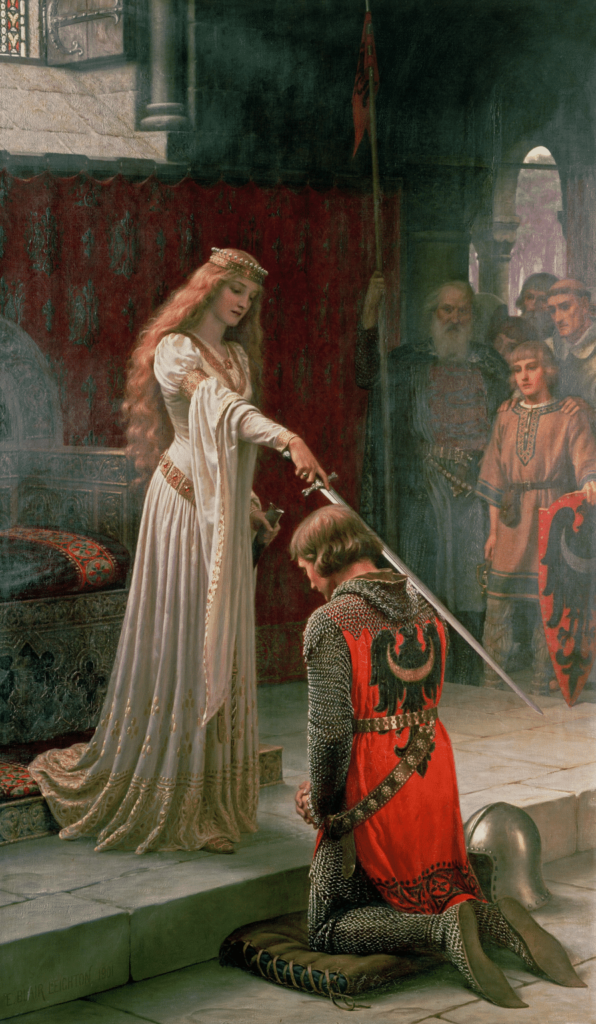
171 – L’Adoubement by Edmund Leighton
“L’Adoubement“, painted in 1901 by Edmund Leighton, is an iconic example of Victorian romanticism that captures a solemn moment of chivalry and honor. The painting depicts a knighthood ceremony, where a noble lady, dressed in a sumptuous gown, touches the shoulder of a kneeling knight with a sword, symbolizing his elevation to knighthood. The tableau evokes a sense of nobility, chivalric ideals, and elegance, reinforced by the intricate details of medieval costumes and the Gothic architecture that forms the backdrop.
Leighton, known for his meticulous attention to historical detail and narrative compositions, imbues “L’Adoubement” with an atmosphere of heroism and romanticism. The contrast between the lady’s radiant white gown and the knight’s gleaming armor highlights the purity and solemnity of the scene. The knight’s bowed head and the lady’s graceful posture suggest mutual reverence, emphasizing the relationship of respect and honor between the two figures.
The painting beautifully embodies the idealization of chivalry and the medieval period, themes cherished by Pre-Raphaelite and Victorian artists. “L’Adoubement” invites viewers to immerse themselves in a world of legend and tradition, where honor and loyalty are supreme values. The work remains one of the most iconic images of Victorian romantic art, celebrating the timeless beauty of chivalric rituals.

172 – Salvator Mundi by Leonardo da Vinci
“Salvator Mundi“, painted by Leonardo da Vinci in the early 16th century, stands as one of the most enigmatic and captivating works of the Renaissance. The painting depicts Christ as the Savior of the World, dressed in a royal blue robe, raising his right hand in a gesture of blessing, while his left hand holds a crystal orb, symbolizing his divine power over the universe. The serene and calm expression of Christ contrasts with the mystery surrounding the painting, notably due to its debated attribution and complex history.
Leonardo, a master of light and shadow, employs his expertise in sfumato—an intricate technique of blending colors and tones to create soft, realistic contours. The face of Christ radiates a divine softness, and the crystal orb is rendered with meticulous precision, capturing light in a near-supernatural manner. This blend of realism and mystical symbolism imparts a spiritual depth to the work, transforming a simple representation into a visual meditation on the nature of the divine.
“Salvator Mundi” has traversed the centuries with an aura of mystery, from rediscovery to restoration, and gained worldwide notoriety when it was sold for a record-breaking price in 2017. Beyond its monetary value, the painting remains a testament to Leonardo da Vinci’s ingenuity, seamlessly merging art and spirituality in a captivating work that invites viewers to contemplate the sacred and reflect on the universal significance of the Christ figure.

173 – Dante et Virgile by William Bouguereau
“Dante et Virgile“, painted by William Bouguereau in 1850, is a masterful work inspired by a scene from Dante Alighieri’s Divine Comedy, specifically from the eighth circle of Hell. The painting depicts an intense moment where two damned souls, Capocchio, an heretical alchemist, and Gianni Schicchi, a fraudster, are engaged in a violent and desperate struggle. This scene is observed from a distance by Dante and his guide, Virgil, who stand as witnesses to the eternal suffering and savagery of Hell’s punishments.
Bouguereau, renowned for his technical virtuosity, captures this dramatic scene with striking realism. The muscular and tortured bodies of the damned are rendered in exquisite detail, illustrating the opposing forces of violence and resistance. The color palette, dominated by warm and dark hues of red and orange, enhances the infernal atmosphere of the painting. The stoic posture of Dante and Virgil contrasts sharply with the intensity of the struggle, emphasizing their role as powerless witnesses to the horrors of Hell.
This painting represents a departure from Bouguereau’s usual style, known for its softer and idealized scenes. Here, the artist delves into the darker aspects of the human condition with rare dramatic and emotional power. “Dante et Virgile” is not only a demonstration of Bouguereau’s technical mastery but also a reflection on the duality of the human soul, torn between good and evil, suffering and redemption.

174 – The Death of Cleopatra by John Collier
“The Death of Cleopatra,” painted by John Collier in 1890, is a powerful and poignant depiction of the final moments of the legendary Egyptian queen. In this dramatic work, Collier portrays Cleopatra in a moment of majestic resignation, seated on an opulent throne and draped in sumptuous white robes. The painting captures her at the exact moment she embraces death after being bitten by an asp—a symbol of her refusal to succumb to Roman rule. Her gaze is distant and detached, focused on the infinite, while the serpent coils around her arm, poised to deliver its fatal venom.
The atmosphere of the painting is both solemn and silent, enhanced by the soft lighting and golden tones that envelop Cleopatra’s figure. The intricate details of the scene—the ornate throne, Egyptian motifs, and the elegant folds of her attire—highlight the queen’s former splendor while underscoring the inexorable decline of her reign. Collier masterfully captures both Cleopatra’s power and vulnerability, depicting her as a tragic yet indomitable figure, facing her fate with dignity.
“The Death of Cleopatra” is part of the Victorian tradition of glorifying historical female figures, imbuing them with a romanticized aura. Through this painting, Collier transcends mere historical representation to explore universal themes such as death, freedom, and resistance against defeat. Cleopatra emerges as an enduring symbol of defiance against oppression, marking her final act of sovereignty with tragic beauty and unforgettable strength of character.

175 – The Beheading of Saint John the Baptist by Caravaggio
“The Beheading of Saint John the Baptist,” painted by Caravaggio in 1608, is a powerful and dramatic work that captures a brutally intense moment in Christian history. This painting depicts the martyrdom of Saint John the Baptist at the exact moment the executioner, armed with a sword, carries out the beheading. The tableau is a striking illustration of violence and brutality, true to Caravaggio’s realist and dramatic style. The saint is portrayed with a face marked by pain and resignation, providing a stark contrast to the violent scene unfolding around him.
Caravaggio employs his signature chiaroscuro technique to enhance the drama of the scene. The light sharply illuminates the face of Saint John the Baptist, highlighting his expressions of anguish and calm resignation, while the rest of the scene is plunged into unsettling darkness. The executioner and surrounding figures are depicted with brutal precision, and the scene is stripped of any superfluous ornamentation, focusing the viewer’s attention on the act of decapitation and the emotions it evokes.
The painting is also notable for its treatment of martyrdom and suffering, staying true to the Baroque tradition of direct and unidealized representation of religious events. Caravaggio’s realistic and intense approach makes “The Beheading of Saint John the Baptist” not only a depiction of the saint’s sacrifice but also a profound invitation for the viewer to reflect on the nature of martyrdom and human brutality. The painting is a powerful demonstration of Caravaggio’s art, combining raw emotion with technical virtuosity to create a work of unforgettable dramatic force.

176 – Icarus by Henri Matisse
“Icarus,” painted by Henri Matisse in 1947, is an iconic work that reimagines the myth of Icarus with the artist’s distinctive touch. This abstract and daring painting portrays the mythological figure of Icarus, whose wax wings melted as he flew too close to the sun. Staying true to his vibrant and colorful style, Matisse uses a bold palette of blues, reds, and yellows to capture the movement and energy of the myth, while simplifying shapes and contours.
The artwork depicts Icarus in mid-plunge, his wings spread in a fluid yet unsettling motion, while his body seems to disintegrate into the air. Known for his innovative use of color and form, Matisse employs flowing lines and stylized shapes to convey the dynamism and tragedy of Icarus’s fall. The contrast between the vivid colors and the darker background accentuates the dramatic tension of the scene, creating a visually captivating composition.
“Icarus” represents a modern and stylized take on the classical myth, reflecting Matisse’s artistic evolution towards more free and expressive abstraction. By reinterpreting the Icarus myth with a contemporary approach, Matisse captures both the beauty and the tragedy of the Greek legend while remaining true to his own artistic vision. The work demonstrates Matisse’s ability to transform mythological narratives into innovative and emotionally powerful visual explorations.
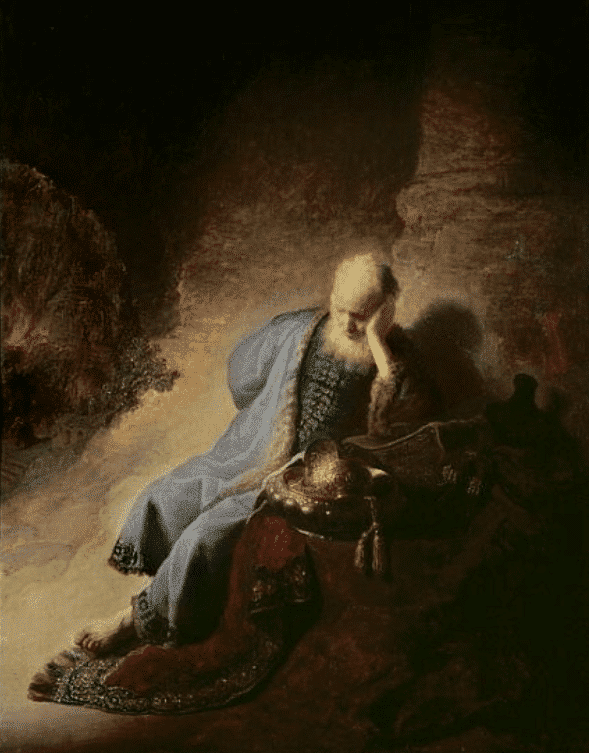
177 – Jeremiah Lamenting the Destruction of Jerusalem by Rembrandt van Rijn
“Jeremiah Lamenting the Destruction of Jerusalem,” painted by Rembrandt van Rijn in 1655, is a poignant work that captures the sorrow and desolation of the prophet Jeremiah after the fall of Jerusalem. The painting depicts Jeremiah seated, his face etched with pain and despair, surrounded by ruins and debris, in a state of intense mourning. Rembrandt, a master of chiaroscuro, uses light and shadow to heighten the dark and tragic atmosphere of the scene, emphasizing the prophet’s expressions and emotions.
The painting is notable for Rembrandt’s treatment of the emotional and psychological details of the character. Jeremiah’s face, illuminated by a soft but persistent light, expresses profound affliction, while the heavy shadows on the crumbling walls and surrounding elements underscore the apocalyptic nature of the scene. The brushstrokes and textures render the city’s devastation tangible, contrasting sharply with Jeremiah’s silent and solitary anguish.
“Jeremiah Lamenting the Destruction of Jerusalem” is a striking example of Rembrandt’s ability to capture moments of emotional intensity and psychological depth. By focusing on the human figure and its feelings rather than the setting, Rembrandt transforms a historical scene into a universal exploration of suffering and loss. The painting showcases the artist’s mastery in using light and shadow to convey complex themes, making it a powerful meditation on human pain and resilience.

178 – Pleasant Burden by William Bouguereau
“Pleasant Burden,” painted by William Bouguereau in 1891, exemplifies the artist’s mastery in representing realism and classical sensuality. The painting features a young woman carrying a basket filled with fruits, symbolizing abundance and fertility. The woman’s serene and slightly melancholic expression contrasts with the richness of the fruits she bears, highlighting the themes of beauty and effort within an idyllic setting.
Bouguereau, known for his meticulous attention to detail and skill in painting human figures, employs a palette of soft, natural colors to render both the texture of the fruits and the woman’s skin with remarkable precision. The natural light illuminating her face and clothing creates an effect of softness and warmth, enhancing the impression of tranquility and simplicity in the moment.
The title “Pleasant Burden” reflects the duality of the subject: the physical weight of the basket is softened by the beauty and joy that the fruits bring. Bouguereau explores the idea that even the most laborious tasks can be pleasant when accompanied by beauty and simple pleasures. The work illustrates Bouguereau’s approach to capturing the idealized aspects of daily life, offering an intimate and elegant portrait that celebrates both human grace and the splendor of nature.

179 – Greece on the Ruins of Missolonghi by Eugène Delacroix
“Greece on the Ruins of Missolonghi,” painted by Eugène Delacroix in 1826, is an emblematic work that expresses both the pain and grandeur of Greece during its war of independence against the Ottoman Empire. Created after the tragic siege of Missolonghi, the painting depicts an allegorical figure of Greece, portrayed as a grieving woman surrounded by the debris of the ruined city. The work is a poignant reflection on the resilience and suffering of the Greek people while celebrating their struggle for freedom.
Delacroix’s composition is characterized by vivid colors and dynamic brushstrokes, hallmarks of the Romantic style. The central figure of the woman, draped in flowing fabrics with arms outstretched in despair, contrasts sharply with the surrounding wreckage and ruins. Light plays a crucial role in the painting, illuminating the figure of Greece and enhancing the dramatic effect of the scene, while casting the ruins into a darkness that intensifies the sense of hopelessness.
In this work, Delacroix captures not only the tragic moment but also the dignity and nobility of Greece despite its suffering. “Greece on the Ruins of Missolonghi” is a powerful artistic statement that conveys the emotion and passion of the fight for independence. The painting, both symbolic and realistic, demonstrates Delacroix’s ability to blend dramatic and historical elements to create a deeply evocative and emotional work.
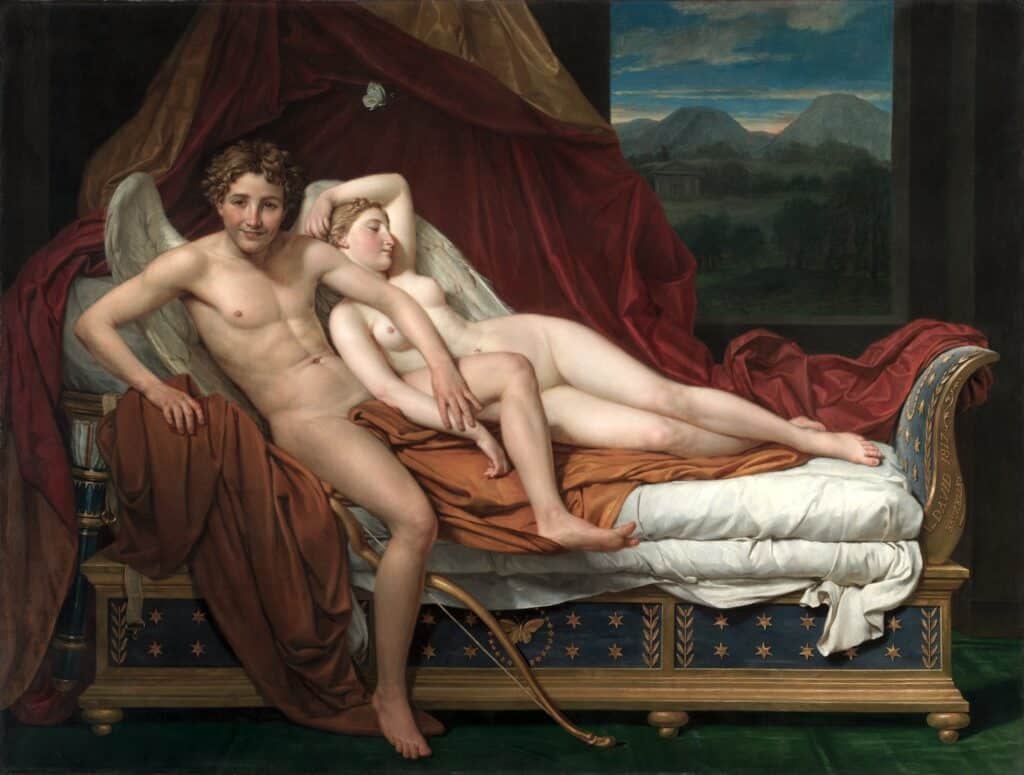
180 – Cupid and Psyche by Jacques-Louis David
“Cupid and Psyche,” painted by Jacques-Louis David in 1817, is a neoclassical masterpiece that depicts a pivotal moment from the ancient myth of Psyche and Cupid. The painting captures the scene where Psyche, having been reunited with Cupid after enduring numerous trials, is immersed in a moment of adoration and gratitude. The figures are portrayed with tender intimacy and sensuality, enveloped in lush draperies and bathed in soft light.
David, a master of neoclassicism, employs a rigorous composition and dramatic lighting to highlight the beauty and purity of the characters. The figures are rendered with anatomical precision, their expressions of tenderness and joy adding a profound emotional depth to the scene. Rich and harmonious colors create a romantic and dreamlike atmosphere, contrasting with the often darker themes of David’s earlier works.
“Cupid and Psyche” reflects David’s characteristic style, combining the rigor of neoclassicism with a romantic sensibility. The painting illustrates the era’s growing interest in mythological themes and idealized representations of love while showcasing David’s skill in rendering human emotions with great nuance. The work remains a celebration of love triumphing over obstacles and stands as a splendid example of neoclassical art evolving towards more personal and intimate portrayals.
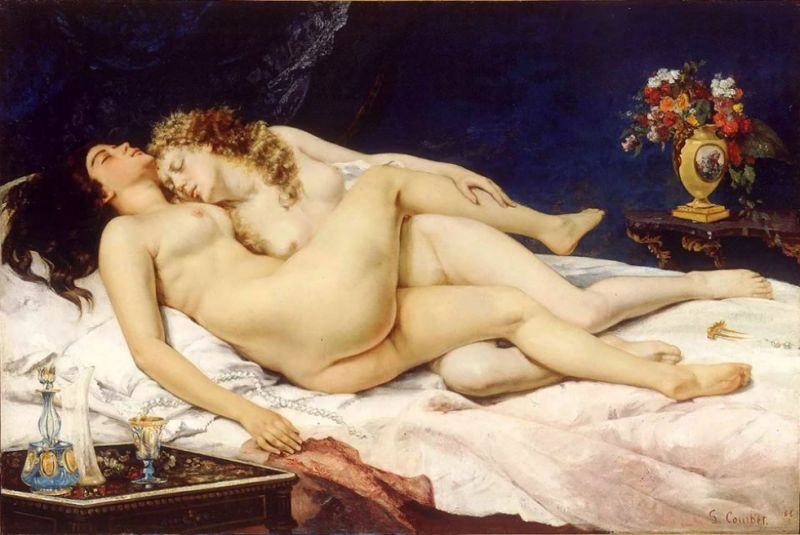
181 – Sleep by Gustave Courbet
“Sleep,” painted by Gustave Courbet in 1866, is a provocative and bold work that exemplifies the naturalism and sensuality of the artist. The painting depicts two nude women lying side by side in an intimately relaxed pose, asleep in a scene of erotic tranquility. Courbet, renowned for his realistic and often controversial depictions, captures the natural beauty of the female body with meticulous detail, emphasizing the curves and textures in a very explicit manner.
The painting is characterized by its rich color palette and expressive brushwork, highlighting the voluptuousness and sensuality of the figures. The soft light illuminating the women’s bodies enhances their forms and creates a contrast with the surrounding shadows, reinforcing the atmosphere of calm and intimacy. Courbet’s technique renders the details of the skin and drapery with a tactile realism, avoiding the excessive idealization often present in the academic works of the time.
“Sleep” elicited mixed reactions upon its release, frequently criticized for its candid depiction of nudity and sexuality. However, it is also celebrated for demonstrating Courbet’s audacious approach to the female nude and his commitment to uncompromising realism. The work embodies the tensions between classical art and the naturalism of the 19th century, offering an unfiltered view of beauty and humanity.
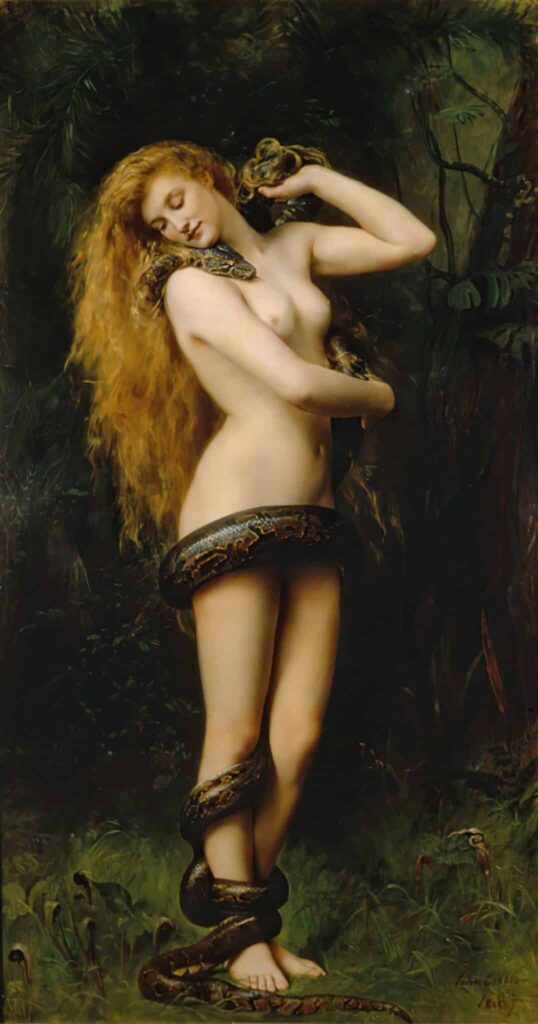
182 – Lilith by John Collier
“Lilith,” painted by John Collier in 1887, is a captivating work that delves into the mythological figure of Lilith, a character from Jewish and Mesopotamian traditions often associated with rebellion and sensuality. The painting depicts Lilith as a seductive and enigmatic woman, with long, dark hair entwined around a serpent. The atmosphere of the painting is both enchanting and unsettling, capturing Lilith’s duality as a figure of beauty and danger.
Collier, known for his detailed works and mythological themes, employs a rich color palette to highlight the textures and intricacies of the scene. The shades of green and red create a dark and intriguing ambiance, while the play of light accentuates the curves and details of Lilith’s body and the elaborate patterns of her surroundings. The serpent coiling around her symbolizes temptation and power, adding an additional layer of meaning to the composition.
“Lilith” is a fascinating representation of the mythological woman as a complex and ambivalent figure. The painting reflects Collier’s interest in mythological narratives and his skill in creating visually striking compositions imbued with significance. By capturing Lilith’s alluring beauty while emphasizing her menacing aspect, Collier offers a visual exploration of mythology and female psychology.

183 – Roman Girl at the Fountain by Léon Bonnat
“Roman Girl at the Fountain,” painted by Léon Bonnat in 1875, is a distinguished work known for its elegant and realistic portrayal of a young woman from ancient Rome. The painting depicts a young woman, dressed in a simple yet refined tunic, leaning to draw water from a fountain adorned with classical motifs. The scene exudes serenity and grace, capturing a daily moment from Roman life with meticulous attention to detail.
Bonnat, renowned for his skill in painting historical scenes and detailed portraits, uses a soft and natural color palette to create a tranquil and harmonious atmosphere. The gentle light that illuminates the woman’s face and body highlights the textures of her skin and garments while accentuating the architectural details of the fountain and its surroundings. The fluidity of the forms and the precision of the details demonstrate Bonnat’s mastery in representing both the natural and classical.
“Roman Girl at the Fountain” exemplifies Bonnat’s style, combining a realistic approach with a sense of classical composition and decor. The work celebrates the beauty and simplicity of daily life in ancient Rome, offering an elegant and idealized vision of femininity and antique culture. The painting is a testament to Bonnat’s ability to capture intimate moments with striking realism and artistic sensitivity.

184 – The Execution of Lady Jane Grey at the Tower of London, 1554 by Paul Delaroche
“The Execution of Lady Jane Grey at the Tower of London, 1554,” painted by Paul Delaroche in 1833, is a dramatic work that depicts the tragic moment of Lady Jane Grey’s beheading, the young deposed queen of England. The painting captures the scene with striking emotional intensity, showing Lady Jane Grey, still young and innocent, in her final moments before execution. The composition is marked by palpable tension and a dark atmosphere that emphasizes the tragedy of the situation.
Delaroche uses a sober color palette and dramatic lighting to highlight Lady Jane Grey’s central figure and the ominous shadows surrounding her. The scene is filled with meticulous details, from the expressions of the characters to the architectural elements of the Tower of London, contributing to the atmosphere of despair and gravity. The artist effectively conveys the depth of the historical drama and the psychological suffering of the young queen, while also underscoring the brutality of the execution.
“The Execution of Lady Jane Grey” is emblematic of Delaroche’s style, which combines historical realism with dramatic and emotional representation. By choosing to depict such a poignant event, Delaroche explores themes of justice, power, and human cruelty, offering a reflection on Lady Jane Grey’s tragedy and the political turmoil of her time. This painting is a powerful example of Delaroche’s ability to create historically accurate works while capturing the emotional dimension of the events he represents.

185 – Ophelia by Pierre-Auguste Cot
“Ophelia,” painted by Pierre-Auguste Cot in 1870, is a Romantic work that portrays a moment from Shakespeare’s famous tragedy, Hamlet. The painting depicts Ophelia, the young Danish princess, floating in the water surrounded by flowers after drowning in a stream. The image is imbued with a melancholic sweetness and ethereal beauty, capturing the tragedy of her fate with remarkable artistic sensitivity.
Cot, a master of the academic and Romantic styles, employs delicate colors and diffuse lighting to create a dreamlike and melancholic atmosphere. The composition is carefully balanced, with Ophelia lying in a graceful pose amid aquatic flowers that add an extra dimension to the scene. The details of her flowing garments and wet hair are rendered with precision, emphasizing the fragility and beauty of the central figure.
The painting offers a poignant portrait of the young woman, providing an idealized yet deeply emotive vision of her tragic death. By capturing both the beauty and sadness of this moment, Cot explores universal themes of loss and vulnerability while showcasing his talent for realistic and Romantic representation. “Ophelia” remains an iconic work of Romanticism, celebrating the beauty and tragedy of its subject with captivating visual and emotional intensity.
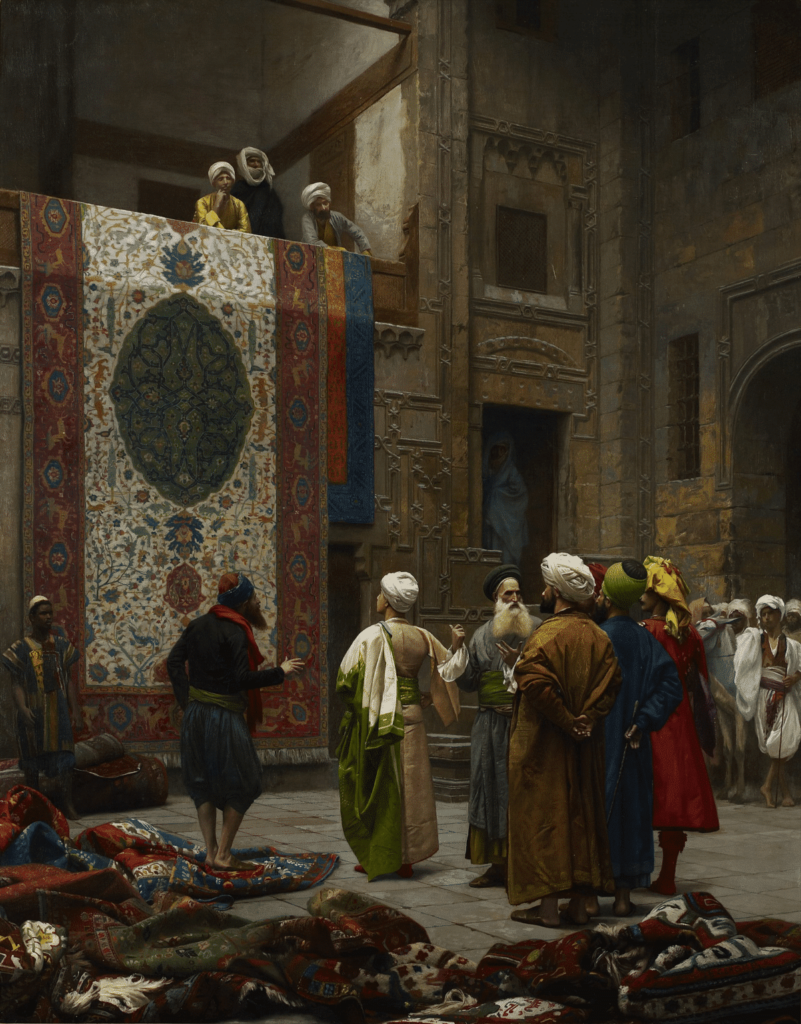
186 – Carpet Merchant in Cairo by Jean-Léon Gérôme
“Carpet Merchant in Cairo,” painted by Jean-Léon Gérôme in 1873, is a quintessential example of Orientalism, an art genre that explores Eastern cultures through often exotic and romanticized perspectives. The painting depicts a vibrant and animated scene of an Egyptian market, with a carpet merchant standing at the center, surrounded by an array of traditional carpets and other goods.
Gérôme, renowned for his meticulous attention to detail and impeccable realism, employs a rich and saturated color palette to render the textures and patterns of the carpets with remarkable precision. The market’s light, filtered through fabrics and objects, creates interplay of shadow and light that accentuates the depth and complexity of the scene. The characters, dressed in traditional costumes, add an authentic cultural dimension to the painting, depicted with a keen sense of detail and movement.
The painting showcases Gérôme’s talent for capturing the essence of Eastern markets while providing a romanticized and idealized view of daily life in Cairo. “Carpet Merchant in Cairo” reflects the 19th-century European fascination with exotic cultures, demonstrating Gérôme’s ability to merge keen observation with elaborate artistic composition. The work remains a major example of the Orientalist style, offering a fascinating glimpse into the East through the lens of Western art.

187 – Joan of Arc at the Coronation of Charles VII by Jean-Auguste-Dominique Ingres
“Joan of Arc at the Coronation of Charles VII,” painted by Jean-Auguste-Dominique Ingres in 1854, is a Neoclassical masterpiece that depicts a pivotal moment in French history: the coronation of Charles VII at Reims, with Joan of Arc playing a central role. The life-sized painting shows Joan of Arc in armor, portrayed as a heroic and emblematic figure, standing with dignity and strength during the historical ceremony.
Ingres, renowned for his precise style and idealized representations, uses a rich color palette and dramatic lighting to emphasize the solemnity and grandeur of the scene. The meticulous details of the royal robes, armor, and ornaments are rendered with remarkable precision, while the composition highlights Joan of Arc’s centrality. Joan’s figure is positioned to draw the viewer’s eye, underscoring her significance and her relationship with the king.
The painting not only reflects Ingres’ refined drawing technique but also his interest in historical and heroic themes. “Joan of Arc at the Coronation of Charles VII” celebrates Joan of Arc’s crucial role in French history and the idealization of the national hero and the majesty of the historical moment. The work is a striking example of Neoclassical style, blending historical accuracy with romantic idealization to create a powerful and emotive representation of a key event.
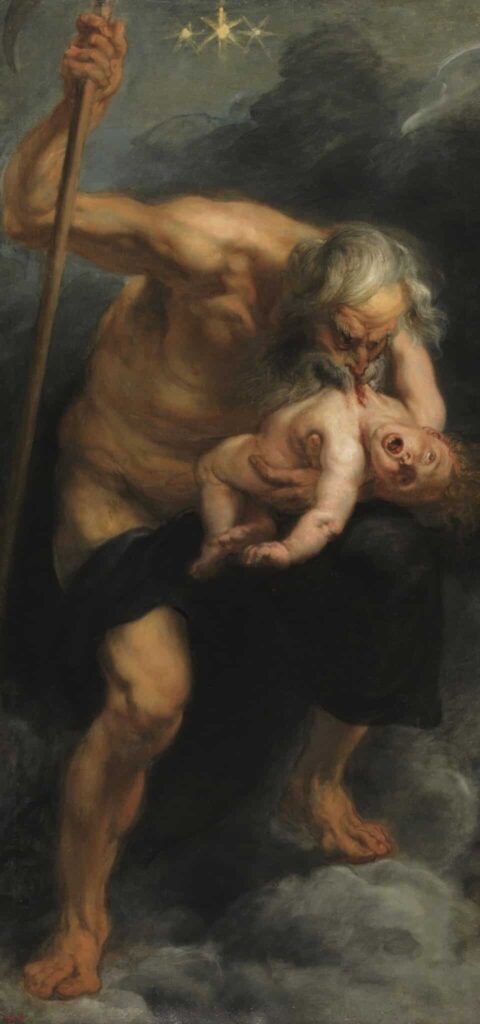
188 – Saturn by Peter Paul Rubens
“Saturn,” painted by Peter Paul Rubens around 1636-1638, is a powerful work that depicts the Roman myth of Saturn (or Cronos in Greek mythology). The dramatic painting shows Saturn devouring one of his children, an emblematic act that symbolizes his fear of losing power and the anxiety of the prophecy that one of his descendants would overthrow him.
Rubens, renowned for his dynamic use of color and movement, captures the scene with the intense emotion and expressiveness characteristic of his Baroque style. The artist employs contrasts of light and shadow to highlight Saturn’s muscular form and the brutality of his act, while the rich colors and vigorous brushstrokes convey a sense of movement and turbulence. Saturn’s wild features and frenzied posture are both captivating and disturbing, underscoring the horror of the myth.
The painting is a striking example of Rubens’ ability to handle mythological subjects with emotional depth and visual power. “Saturn” explores themes of violence, power, and destiny, offering a dramatic interpretation of classical mythology through the lens of Baroque art. This work demonstrates Rubens’ skill in combining drama and technical virtuosity to create visually and emotionally impactful representations.

189 – The Anatomy Lesson of Dr. Nicolaes Tulp, 1632 – Rembrandt van Rijn
“The Anatomy Lesson of Dr. Nicolaes Tulp,” painted by Rembrandt van Rijn in 1632, is a seminal work from the early part of the Dutch master’s career, depicting a public dissection led by Dr. Nicolaes Tulp, a renowned anatomist and physician in Amsterdam. The painting captures a detailed and precise anatomy lesson where Dr. Tulp, surrounded by his colleagues, demonstrates the musculature of the human arm using a recently dissected cadaver.
Rembrandt employs his signature chiaroscuro technique to create a dramatic contrast between light and shadow, highlighting Dr. Tulp and his group in a manner that enhances the intensity of the scene. The soft light illuminating the faces and anatomical details underscores the precision of the anatomical observations, while creating an atmosphere of focus and reverence for science. The expressions of the participants range from curiosity to concentration, capturing the seriousness and commitment to learning.
The painting is not only a testament to Rembrandt’s technical skills in portraiture and anatomical detail but also a reflection of the scientific and medical culture of the time. “The Anatomy Lesson of Dr. Nicolaes Tulp” is a masterful example of Rembrandt’s ability to blend scientific realism with sophisticated artistic composition, offering a fascinating glimpse into the world of 17th-century medicine while showcasing his talent for human representation and visual storytelling.

190 – The Rape of the Daughters of Leucippus – Peter Paul Rubens
“The Rape of the Daughters of Leucippus,” painted by Peter Paul Rubens around 1618-1620, is a striking example of the Baroque master’s dramatic and mythological storytelling. This painting captures the moment from Greek mythology when the Dioscuri, Castor and Pollux, abduct the daughters of Leucippus, Phoebe and Hilaeira, in a scene filled with dynamic movement and intensity.
Rubens, renowned for his energetic style and mastery of chiaroscuro, presents the scene with impressive visual intensity. The composition is tumultuous, with the figures depicted in a fluid, almost chaotic arrangement, capturing the violence and passion of the mythological event. The rich color palette—vivid reds, deep blues, and golden hues—emphasizes both the sensuality and the force of the scene, while highlighting the intricate details of the drapery and musculature.
The painting exemplifies Rubens’s Baroque style, characterized by complex composition and dramatic use of light to create depth and movement. “The Rape of the Daughters of Leucippus” demonstrates Rubens’s ability to transform mythological narratives into vibrant and emotionally charged scenes, offering a glimpse into the passion and drama of the legend through the lens of Baroque art. The work also reflects Rubens’s interest in mythological themes and powerful representations of strength and beauty.
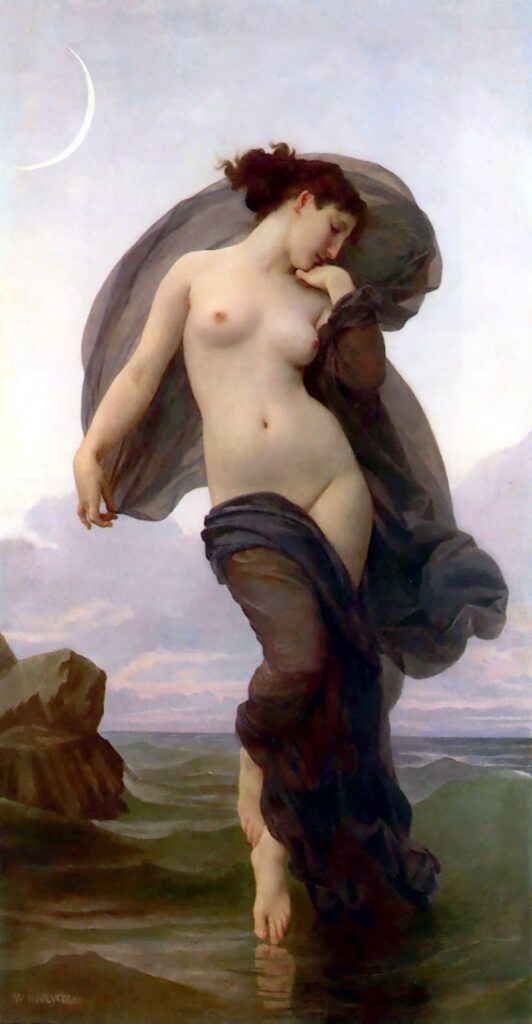
191 – Twilight Mood – William Bouguereau
Twilight Mood, also known as Crépusculaire or Du Soir, painted by William Bouguereau in 1880, is a compelling work that captures the serenity and melancholy of dusk. The painting portrays a young woman seated in a tranquil landscape at twilight, surrounded by soft, soothing colors that reflect the gentle light of the evening.
Bouguereau, renowned for his exquisite realism and meticulous technique, uses delicate hues and diffused light to create an atmosphere of calm and introspection. The young woman, depicted with remarkable precision in her anatomical details and drapery, seems lost in thought, embodying the essence of solitude and personal reflection at twilight. The golden and rosy tones of the sky are echoed in the colors of her skin and clothing, enhancing the painting’s serene ambiance.
Twilight Mood exemplifies Bouguereau’s skill in blending realistic representation with emotional depth. The work highlights his talent for capturing the subtle beauty of nature and everyday moments with exceptional elegance and accuracy. The painting evokes a profound sense of peace and tranquility, showcasing Bouguereau’s ability to use light and color to create an atmosphere of softness and depth.
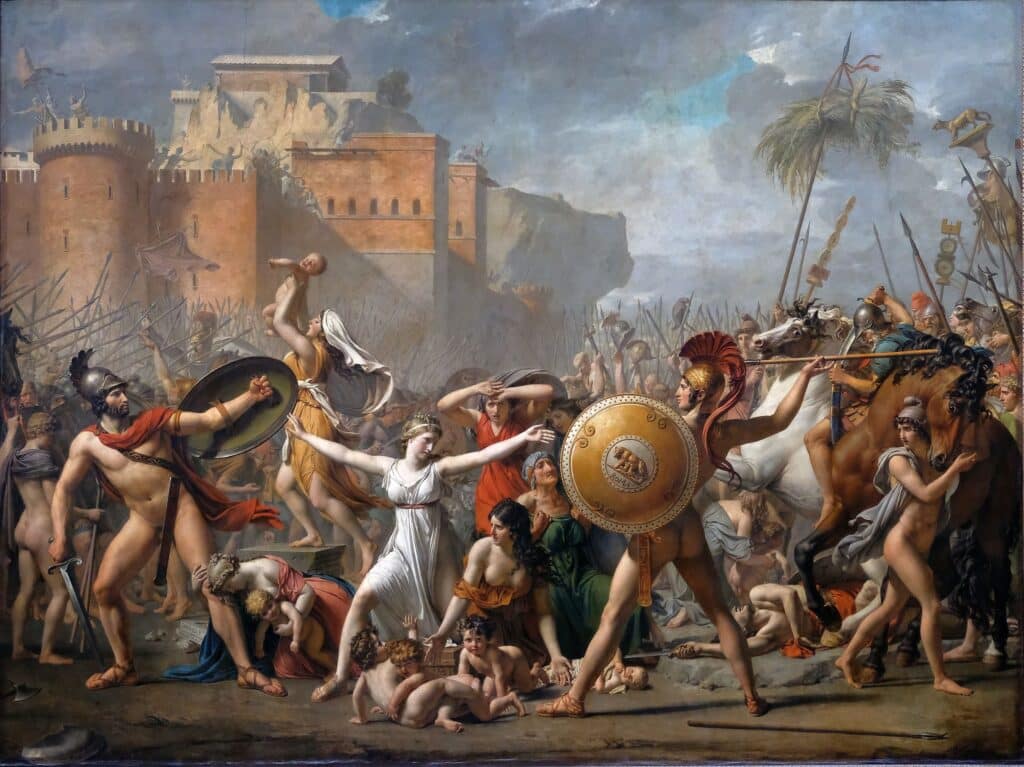
192 – The Intervention of the Sabine Women – Jacques-Louis David
The Intervention of the Sabine Women, painted by Jacques-Louis David in 1799, is a quintessential work of Neoclassicism that dramatically and strikingly depicts a Roman mythological episode. The painting illustrates a scene from the legend of the Sabine women, who intervene to reconcile their Roman husbands with their own families after a war erupted following the abduction of the Sabine women by the Romans. The central scene shows the women courageously stepping between the two factions to halt the violence and restore peace.
David, a master of the Neoclassical style, employs a dynamic composition and meticulous attention to detail to heighten the tension and drama of the scene. The figures are rendered with remarkable anatomical precision, their expressions and postures conveying intense emotion and symbolic significance. The color palette is both vibrant and controlled, with contrasts of light and shadow emphasizing the key elements of the composition and the interactions among the characters.
The Intervention of the Sabine Women celebrates courage and sacrifice, reflecting Neoclassical ideals of virtue and patriotism. The painting also showcases David’s talent for capturing historical and mythological moments with visual and emotional intensity. By combining a faithful representation of legendary events with a deep sense of drama and grandeur, David presents a work that remains emblematic of Neoclassicism and its commitment to heroic and moral depiction.
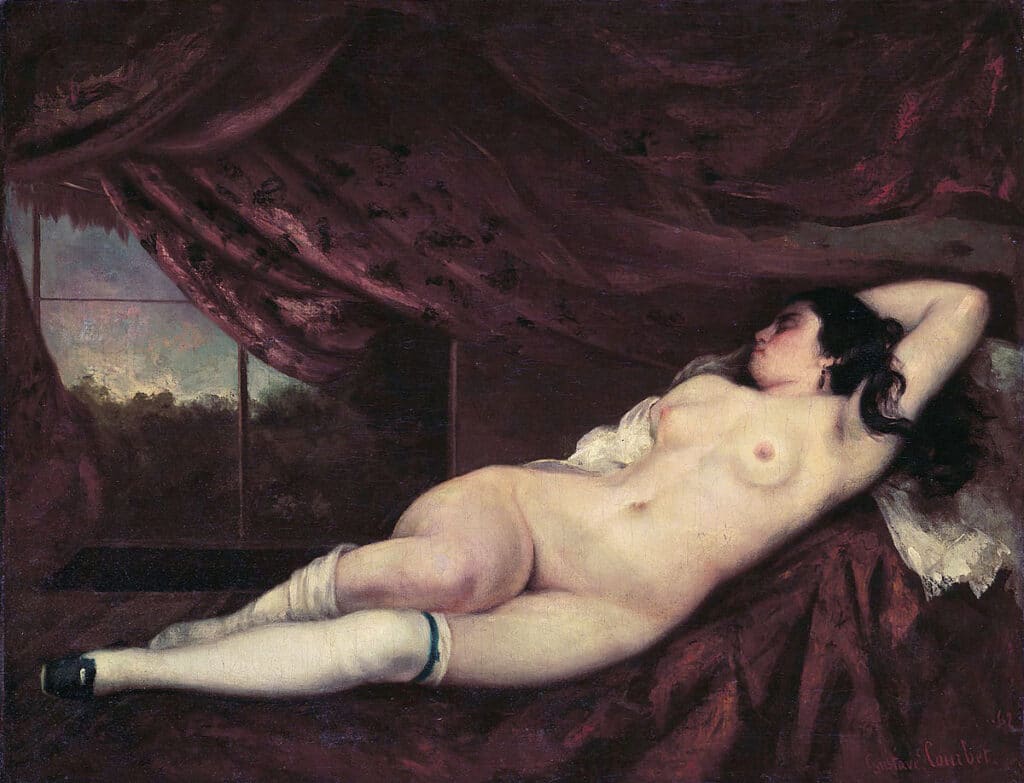
193 – Nude Woman Reclining – Gustave Courbet
Nude Woman Reclining, painted by Gustave Courbet in 1866, is a quintessential example of Realism, distinguished by its direct and unidealized portrayal of the female body. The painting depicts a nude woman lying on a bed or similar surface, in a posture of relaxation and repose. Courbet adopts a candid and detailed approach to capture the form and texture of the body, emphasizing material truth over classical idealization.
The composition is marked by an earthy and natural color palette, with lighting that realistically highlights the shapes and contours of the body. The woman’s skin is rendered with great precision, and the details of the drapery and bed contribute to the sense of realism and tangibility. Courbet’s characteristic style provides an honest and straightforward view of the female form, diverging from the artistic conventions of the time that favored more idealized and stylized representations.
Nude Woman Reclining is a clear demonstration of Courbet’s commitment to Realism and his desire to represent life as it is, without embellishment. The work elicited mixed reactions in its time, often criticized for its frank depiction of nudity. Nonetheless, it remains a significant work for its innovative approach and its contribution to the discourse on the representation of the body in art. Through this painting, Courbet invites viewers to reflect on the nature of beauty and truth in art.

194 – The Young Christian Martyr – Paul Delaroche
The Young Christian Martyr, painted by Paul Delaroche in 1855, is a poignant work that illustrates the beauty and tragedy of Christian martyrdom through the lens of historical realism. The painting depicts a young Christian woman, bound in chains and prepared to face martyrdom for her faith. The scene is imbued with gravity and compassion, capturing the moment before her execution with striking emotional intensity.
Delaroche, renowned for his detailed historical works and dramatic representations, employs a subdued color palette and nuanced lighting to enhance the softness and dignity of the central figure. The soft light illuminating the young martyr’s face and the details of her clothing contrasts with the surrounding darkness, highlighting the serenity and resignation in her expression. The meticulous details, from the chains to the folds of her garments, are rendered with great precision, underscoring Delaroche’s technical mastery and his ability to capture the emotional truth of the subject.
The painting reflects on themes of faith, suffering, and courage, while also showcasing Delaroche’s interest in historical narratives and heroic figures. The Young Christian Martyr exemplifies Delaroche’s commitment to depicting moments of profound emotional intensity with historical accuracy and artistic sensitivity. The work invites viewers to contemplate strength and grace in the face of adversity, offering a glimpse into 19th-century art’s pursuit of historical truth and human emotion.
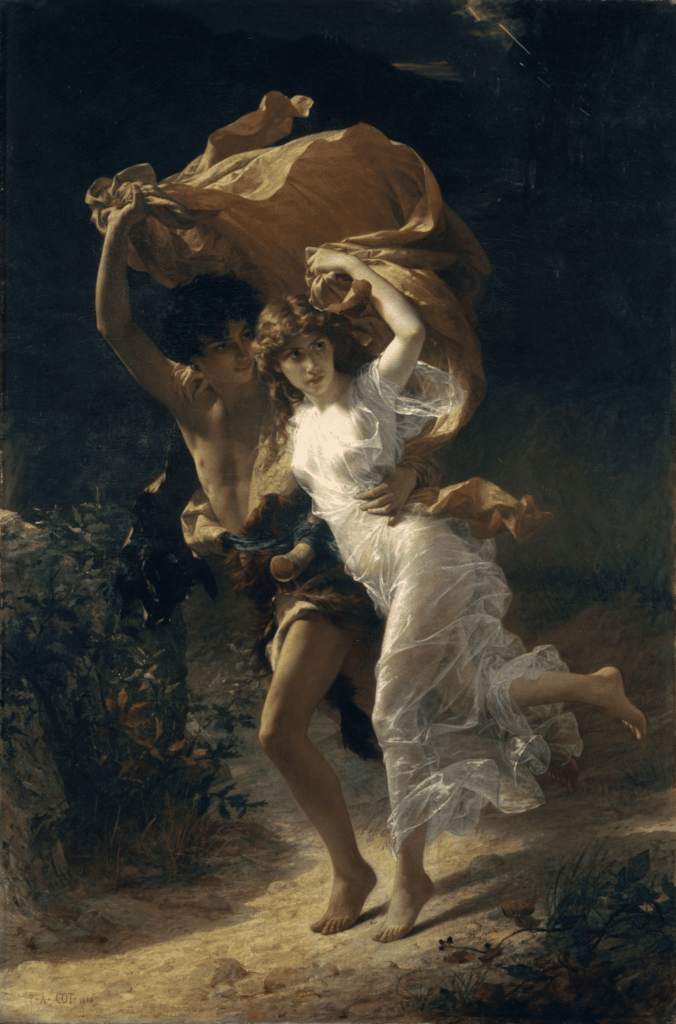
195 – The Storm – Pierre-Auguste Cot
The Storm, painted by Pierre-Auguste Cot in 1872, is a Romantic masterpiece that captures a dramatic and emotive moment set in a natural environment. The painting depicts a young couple caught in a storm, their poses and expressions conveying the power and immediacy of the crisis surrounding them. This work is renowned for its dynamic portrayal of natural elements and human emotions.
Cot employs a vivid and contrasting color palette to convey the energy and movement of the storm. The swirling clouds, tumultuous waves, and wind whipping through the couple’s hair create an atmosphere of tension and chaos. The couple, rendered with meticulous detail, are partially draped in flowing garments, emphasizing the force of the wind and the turbulence of the scene. Their expressions reflect both fear and passion, offering a poignant contrast to the storm’s violence.
Cot’s mastery in depicting movement and light is particularly evident in this work. The Storm is a prime example of his talent for capturing dramatic moments with emotional sensitivity and technical virtuosity. The painting not only reflects the Romantic style, with its themes of passion and wild nature, but also showcases Cot’s ability to create visually striking and emotionally powerful compositions.
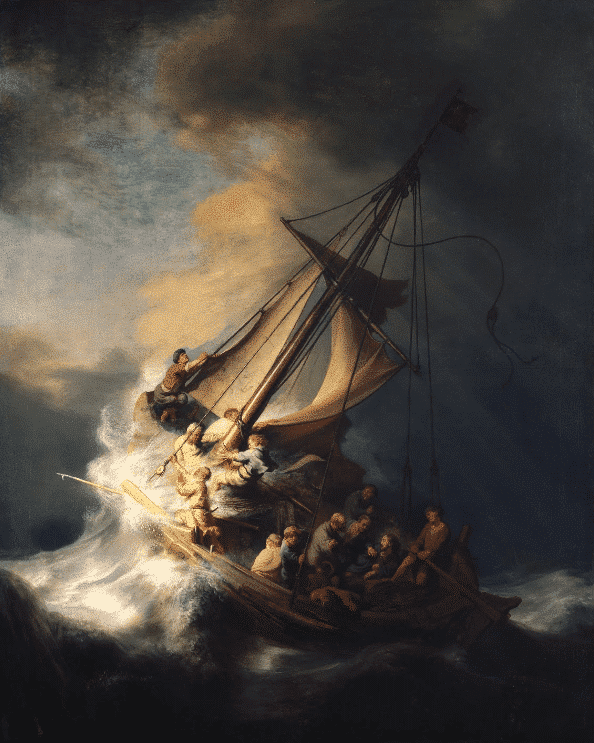
196 – Christ in the Storm on the Sea of Galilee – Rembrandt van Rijn
Christ in the Storm on the Sea of Galilee, painted by Rembrandt van Rijn in 1633, is a significant work by the Dutch master that depicts a dramatic episode from the New Testament. The painting illustrates the biblical scene where Jesus calms the storm on the Sea of Galilee while his terrified disciples desperately seek his help. The work is notable for its powerful portrayal of the contrast between the storm’s fury and Jesus’s divine serenity.
Rembrandt employs his renowned chiaroscuro technique to create a dramatic effect, using light to highlight the expressions and gestures of the characters. The light illuminates Jesus’s face, whose calm presence contrasts with the surrounding chaos. The turbulent waves, lightning, and rain are rendered with a dynamism and visual intensity that emphasize the storm’s force, while the disciples’ figures, often blurred and in motion, enhance the sense of desperation and panic.
The composition of the painting is balanced, with a strong sense of space and movement. The details of the waves and lightning are treated with great precision, while the characters’ expressions capture a wide range of emotions, from fear to awe. Christ in the Storm on the Sea of Galilee exemplifies Rembrandt’s ability to blend dramatic storytelling with technical mastery, creating a work that is both visually striking and profoundly emotive. The painting remains a fascinating exploration of themes such as faith, power, and redemption through Baroque art.
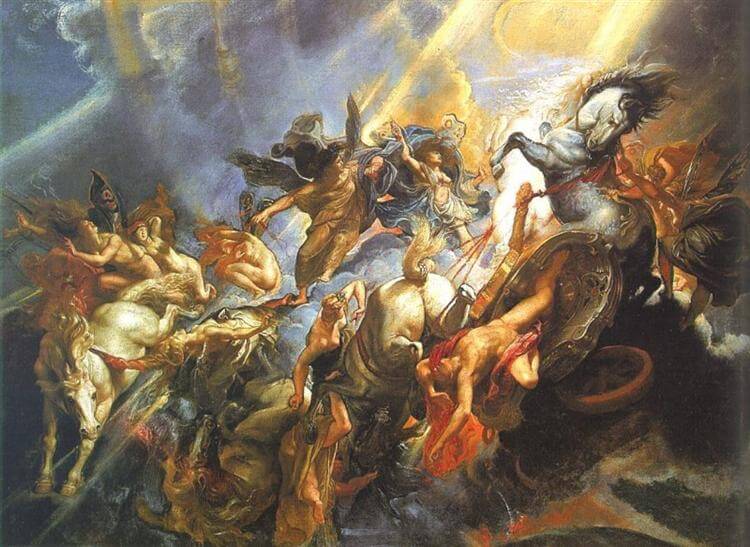
197 – The Fall of Phaethon – Peter Paul Rubens
The Fall of Phaethon, painted by Peter Paul Rubens around 1604-1605, is a powerful work that captures a tragic moment from Greek mythology. The painting depicts the fall of Phaethon, the son of the sun god Helios, who attempted to drive his father’s sun chariot across the sky but lost control, causing a cosmic disaster. The scene is rendered with dramatic intensity and dynamism characteristic of Rubens’s Baroque style.
Rubens uses a complex composition and dramatic lighting to accentuate the movement and violence of the scene. The sun chariot, drawn by panicked horses, is portrayed in a whirlwind of chaos, while Phaethon, fallen and desperate, plummets from the sky in a posture of anguish. The horses’ bodies and the details of the fiery clouds are depicted with energy and precision, emphasizing the tumult and grandeur of the moment. The vivid colors and stark contrasts add an additional dimension to the scene, enhancing its visual and emotional impact.
The painting exemplifies Rubens’s ability to transform mythological narratives into visually spectacular and emotionally charged works. The Fall of Phaethon showcases his talent for dynamic movement and his mastery of light and color to create dramatic effects. The work remains a striking illustration of themes such as fate, divine power, and cosmic chaos, offering a compelling view of mythology through the lens of Baroque art.

198 – The Virgin with Angels – William Bouguereau
The Virgin with Angels, painted by William Bouguereau in 1900, is an iconic example of 19th-century academic realism, distinguished by its delicate and idealized portrayal of the Virgin Mary surrounded by angels. The painting reflects Bouguereau’s mastery in creating harmonious compositions and figures imbued with softness and serenity.
The composition highlights the Virgin Mary in a graceful pose, surrounded by young angels who gaze at her with admiration. Bouguereau employs a soft color palette and diffused light to create an atmosphere of peace and divinity. The faces of the figures are rendered with great precision, their expressions reflecting purity and gentleness. The details of the drapery and textures are painted with meticulous care, showcasing the artist’s technical virtuosity and commitment to exquisite realism.
The painting is a perfect illustration of Bouguereau’s style, combining realistic and detailed representation with an idealized and spiritual vision. The Virgin with Angels is not only a celebration of divine beauty and grace but also an example of Bouguereau’s ability to blend impeccable technique with emotional expression, creating a deeply touching and visually captivating work.

199 – Mars Disarmed by Venus – Jacques-Louis David
Mars Disarmed by Venus, painted by Jacques-Louis David in 1824, is a neoclassical work that explores a mythological theme with elegant composition and emotional depth. The painting depicts Mars, the god of war, being disarmed and pacified by Venus, the goddess of love. This scene, inspired by classical legends, serves as a metaphor for the triumph of love over violence and conflict.
David employs a balanced composition and refined color palette to create an atmosphere of peace and harmony. Mars, depicted in armor, is shown in a vulnerable posture, his gaze directed toward Venus, who gently and authoritatively removes his weapons. The soft light illuminating the figures highlights their expressions and forms with great precision, while the details of the drapery and textures add visual richness to the scene.
The painting exemplifies David’s skill in blending mythological narrative with neoclassical aesthetics. Mars Disarmed by Venus reflects the ideals of neoclassicism with its emphasis on clear forms and heroic representation of characters, while also offering a meditation on themes of love and peace. The work captures a sense of romance and grandeur while remaining true to the rigor and elegance of the neoclassical style.

200 – The Youth of Samson – Léon Bonnat
The Youth of Samson, painted by Léon Bonnat in 1860, is an academic-style work that depicts a moment from the life of the biblical hero Samson. The painting represents the young Samson, already demonstrating prodigious strength, in a scene that captures both his physical power and heroic potential.
Bonnat uses a powerful composition to highlight Samson’s imposing stature, with well-defined muscles and a dynamic posture emphasizing his role as a hero. The color palette is rich, featuring warm, earthy tones that enhance the robustness and vitality of the central figure. The meticulous details of the drapery and textures contribute to the visual realism of the work, showcasing Bonnat’s technical mastery.
The painting is a demonstration of Bonnat’s ability to combine precise, idealized representation with strong visual narrative. The Youth of Samson merges elements of realism with heroic touches to create a work that is both visually striking and rich in mythological significance. The piece illustrates the dramatic potential of the Samson figure while reflecting the academic and artistic ideals of the period.

Bonus 1 – Spring – Pierre-Auguste Cot
Spring, painted by Pierre-Auguste Cot in 1873, is a quintessential example of 19th-century Romanticism and academic realism. The painting portrays a young couple basking in the blossoming of spring, capturing a moment of tenderness and romance in an idyllic natural setting.
Cot employs a palette of fresh, bright colors to convey the lightness and beauty of spring. The figures are depicted in a tender, intimate pose, with the young woman embraced by the young man, symbolizing love and youth. The soft light illuminating the figures and the intricate details of their clothing and the surrounding landscape enhance the sensitivity and refinement of the scene. The flowers and foliage in the background add a lively, springtime touch, creating an atmosphere of joy and renewal.
Cot’s technical mastery is evident in the meticulous details and the fluidity of the forms, demonstrating his skill in capturing moments of natural and emotional beauty with great precision. Spring is a perfect example of Cot’s commitment to representing romance and natural beauty with the elegance and sensuality characteristic of his work. The painting remains a celebration of spring and youth, offering a poetic and charming vision of these themes.

Bonus 2 – Portrait of Dr. Alphonse Leroy – Jacques-Louis David
Portrait of Dr. Alphonse Leroy, painted by Jacques-Louis David in 1793, is an emblematic work that highlights the artist’s Neoclassical style while featuring a prominent figure in medicine of the time. The portrait depicts Dr. Alphonse Leroy, a renowned physician known for his contributions to medicine during the French Revolution.
David, renowned for his mastery of portraits and meticulous compositions, uses a restrained color palette and a carefully balanced composition to capture the essence of his subject. Dr. Leroy is portrayed in a bust-length pose, depicted with dignity and introspection, with details that emphasize his professionalism and authority. The physician’s gaze is both determined and serene, conveying a sense of competence and calm.
The painting is characteristic of David’s Neoclassical style, with particular attention to the details of clothing, medical accessories, and the face, reflecting the artist’s commitment to realistic representation and the dignity of the subject. Portrait of Dr. Alphonse Leroy not only serves as a tribute to a distinguished individual but also exemplifies David’s skill in capturing characters with emotional intensity and technical precision. The work represents a fusion of art and science, providing a visual insight into Dr. Leroy’s stature and significance in his field.
Conclusion on the 200 Most Famous Paintings in Art History
The 200 most famous paintings in art history offer a fascinating journey through the ages, revealing the richness and diversity of artistic expression across centuries. These major works, ranging from timeless classics to innovative masterpieces, embody the creative genius of artists who have shaped the history of art and influenced generations.
Each of these paintings has contributed to shaping our understanding of art and culture, capturing historical moments, universal emotions, and unique visions. They stand as testaments to human creativity and the ability of art to transcend time and space.
We would love to hear your thoughts! Which painting among these 200 resonates with you the most? Is there a work you believe should be included in this prestigious list? Leave us a comment and share your favorite painting or suggest a work that you think deserves recognition among the greatest masterpieces in art history. Your perspective is valuable and helps enrich our collective appreciation of art.

